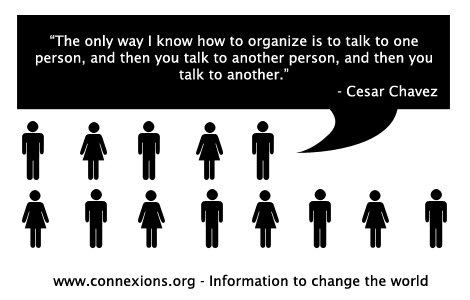
Ulli Diemer — Radical Digressions
Blogs & Notes
- Notebooks: 10 - 9 - 8 - 7 - 6 - 5 - 4 - 3 - 2 - 1
- Latest Post
- Moments
- Quotes & Fragments
- Scrapbook
- Twitter @ullidiemer
Articles Lists
- Selected Articles
- Articles in English
- Articles in French
- Articles in Spanish
- Articles in German
- Articles in Other Languages
- Articles A-Z
- Subject Index

Compilations & Resources
- Connexions
- Other Voices newsletter
- Seeds of Fire
- Alternative Media List
- Manifestos & Visions
- Marxism page
- Socialism page
- Organizing Resources
- People’s History, Memory, Archives
- Connexions Quotations
- Sources
- What I’ve been reading
- What I’ve been watching
Selected Articles
- The main enemy is at home
- Terry Fox & the Marathon of Hope
- Intelligence of Ravens
- Faith, Hope and Persistence
- Massacres and Morality
- Karl Marx
- Rosa Luxemburg
- Medicare Myths and Realities
- One Vote for Democracy
- Dances with Guilt: Looking at Men Looking at Violence
- Neoliberalism and state capitalism
- National Post columnist traumatized by having to wait his turn
- Free speech” – as long as it doesn’t offend anyone
- Inclusion or exclusion?
- Let’s Stop Kidding Ourselves About the NDP
- My politics in brief
- Abandoning the public interest
- On Self-Determination
- Contamination: The Poisonous Legacy of Ontario’s Environmental Cutbacks
- More Articles...
Selected Topics
- Alternative Media
- Bullshit
- Censorship
- Chess
- Civil Liberties
- Collective Memory
- Community Organizing
- Consensus Decision-making
- Democratization
- Double Standards
- Drinking Water
- Free Speech
- Health Care
- History
- Identity Politics
- Interviews & Conversations
- Israel/Palestine
- Libertarian Socialism
- Marxism
- Men’s Issues
- Moments
- Nature
- Neo-Liberalism
- New Democratic Party (NDP)
- Obituaries & Tributes
- Political Humour/Satire
- Public Safety
- Self-Determination
- Socialism
- Revolution
Radical Digressions
Ulli Diemer’s Website
Radical Digressions (www.diemer.ca) is my personal website. Recent items are on, or linked from, the home page. My “notebooks” form the main part of the site. Arranged chronologically, they comprise a mixed bag of articles, observations, letters, book reviews, links, images, etc. To find particular items, try the subject index, or the indexes of writings in English and other languages. I also manage the Connexions website, and much of my work appears there. For more information, see the About page.
- Ulli Diemer
Other Voices, March 3, 2024
March 3, 2024 - #
The March 3, 2024 edition of Other Voices, the Connexions newsletter, which I edit, is now out. You can see it online here. I wrote an introduction to the issue; it appears below:
Drowning in a Sea of Lies
There are other words for it, of course. Narrative Control. Message Management. PR. Framing. Spin. Disinformation. Media Bias. Hasbara. Corporate Communications. Mainstream Journalism. Propaganda.
But plainly put, it’s Lies, Lies, and more Lies. Lies are the lifeblood of the world we live in. The American-dominated international order is rooted in violence and exploitation, but lies are its language, its public face, and its spiritual essence.
The American novelist Mary McCarthy once said, [of someone who supported Stalin’s show trials] “Every word she writes is a lie, including ‘and’ and ‘the’.”
She might well have been speaking of today’s mainstream media, both its corporate-owned and state-funded varieties. What McCarthy was saying was not, of course, that literally every word was a lie in and of itself, but that even factual statements become part of a lie when they are included in a story whose main premise a flagrant lie. Spelling a prisoner’s name correctly, and getting the date of their execution right, is irrelevant when the story falsely says that they were guilty of a crime they didn’t commit. Faux-accuracy around minor details merely adds an aura of credibility to the lies being peddled as truth.
The most effective purveyors of lies are precisely the ‘quality’ media, like the New York Times, the Washington Post, the Globe and Mail, Associated Press, the BBC, CNN, and the CBC, which are at pains to foster the illusion that they are committed upholding the highest journalistic standards. When it comes to covering stories in which the interests of the Empire are not at stake, they can indeed often be relied on to present a relatively accurate version of the facts. If the Toronto Star or the CBC tell you that a truck full of cabbages overturned and spilled its contents, you can assume, with a high degree of probability, that there were in fact cabbages rolling on the highway.
If they tell you that the U.S. is bombing some country to enforce the ‘rules-based international order,’ you can take it as a certainty that they are lying. Not lying about the bombing – the U.S. bombs some country or other pretty much every day of the year; what would be really newsworthy would be a day on which they didn’t bomb anybody – but lying about the reason for the bombing.
The very phrase ‘rules-based international order’ is an example of a lie concocted to mislead the public. It was invented as an alternative to ‘international law’ to draw attention away from the inconvenient fact that the U.S. and its NATO allies constantly violate international law. The purely ideological and content-less concept of ‘rules-based international order’ was invented to sound good while disguising the fact that there are no rules except those imposed by the United States. The essence of the ‘rules-based international order’ can be stated in three words: ‘Obey or Die.’
In fact, the true meaning of all the empty phrases about ‘democratic values’ and ‘human rights’ and ‘freedom’ and the ‘rule of law’ can now be summarized in one word: Gaza.
In Gaza, the world watches as day after day, the Israeli Defence Force, the army that even now obscenely proclaims itself ‘the most moral army in the world,’ commits genocide. And Israel’s allies – more accurately, its accomplices in mass murder – ship weapons and money to Israel, and block attempts in the United Nations to stop the killing.
Among the accomplices in this genocide are the ‘mainstream’ media who continue to spin lies and defend the indefensible. Still, it is important to point out that there are journalists who are working, at great personal risk, to report what is really going on. Many have paid with their lives, because Israel, as it has always done, deliberately targets journalists for killing. CNN’s pro-Israel, pro-genocide coverage has been so horrible that CNN journalists are posting anonymous reports on social media to refute CNN’s lies and distortions. The mainstream media are very bad, but not everyone who works there is bad.
Still, the bottom line is that the mainstream media are purveyors of poison. There is a case to be made for avoiding them as much as possible, and getting one’s news from alternative media websites and trusted individual commentators. They are out there. Some are listed in this newsletter, others can be find via the Alternative Media List on the Connexions website. Bookmark the sites you find valuable in your browser. Sign up for their mailing lists; they’ll send you an email when they publish something new.
Spring is coming. If you are still consuming unhealthy quantities of the mainstream media’s toxic offerings, perhaps it’s time to turn over a new leaf.
Ulli Diemer
March 1, 2023
Covered Bridge
March 2, 2024 - #
It feels tone-deaf to worry about small local misfortunes it the midst of a genocide. So I have mixed feelings about even mentioning the fact that the Covered Bridge Potato Chip plant near Hartland, New Brunswick burned down this morning. It’s completely destroyed.
The people who worked there are out of a job – but alive! – and I will no longer be able to buy my favourite potato chips. But I can buy as much food as I want, anytime I want, and no one will kill me while I’m attempting to do so, unlike the more than 100 people who were massacred by the Israeli military a couple of days ago while waiting to get desperately needed food from food aid trucks.
Meanwhile, the Saint John River continues to flow under the covered bridge in Hartland, a place that holds special memories for me. I think that matters too, even in a time of genocide.
The photo is of the Saint John (Wolastoq) River near Hartland.
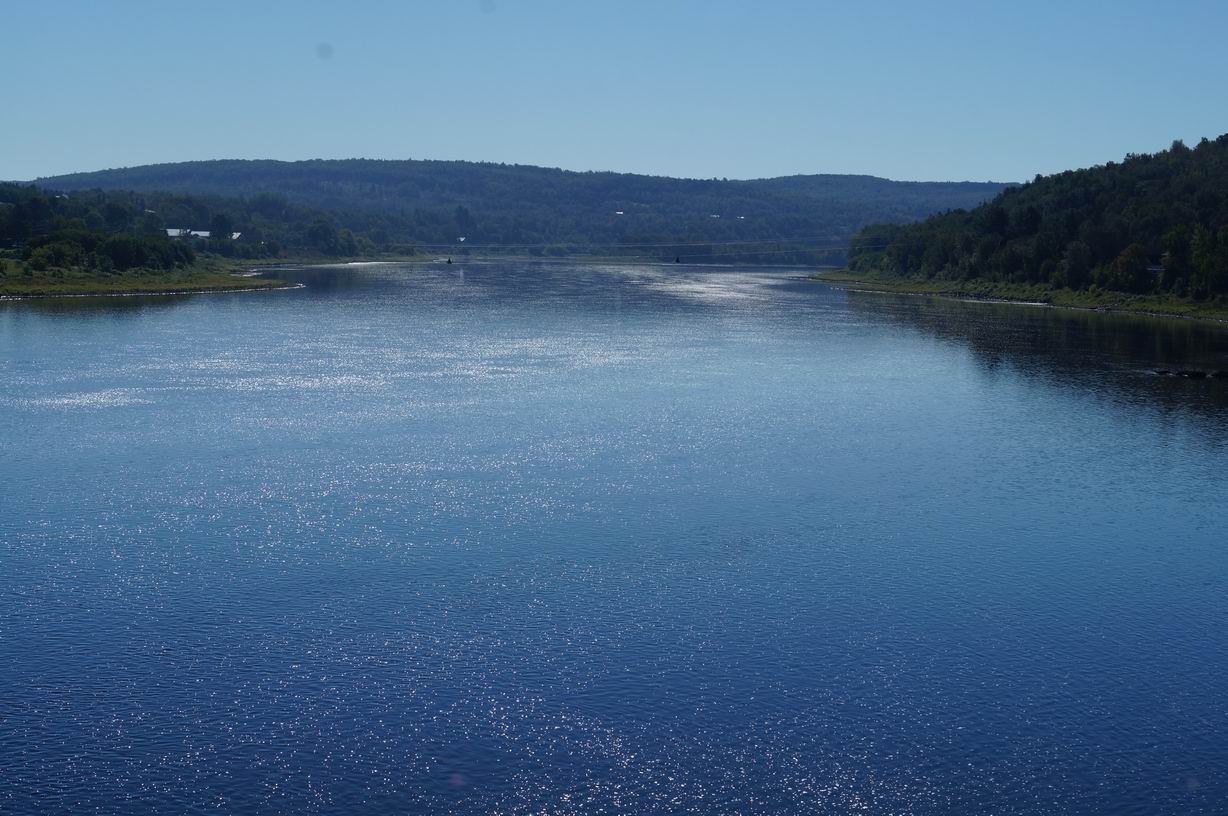
Toward the Light Other Voices, December 2, 2023
December 2, 2023 - #
The December 2, 2023 edition of Other Voices, the Connexions newsletter, which I edit, is now out. You can see it online here.
In the northern hemisphere, the approach of the Winter Solstice brings the darkest days of the year. This year, we are experiencing not only the long nights associated with the earth’s annual dance with the sun, but a deeper and more tragic darkness arising from the inhuman actions of some of our fellow humans. We live in a world where the most powerful states not only refuse to condemn genocide, but actively condone it.
The dark days of the Solstice have been a time of festivals and celebrations for thousands of years. Our ancestors knew that the darkness would be followed by the return of the light. The days would get longer, the icy days of winter would run their course, spring would come, plants would bloom. And so there were celebrations: Yule, Yalda Night, Dies Natalis Solis Invicti, Dongzhi, Inti Raymi, Saturnalia. The date for Christmas was chosen in part to align with existing Solstice festivals. The celebrations, whatever they called, were an occasion to come together and collectively assert our joy in knowing that the sun would return and bring with it the light that would nurture future life.
Most of us no longer celebrate the ancient festivals, but many of us – countless thousands – have been asserting our own desire and determination to create light in the darkness by going out into the streets and making our voices heard.
This issue of Other Voices looks at challenges we face, asks questions about what we should do, and looks to the past, as well as what is happening now, for ideas about how to move forward.
You can find the newsletter here....
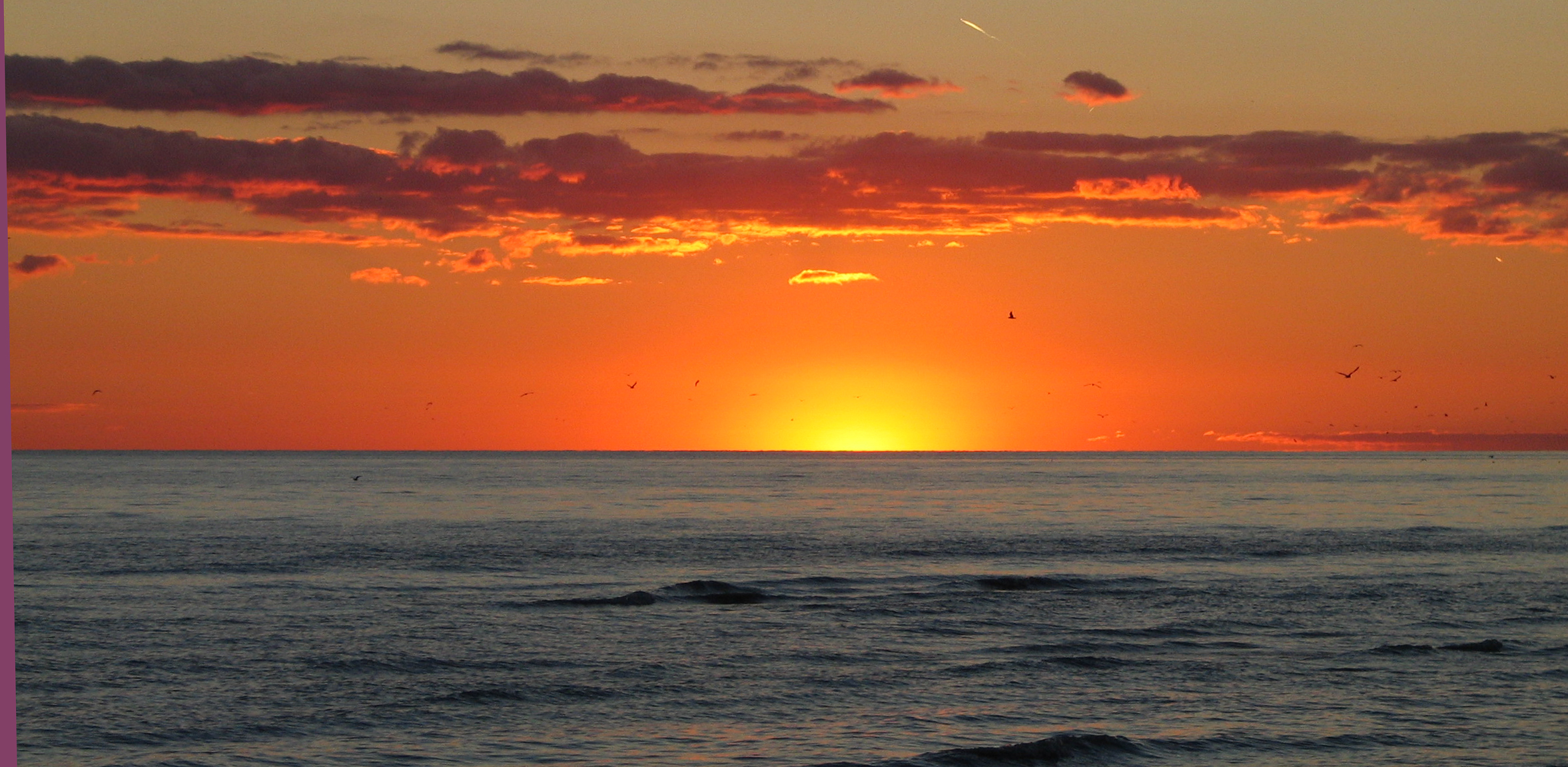
November 11
November 11, 2023
November 11. Remembrance Day. The day the Great War – now called the First World War – finally ended. The date has always been a significant one for me, first of all because it is my birthday, but also because the horrors of the war that ended on that day, and the even greater horrors that followed it, had a huge impact on my family, and therefore on me.
The guns fell silent on November 11, 1918, but reportedly many soldiers in the trenches feared that the armistice would prove to be temporary, and that fighting would shortly resume. In essence, they were right, even if there was a pause of a few years. The way the war was fought, and the way it ended, guaranteed that there would be another one, and that it would be even worse. Some historians argue that the First and Second World Wars were so closely linked that they were really one war, interrupted by a temporary armistice.
The First World War was an enormous crime perpetrated by Europe’s ruling classes: capitalists, landowners, aristocrats, and politicians. They expected, and indeed hoped, that a war would break out sooner or later, and they expected that they would benefit from it. Their visions were of profits, glory, and the conquest of territory and overseas colonies. None of them believed that their side would lose, and the loss of human life meant nothing to them. In addition, as historian Jacques R. Pauwels writes, “war was expected to serve as an antidote to social revolution, causing workers to abandon socialism’s focus on overthrowing the established order via international worker solidarity in favour of nationalism and militarism.” In other words, one of the benefits of war, in the eyes of the ruling classes, was that workers would be slaughtering each other rather than fighting their real enemies.
The fighting ended at 11:00 am on November 11, 1918: the famous eleventh hour of the eleventh day of the eleventh month, mentioned in reverential tones by sombre speakers at countless Remembrance Day ceremonies.
Official remembrances are often about forgetting as much as they are about remembering, and “Remembrance Day” is no exception. Why did the fighting end at 11 am on November 11?
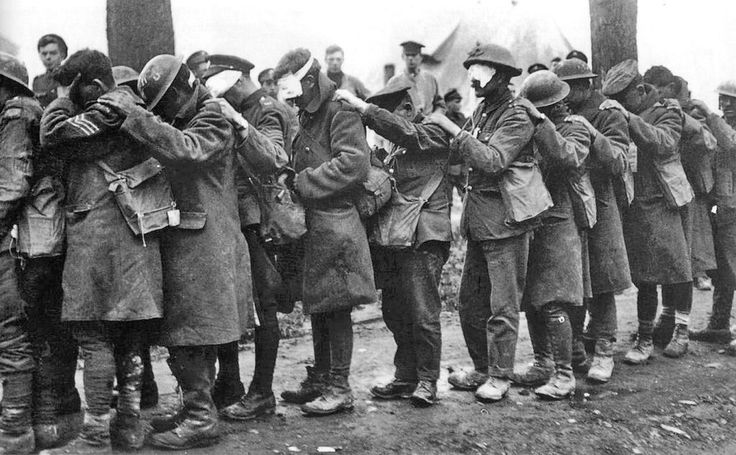
Soldiers blinded by mustard gas in World War I.
Gaza: Dehumanization and humanity
November 4, 2023 - #
The November 4, 2023 edition of Other Voices, the Connexions newsletter, which I edit, went out by email today. You can see it online here.
This issue is devoted to the ongoing horror of Israel’s genocidal attack on Gaza. I wrote the introduction, which appears below.
Gaza, O Gaza! What else could this newsletter be about except Gaza?
A hyper-militarized state, with a 75-year track record of ethnic cleansing, extreme violence, and violating international law with total impunity, is now crossing the final red line. We are witnessing genocide. How many dead will it take before the ‘international community’ intervenes? We already know the answer. Even when the United Nations General Assembly overwhelmingly votes for a ceasefire – a mere ceasefire, nothing more – the killing continues without pause, because there is no ‘international community’ – the only power than counts is the United States, with a few obedient client states, like Canada, trailing in its wake.
The more the killing goes on, the more eagerly Israel’s accomplices – among them, U.S. President Joe Biden, British Prime Minister Rishi Sunak, and, not wanting to be left out, Canada’s foreign minister Mélanie Joly – rush to Israel to genuflect and signal their approval of the slaughter.
Emboldened by these gestures of submission, Israel’s leaders continue to push even further, reassured that there is nothing, absolutely nothing, they won’t be permitted to do. An Israeli leader openly speaks of preparing a “Shoah” for the Palestinians. Shoah is not a word that slips out accidentally when an Israeli is speaking. They know what they are saying, and they mean what they say.
Others speak of bringing about a second Nakba, even more far-reaching than the Nakba of 1947. The Palestinians, they say, are “cockroaches” and “human animals.” The use of nerve gas against a civilian population is openly discussed among Israel’s military planners; the only objection raised is that it might accidentally kill Israeli soldiers as well. Questioned about the morality of bombing defenseless civilians, they point to Allied bombing in World War II. Dresden and Hiroshima were annihilated, they say: why should Israel settle for a lower body count? There are answers to that question, but they won’t come from politicians who are busy applauding mass murder.
What is there to say, except that we need to protest against governments that don’t speak for us? When governments and media do everything they can do dehumanize Palestinians, we are called on to remember the common bond of humanity that links us to Palestinians, and to act accordingly.
The mainstream media report on world events as if history started last week. Hamas’ break-out from the Gaza ghetto in which Israel has imprisoned the people of Gaza for the last 16 years, is reported as if it was inexplicable. The daily humiliations and restrictions imposed on Palestinians by the apartheid state that has ruled their lives for decades are ignored or brushed aside, as is the intensification of settler violence in the West Bank, where almost-daily pogroms are now a reality of Palestinians’ lives.
To provide some needed context, this issue of Other Voices looks at the history of Israel’s blockade and Israeli violence against Gaza, presenting articles that appeared on the Connexions website over the past 16 years. We hope they will help to counter the historical amnesia fostered by the mainstream media.
We also feature material which is concerned, not with violence, but with the rich cultural life of the people of Gaza. “Unprovoked Narratives” is an online collection of short films assembled by the Palestine Film Institute. Watching them reminds us, if we need reminding, that the people of Gaza are full of life and imagination. Watching them today is nonetheless painful, because almost certainly some of the people we see in these films will have been killed, or had family members killed, in the last three weeks. More will die in the weeks to come.
We are witnessing genocide. We need to act.
Ulli Diemer
Read more....

Fading to Silence? Other Voices, October 14, 2023
October 14, 2023 - #
The October 14, 2023 edition of Other Voices, the Connexions newsletter, which I edit, went out by email today. You can see it online here.
The theme of this issue is “Fading to Silence.”
The limits of permissible expression are shrinking dramatically. In the ‘Western’ world the illusions of liberal democracy and free speech still persist to a degree (albeit among a shrinking proportion of the population) thanks to the never-ending monologue of self-praise of the mass media and other institutions of narrative control.
A crucial element of maintaining the ‘necessary illusions’ of capitalist society, as Noam Chomsky and Edward Herman pointed out, consists of setting narrow boundaries for what can be discussed and then encouraging vigorous debate within those boundaries. We are free to argue about pronouns, bike lanes, and the future of the Toronto Maple Leafs. Commentators in the elite media can even debate whether ‘we’ ought to escalate the war against Russia, or whether ‘we’ ought to concentrate our efforts on preparing for war with China. (They are all agreed that ‘we’ should support Israel as it moves from mere ethnic cleansing to outright genocide.)
For a brief historical moment, the evolution of the Internet provided a means for people outside the mainstream to reach a wider public. Those who hold power saw that as a threat, and took action to throttle those unruly alternative channels. The most important step was privatization: the early Internet, anarchic and anti-commercial, was quickly taken over by corporations. Alternative voices were increasingly pushed to the fringes.
Fringe or not, some of those voices managed to expose misdeeds that were supposed to remain hidden. Nothing is worse than the crime of telling the truth, and those who commit that crime are pursued with unlimited vindictiveness, as people like Chelsea Manning and Julian Assange learned. In American ruling circles, the debate about what to do about Assange was between those who wanted to lock him up for life, and those who wanted to assassinate him.
More widely used, and highly effective on a broad scale, is the use of algorithms to strangle unwelcome voices. The major social media and search platforms have become extremely adept at disappearing alternative points of view simply by adjusting their algorithms. Over the past number of years, left-wing websites have witnessed dramatic drops in the number of people who visit their sites as the articles they publish disappear from search engine results and social media.
Read more....
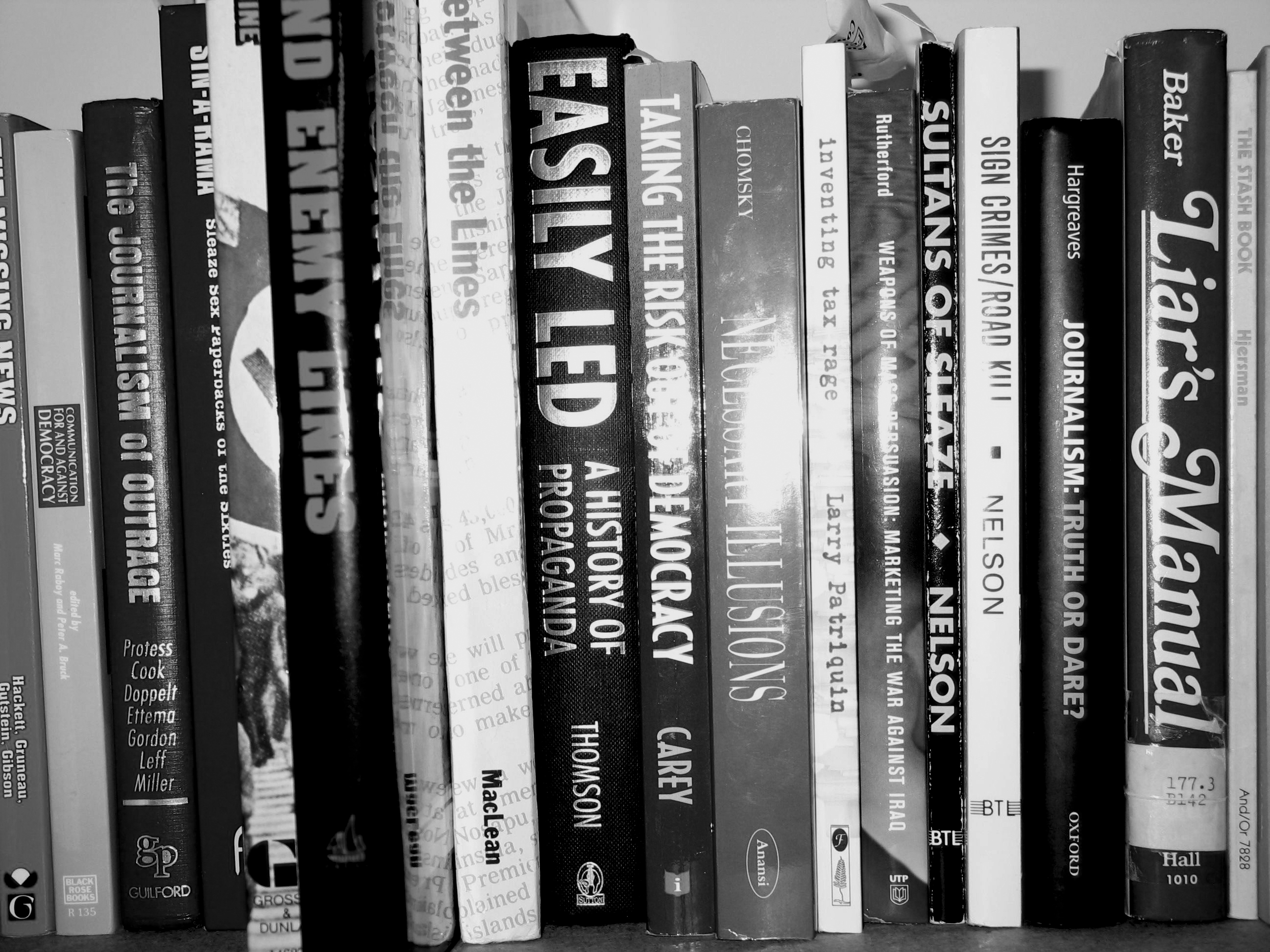
A bookstore moment
October 13, 2023 - #
When the world seems too much to handle, as it does these days, I sometimes seek solace in a bookstore.
So I went to Doug Miller Books just down the street from me today. “Looking for anything in particular?” he asks, as he usually does when customers come in. “Not really,” I say. “I probably shouldn’t even be here, since I have too many books already. I think it’s an addiction.” He smiles, because he approves of me having this addiction. I head off toward the back of the store.
A woman comes in a few minutes later. “Looking for anything in particular?“ Doug asks. “I want some books to decorate my bookshelf,” she says. “It doesn’t really matter what they are about. Well, I guess it does a bit.” Doug guides her to the shelf of military books. I’m not sure why there, but I presume he knows his business.
Me? I buy “Don’t Let’s Go to the Dogs Tonight” by Alexandra Fuller. It has a nice spine: Red, yellow, green, black, and white. I think it will look nice on my bookshelf.
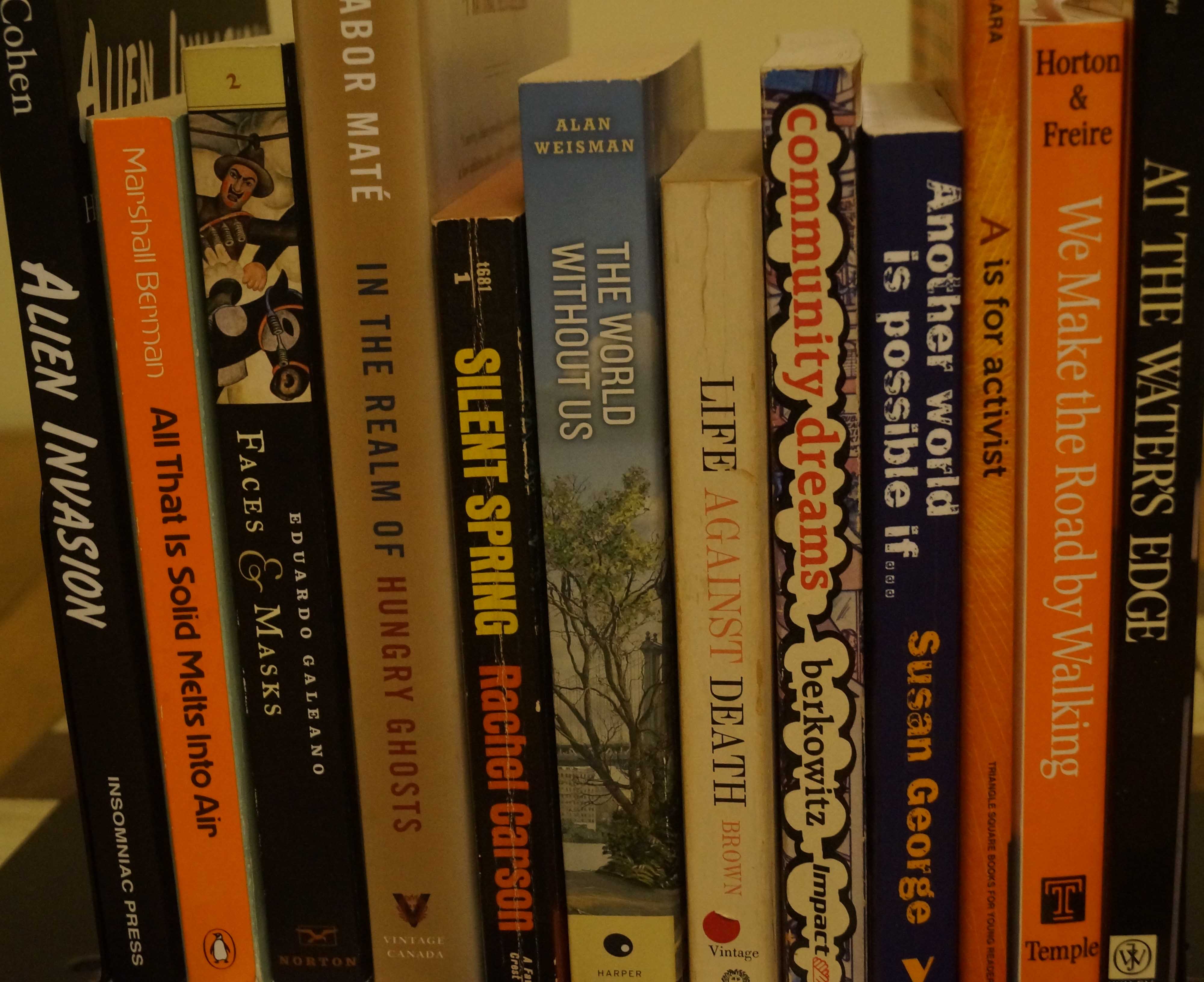
Our job is to oppose the U.S.-NATO Empire
October 8, 2023 - #
Last week, I posted some comments on Facebook about the war in Ukraine. There were a number of responses, some positive, some not. I have written about the war previously, for example here and here, and will no doubt do so again, but for now here are a few comments on my position:
The Main Enemy is at Home: My attitude derives from the left-Marxist position in the First World War. While most of the socialist left in most countries supported ‘their’ side in the inter-imperialist war, the radical left, which included people like Lenin, Luxemburg, and Liebknecht, and the socialist parties in Serbia and Bulgaria, took the position (as memorably articulated in Liebknecht’s slogan “The main enemy is at home!”) that the left should oppose their ‘own’ government and their ‘own’ side in the inter-imperialist war. It is worth noting that the Serbian socialist party took that position even though Austria had invaded Serbia.
My position is that the U.S.-NATO empire is the main enemy for those of us who live in that empire. That empire is far and away the main enemy of peace, and of working people, in the world today. I believe it is our responsibility to oppose our ‘own’ imperialists. It is the task of people in Russia to challenge their government.
Something that particularly disturbs me is the loose talk among pro-NATO cheerleaders about how ‘we’ should support Ukraine militarily. Who are ‘we,’ exactly? It is my impression that many of the people posting these comments are pensioners sitting in front of their computers thousands of miles away from the fighting, people who are extremely unlikely to join the Ukrainian army.
So then, who does ‘we’ really refer to? It refers to NATO, which is a tool of U.S. imperialism, and the source of limitless profits for the arms industry. It is a sad fact is that people who used to oppose NATO (at least until Yugoslavia/Kosovo in the late 1990s or Libya in 2011, when quite a few former leftists became supporters of imperialist interventions) are now full-on supporters of NATO. When they say ‘we’ they mean NATO, and the military-industrial complex in NATO countries.
What is also astonishing is that the people who take this position can support all-out NATO involvement in this war while simultaneously denying that this is a proxy war being waged by NATO.
And what does ‘support’ mean, exactly? One gets the impression that those who want to extend this military ‘support’ have fantasies about sending rifles to sturdy workers and farmers who will form people’s militias and go forth to confront the enemy – something like the Vietnamese fighting the Americans.
That is a fantasy. That is not what military support is.
‘Support’ means providing massive quantities of cluster munitions which will continuing killing people for decades. ‘Support’ means providing depleted uranium munitions which are guaranteed to cause birth defects and cancers in large numbers of children for generations. ‘Support’ means ballistic missiles. ‘Support’ means the U.S. military providing targeting information for missiles that strike targets inside Russia. ‘Support’ means encouraging reckless actions by NATO, actions that are acts of war under international law. ‘Support’ means an escalating risk of all-out nuclear war.
I wish the pro-NATO warmongers who are in favour of ‘military support‘ would be honest enough to come right out and say: “Yes, I think it is preferable that this war continues for years, at the cost of hundreds of thousands of casualties, rather than sit down to negotiate.” I wish they would be honest enough to admit, if only to themselves, that they think it’s better to risk nuclear winter, and the end of the world as we know it, rather than see a negotiated end to this war.
"How did you organize before the Internet?"
May 3, 2023 - #
Connexions is working on a project devoted to answering that question, and we’d like your help. We are looking for your recollections, stories, photos, and descriptions of your work, and we are also looking for samples of printed and other materials that you or your group produced.
We are hoping to produce, first, a feature for the Connexions website – www.connexions.org – that allows visitors to the website to explore and learn about the many different ways people on the left met the challenge of ‘getting the word out.’ We’re focusing especially on the “means of production” (of course!) and on the means of distribution, but we also want to pay attention to the political context and debates people were engaged in. Down the road we are hoping to pull together a physical exhibit, in collaboration one or more organizations which have a suitable space, displaying some of those means of production and the materials produced with them.
What we are looking for now is your memories. Written accounts would be great. Perhaps today is the day to sit down and describe the nitty-gritty of the behind-the-scenes work that went into all that political organizing. Maybe you’d like to sit down with your fountain pen, or your manual typewriter, and start recording those memories on paper. (Although we would actually prefer to receive digital files.)
We would also be happy to arrange an interview (phone or in-person) to add to Connexions’ collection of oral history interviews. Photos would be great too. And so would leaflets, posters, newsletters, etc. which we could scan and put online.
Our vision of the ‘Getting the Word Out’ project includes at least three dimensions: What, How, and Why.
The ‘What’ might include leaflets, posters, buttons, stickers, postcards, newsletters, newspapers, pamphlets, T-shirts, audio cassettes, guerilla theatre, songs, slogans and chants, and probably lots of other things we haven’t thought of.
The ‘How’ might include describing how we used our means of production, like that Underwood typewriter (with whiteout for correcting mistakes!), and later that IBM Selectric with the golf balls, that mimeograph or Letraset machine with its stencils and inks, the silk-screen and the photographic darkroom, the smaller bits of equipment like Xacto knives, waxers, border tapes, and blue pencils, and of course the condensed milk mixture for putting up posters.
We’d also like to hear about how the messages in those leaflets, newspapers, etc. were used to reach people: at workplaces, street corners, demonstrations, and wherever else you tried to engage people politically. Perhaps you remember phone trees, or the "Dial-a-Commie" answering machine?
As for the ‘Why,’ perhaps you might share some thoughts about the strategies you pursued, and to what extent they were successful. Did they bring us closer to the Revolution?
Don’t feel that you are being asked to produce a magnum opus. A quick sketch, even a paragraph or two, would be very welcome. Whatever works for you. We hope it might be fun to get some of those memories recorded.
If you have stories to tell, experiences to share, or questions, please contact us at Connexions. And please share this request with other people who might be interested.
Ulli Diemer
for the Connexions Archive
www.connexions.org
The many faces of Ulli Diemer, or, the uses of ‘artificial intelligence’
April 28, 2023 - #
It seems that everyone is talking about ChatGPT. I have seen a few essays generated by ChatGPT, and I can’t say I’m impressed. They read like something that an unambitious high school student hoping to scrape by with a ‘C’ might hurriedly cobble together the evening before an essay has to be handed in. The essay would be unlikely to receive that ‘C’ grade, however, because plagiarism is at the heart of ChatGPT’s output, and outright plagiarism – as opposed to unoriginal derivative thinking, which is commonplace – is still frowned on in educational settings.
The hype around ChatGPT got me thinking about other ‘intelligent’ applications that have been around for years, such as the Postmodernism Generator, which has been online since 2000, and in that time has delivered more than 33 million essays. There are also 500letters.org and artybollocks.com. All of them are way more fun, and way more original, than ChatGPT, so I asked all of them about myself. I’ve posted what they had to say about me below. You’ll see that I’m way more interesting than you may have thought. I particularly like the observation that my work is “saturated with obviousness, mental inertia, clichés and bad jokes.”
Down by the lake this morning
April 28, 2023 - #
Down at Colonel Sam Smith Park this morning, I was surrounded by the sounds of Spring: Redwings proclaiming their territories, Grebes courting loudly, Canada Geese honking, a chorus of birds I couldn’t identify, and in the background, the waves crashing on shore.
I also noticed that there were swarms of insects hovering around me, which motivated me to go check out the field where the nesting boxes for Tree Swallows are located. They’re back! Swallows, lots of them, in the air, hawking for insects, and most of the boxes (several dozen in all) had a Tree Swallow sitting on top.
I don’t like to play favourites, and in any case my opinion changes from day to day, but today, at least, I think that Tree Swallows are the most beautiful birds in existence!
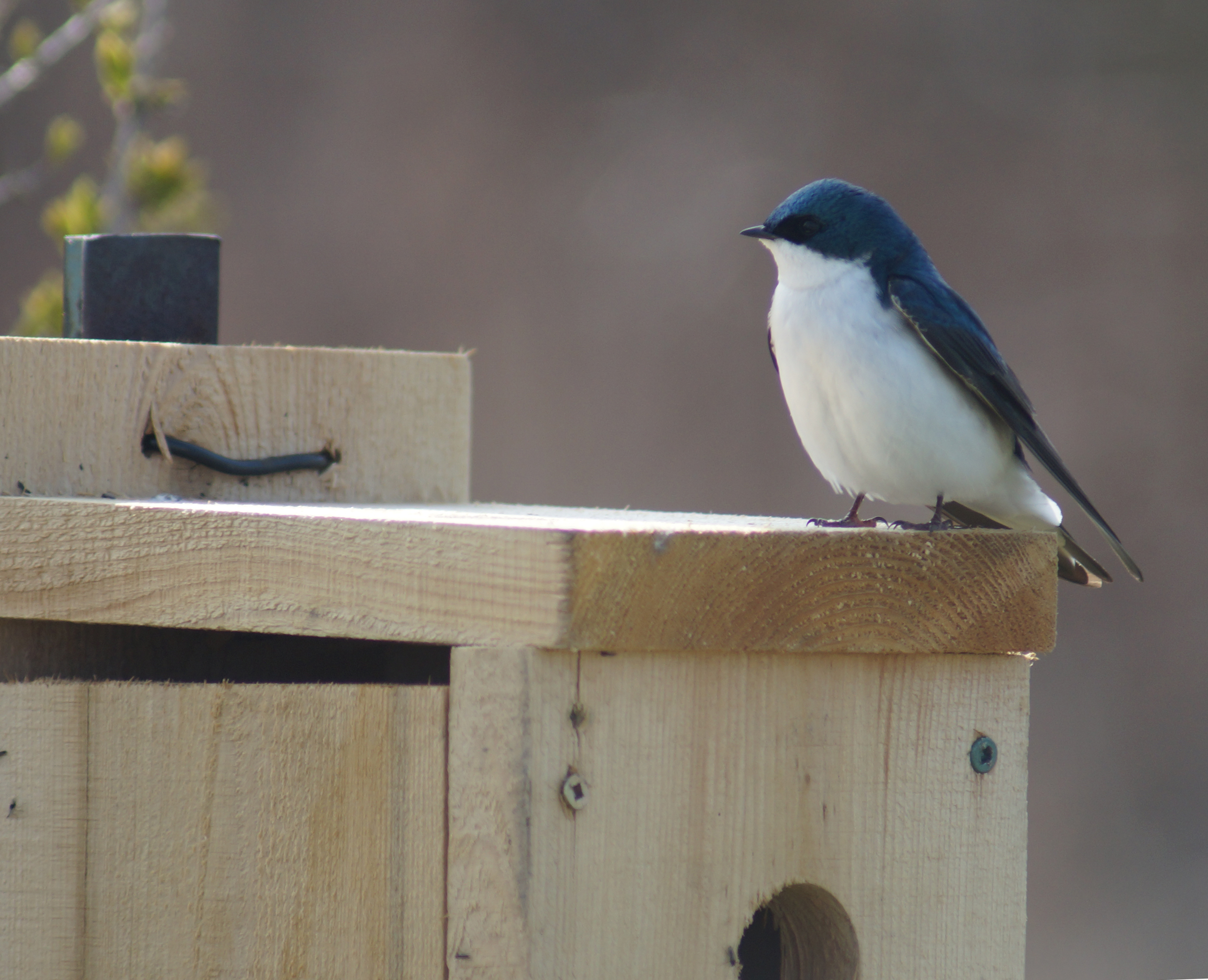
World Curlew Day 2023
April 21, 2023 - #
I have been producing a nature calendar (featuring my late partner Miriam Garfinkle’s nature photos) for the past five years. I include a miscellany of days that I think are worth noting, some of them political, many related to nature, and a few that might be considered slightly idiosyncratic, like World Chocolate Day (July 7) and International Beer Day (August 4).
April 21 is World Curlew Day. Curlews are wading birds with long bills, similar to Sandpipers. There are – or were – nine species of Curlew. Now, in all likelihood there are only eight species. The ninth species, the Eskimo Curlew, was at one time one of the most numerous shorebirds on the American continents, with a population in the millions. They shared the fate of the Passenger Pigeon, the Great Auk, and the Labrador Duck, which also thrived in large numbers until Europeans arrived. Eskimo Curlews were highly social, and that was a key element in their demise. They travelled in large flocks, making it easy for groups of hunters to shoot them. And shoot them. And shoot them. Not only that, but their instinct, when a member of the flock falls to the ground, is to swirl down to see what is wrong. Shoot one, and hundreds more will fly into shooting range.
There is still a small degree of ambiguity about the fate of the Eskimo Curlew. The last confirmed sighting was in 1963. Confirmed because the man who saw it shot it (of course), so there was a body to identify. Nevertheless there have been a few possible unconfirmed sightings since then. It’s possible a few still linger on somewhere, in the same way as a few Ivory-billed Woodpeckers are said to hang on in a swamp in Louisiana. The official status of the Eskimo Curlew is “Critically Endangered or Extinct.” If by some miracle you see one, you aren’t supposed to shoot it.
The Eskimo Curlew has a special place in Canadian literature. Fred Bodsworth’s book, Last of the Curlews (surely one of the few adult novels whose main character is a bird) was published in 1954. It became an enormous bestseller, selling more than three million copies, that at a time when Canada’s population was 18 million. At the time, it was apparently the best-selling Canadian book of all time. An animated film based on the book appeared in 1972.
The book tells the story of a lone male Curlew trying to find a mate. I don’t think it requires a spoiler alert to indicate how the story ends: after all, the book is called ‘Last of the Curlews.’
The photo below of the Eskimo Curlew was taken by Don Bleitz in 1962. It was the only time an Eskimo Curlew was ever photographed.
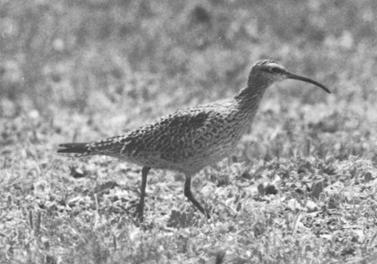
Related Reading:
Longing for freedom and grieving loss
Strange sounds up in the trees
The intelligence of ravens
White-throated Sparrow
Down at the lake
Red-tailed Hawk
Pigeons and People
Photography and the Landscape of Memory
Nature Calendar April: Red-winged Blackbird
April 1, 2023 - #
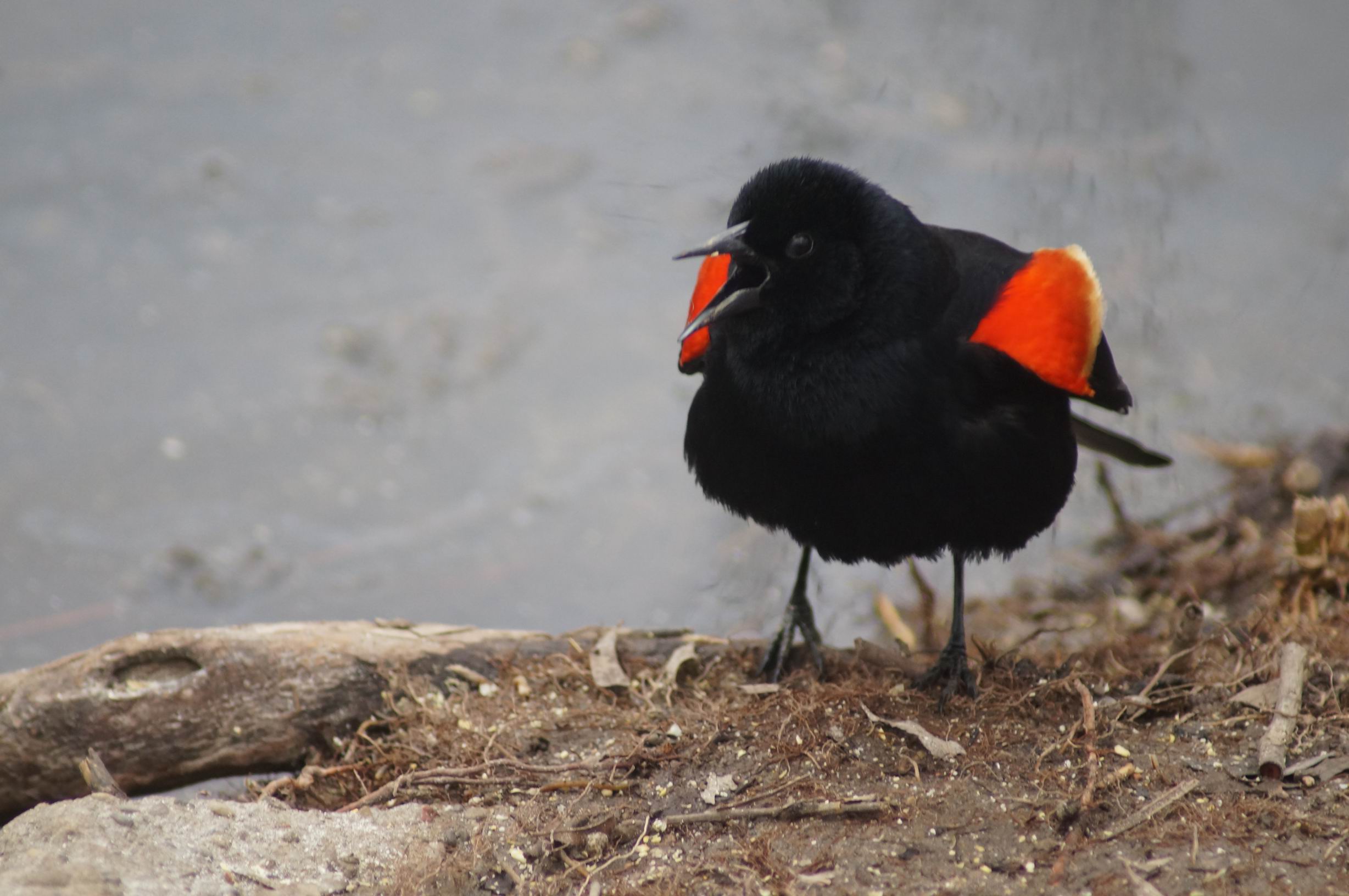
This is the April photo in the 2023 edition of Miriam’s Nature Calendar, featuring Miriam Garfinkle’s photos.
Male Red-winged Blackbirds use their bright red shoulder patches and their strident voices to lay claim to a breeding territory to which they will seek to attract one or more females. Miriam photographed this assertive specimen at the edge of Grenadier Pond on April 24, 2108, on one of our traditional birthday outings to High Park.
Nature Calendar March: Ring-billed Gull
March 1, 2023 - #
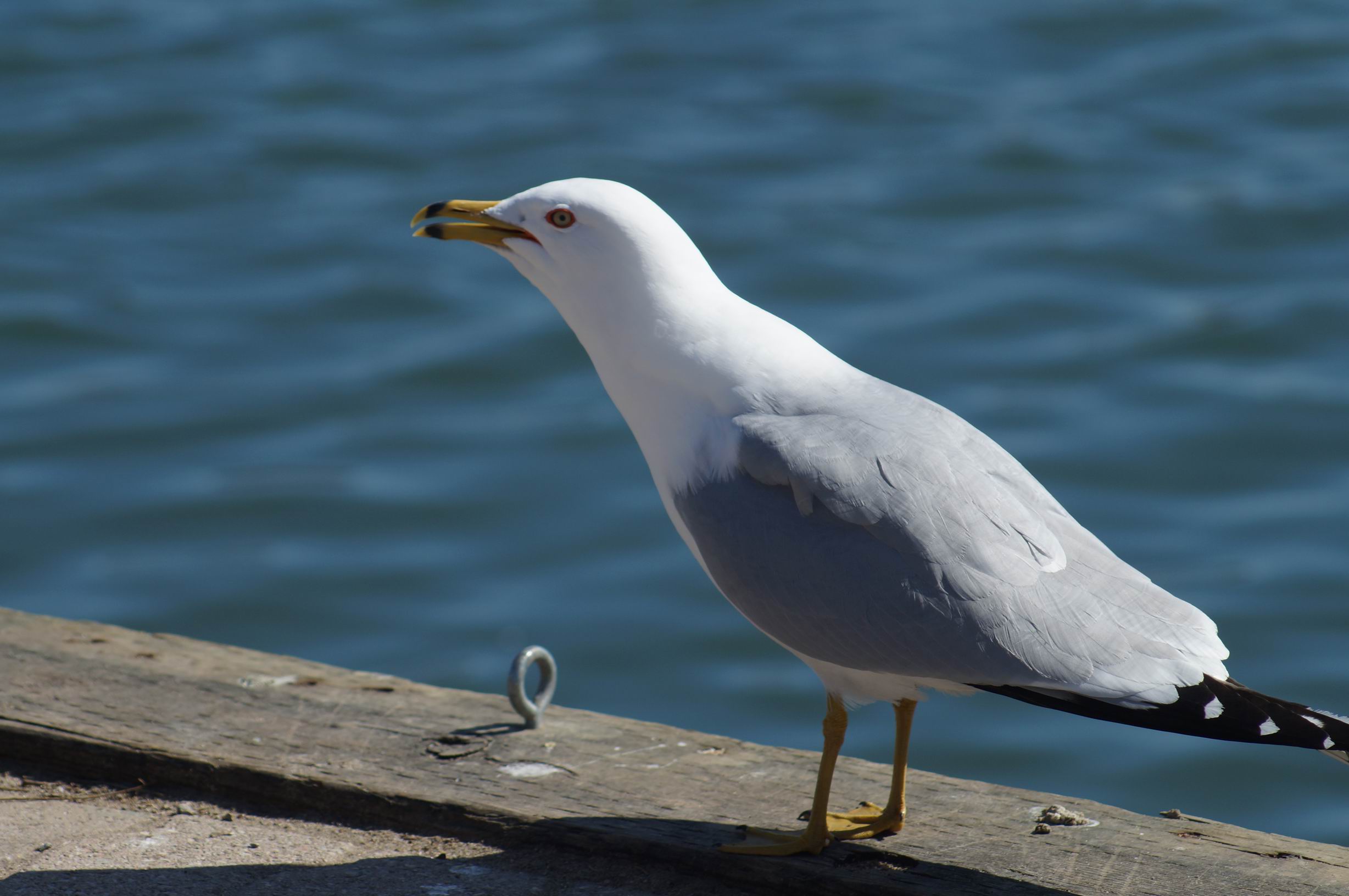
This is the March photo in the 2023 edition of Miriam’s Nature Calendar, featuring Miriam Garfinkle’s photos.
Ring-billed Gulls had virtually disappeared from the Great Lakes region by the beginning of the twentieth century. They started recolonizing the area around the 1920s, and have been expanding their numbers ever since. Superbly adapted to living with humans and appropriating their food, they now number in the millions.
Nature Calendar January: Trumpeter Swan
January 1, 2023 - #
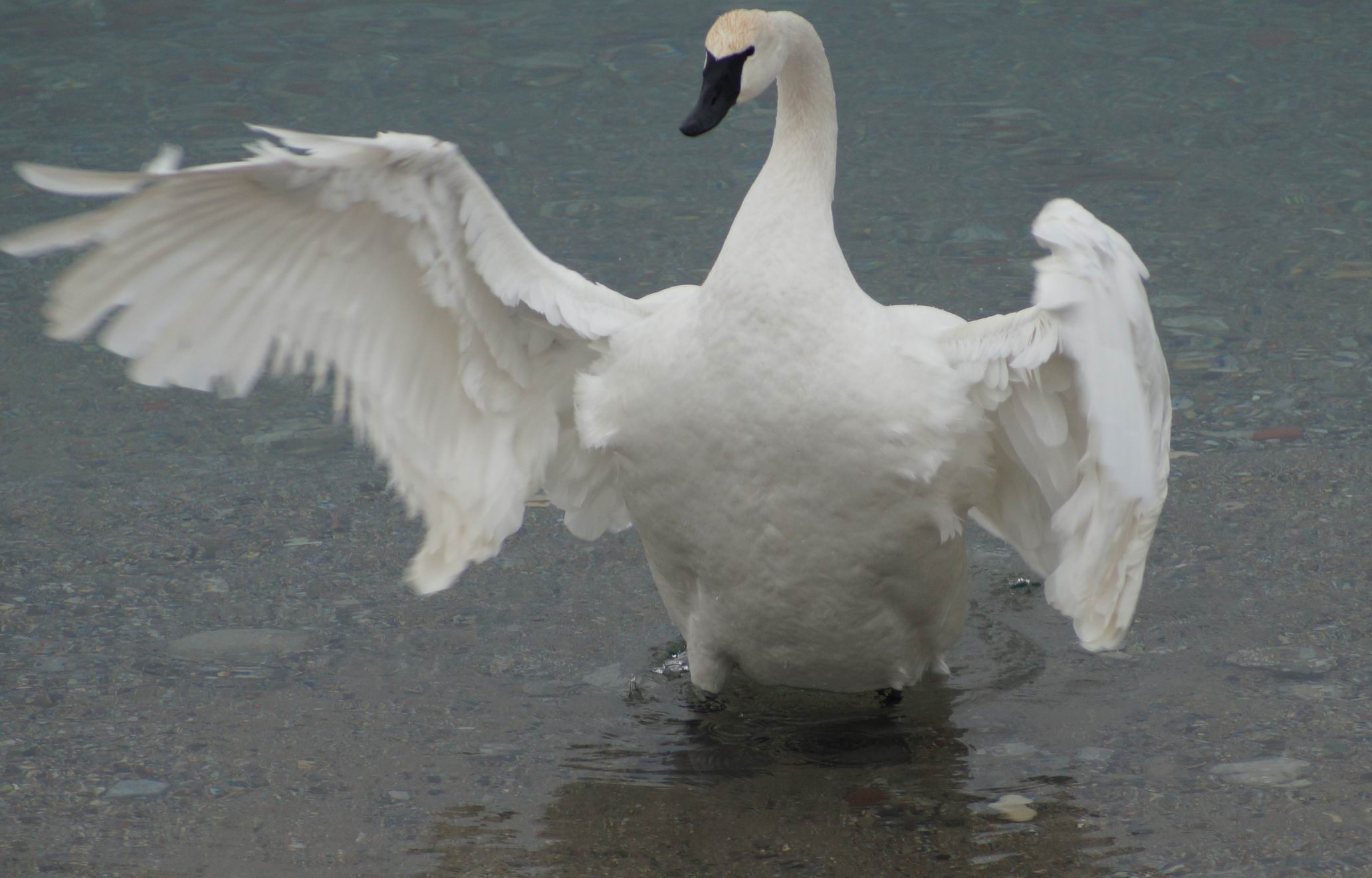
This is the January photo in the 2023 edition of Miriam’s Nature Calendar, featuring Miriam Garfinkle’s photos.
Trumpeter swans are impressive: the biggest wild birds in North America, and probably among the loudest. Driven to the edge of extinction in the 1800s, Trumpeters are slowly re-establishing themselves. At the Leslie Street Spit, where Miriam took this photo, they can be seen and heard even in mid-winter.
Nature Calendar 2023
December 4, 2022 - #
Again this year, I created a calendar featuring photos taken by my partner, Miriam Garfinkle, who died on September 15, 2018. Miriam was frequently out in nature, and she’d often have a camera with her. As I have done for the last four years, I gathered up some of the photos she took and compiled them in Miriam’s Nature Calendar 2023. I printed about 120 copies for friends and family. The PDF version is available online. PDF versions of previous years are here: 2022, 2021, 2020, and 2019. This year’s edition, which I have decided will be the last, also features a photo essay: Special Places: Photography and the Landscape of Memory.
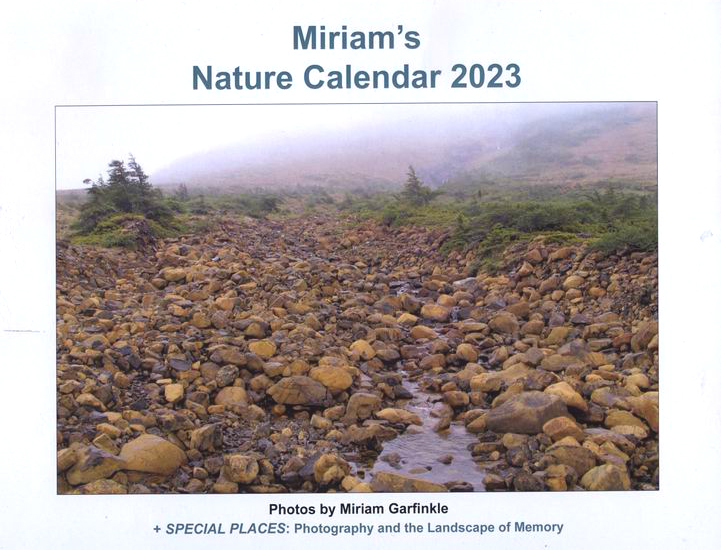

Situation Normal – November 28, 2022
News from the real world and beyond
November 28, 2022 - #
Corporate media, corporate democracy # The Canadian Journalism Foundation is advertising the CJF Awards. The presenting sponsor is Google News Initiative. The long (40+) list of corporate and institutional sponsors includes Telus, Labatt, Meta, Accenture, BMO, Sobeys, CIBC, Rogers, Shaw, McCain, TD, GM, Power Corp, Porter, and Cision.
Near the bottom of the page advertising the Awards event is the slogan “As Journalism goes, so does Democracy.”
At least that’s honest: corporate-controlled media, corporate-controlled government: that’s what our “democracy” looks like.
Cause of death: Shopping while Palestinian # A headline reports “Palestinian killed while buying bread in West Bank.” Who killed him? The story tells us that he was killed outside a West Bank bakery “during an Israeli raid” but stops short of actually saying that the Israeli soldiers shot him. You can’t be too careful when reporting on Israel. On the other hand, if a Palestinian had killed an Israeli, we can be quite sure that the story would tell us that explicitly.
Enjoying my glue stick # Staples sent me an email: Hi Ulli Diemer, Thank you for shopping with us! We hope you’re enjoying your UHU Glue Stick – 21gr – 1 Pack. We value customer feedback and hope you’ll take the time to share your thoughts. Click the stars to get started:
I’m flattered to be asked for my thoughts, of course. But much as I’m enjoying my glue stick, I’m having trouble putting into words just how much I enjoy it. I hope the folks at Staples won’t be too disappointed.
Can this be normal? # From an article in the Toronto Star on research by a doctoral fellow in the department of psychology at the University of Toronto who is doing research on sex education: “I wondered, though, if engaging in sex was a normal part of adolescence.”
“Finally fun again” # A gung-ho article headlined “Finally fun again” after seven tough years (National Post, November 25, 2022) excitedly informs us that “The stars are lining up for a bullish 2023 for the oilfield service industry after it finally enjoyed a promising recovery this year. Canadian drilling levels are expected to be up about 20 per cent this year from 2021 levels. Next year is looking even stronger.”
Climate change? What's that? And who cares?
What I’ve Been Reading
Locations of Grief: An Emotional Geography, edited by Catherine Owen
A Runner’s Journey, by Bruce Kidd
Hen's Teeth and Horse's Toes, by Stephen Jay Gould
A Man of Our Times: The life-history of a Japanese-Canadian fisherman, by Rolf Knight, Maya Koizumi, and Ruichi Yoshida
The cuckoo’s calling, by Robert Galbraith
Stump Ranch Chronicles and Other Narratives, by Rolf Knight
The Call of the Red-Winged Blackbird: Essays on the common and the extraordinary, by Tim Bowling
Catch a Fire: Life Tales, by Murray MacAdam
Pigeons and People
October 14, 2022
When I walk in downtown Toronto – something I do nearly every day – I find I spend a lot of time observing other pedestrians. That’s partly a matter of curiosity, because people never cease to fascinate me, but it’s also a matter of necessity, because the sidewalks and intersections are bustling with people, and you have to be alert to avoid bumping into each other.
What I find amazing is how well most of us perform our parts in the intricate ballet that takes place on a city sidewalk. In the busy times of day, which is when I’m usually out there, there can be hundreds of people in motion on a single block, heading in the same direction, heading in the opposite direction, criss-crossing the street, talking to people beside them, walking in and out of stores, hefting bags, musical instruments, and sports equipment, or coming to a sudden stop.
On top of that, many of them are looking at their phones, rather than at where they are going. That’s a bit imprecise, actually. Some of them are looking at the GPS on their phones, which may in fact tell them in which direction their destination lies, but unfortunately doesn’t tell them if someone is standing in front of them.
And yet it all works. We weave, dodge, zig-zag, move to one side or the other, slow down, speed up, and we nearly always do it without colliding.
We aren’t the only ones who manage this. Every self-respecting downtown, including Toronto’s, has pigeons, and pigeons have mastered the sidewalk ballet quite as expertly as we humans have. I try to vary my route to and from the office, but whichever route I take reliably features several spots where pigeons gather. These spots are invariably on a sidewalk or walkway. That’s where the food is. There is what might be called naturally occurring food, for example near the places where people eat, and drop, take-out food, and then there are locations where people come to feed the pigeons, and where the pigeons consequently come to be fed.

Farewell to Facebook?
October 12, 2022 - #
Facebook is telling me that I will be locked out of my account after October 24, 2022 unless I start using ‘Facebook Protect.‘ “Facebook Protect is offered to high-profile users of the platform, such as journalists, government officials, human rights activists and those with a higher-reach following who may be more likely to be targeted by hacking attempts.”
I like the word “offered” in the above explanation. Reminds of me Don Corleone in The Godfather: “I’ll make him an offer he can’t refuse.” This too is an offer you can’t refuse, because if you don’t accept Facebook’s “offer,” they’ll shut down your account.
Now, I wouldn’t have thought that I’m a high-profile user, and I hadn’t noticed that my sporadic Facebook posts reach all that many people. OK, the series of Capybara photos I posted a while back were pretty popular, I have to admit. I learned from the Capybaras that if I want people to read my views about war, or propaganda, or Palestine, or why we need to get rid of capitalism, or the various other topics I write about, it’s important to include an animal picture.
Be that as it may, I’m going to refuse Facebook’s offer. I’m not prepared to do what they demand, which is either to give them my cell phone number, or to use an authentication app like Google Authenticator or LastPass. They say they want me to use two-factor authentication, which I actually already do, because I’ve given them two different email addresses, at different domains. Facebook does in fact sometimes send me an email to confirm that it’s really me logging into my account.
But I’m not prepared to use Google's apps, which all incorporate spyware, and I’m not going to give Facebook my cell phone number, given Facebook’s well-documented record of abusing and selling information which its users give it. My approach to security includes not giving sensitive or private information, like my personal email address, or my cell phone number, to corporations which have a record of abuse.
I’ll have some regrets about leaving Facebook, because it has been a way to keep connected with people who I don't see in ‘real life.’ But Facebook has been getting progressively worse, and more frustrating, increasingly so after Facebook Metastasized into Meta. A large proportion of the posts I get shown when I log on these days aren’t from the people I want know about; instead, I get all sorts of crap which is either paid content, or which has been ‘recommended’ for me by the utterly stupid algorithms that Facebook employs.
So I guess that come October 24, I’ll be kicked off Facebook. People who want to know what I’m writing about, or taking pictures of, can check out my Radical Digressions website at www.diemer.ca. There is also a contact page on the site where you’ll find an email address. And there are some animal pictures too, like these Capybaras.

Nature Calendar October: Wood Duck
October 1, 2022 - #

This is the October photo in the 2022 edition of Miriam’s Nature Calendar, featuring Miriam Garfinkle’s photos.
Wood ducks are normally extremely shy. If a canoe come within 100 meters, they fly away or hide. But a few wood ducks have adapted to urban life in places like High Park and the Brickworks, and those are much less shy and will swim close to shore even when humans are present.
Close Encounter with a Red-tailed Hawk
September 28, 2022 - #

I’m walking down St. Joseph Street, on my way to the Connexions Archive, when a large bird appears out of nowhere and flies right past my head. I get a quick glimpse as it goes by, enough to tell me that it\’s a red-tailed hawk, and that it’s got something in its talons. I turn around and see it land on a branch in the tree I just passed. I stand and watch it.
It’s got a pigeon, which it must have snatched off the ground a few seconds earlier. The hawk goes about its work methodically. It is absorbed in what it’s doing, and I’m absorbed in watching it. Pigeon feathers drift to the ground. After about five minutes of watching, I turn around, and find a young man standing just behind me. He’s also watching the hawk. We acknowledge each other's interest.
No one else has stopped, even though it’s a busy street on the university campus. I guess everyone is in a rush to get to class, or to work. Still, it’s good to know that at least one other person finds this life-and-death drama worth paying attention to. Of course, the hawk doesn’t care if we care. That’s OK.
[Note: the hawk in the picture is not this hawk. The photo, taken by my partner Miriam a few years ago, shows a different red-tailed hawk eating a different pigeon. A bit gory, perhaps, but I had chicken for Rosh Hashanah, so I guess we’re kin, the hawk and I.]
From Cold War I to Cold War II: A brief history
June 10, 2022
Everyone who lived through the decades of the Cold War was aware that a hot war – a nuclear war resulting in the deaths of hundreds of millions – could break out at any moment, either by deliberate decision or because of a simple mistake or miscalculation.
That began to change in 1985, when Mikhail Gorbachev was chosen to be the General Secretary of the Communist Party of the Soviet Union. Gorbachev set out to reform the Soviet Union itself, a process he called perestroika, and also to improve international relations. In 1986, prior to a summit meeting with U.S. President Ronald Reagan, he proposed a program to abolish nuclear weapons by the end of the 20th century. The United States refused to consider such a plan. Nevertheless, Gorbachev’s initiatives bore fruit in the Intermediate-Range Nuclear Forces Treaty, signed in 1987. The treaty remained in effect until 2019, when the U.S. unilaterally withdrew from it.
Gorbachev also declared an end to the ‘Brezhnev Doctrine,’ which held that the USSR had the right to intervene in other Soviet-bloc countries if their governments were threatened. Showing he was serious, he withdrew 500,000 Soviet troops from Eastern and Central Europe – leading in 1989 to the election of new, non-Communist governments in Poland, Hungary, Czechoslovakia and Bulgaria. In Romania, Nicolae Ceausescu’s Communist government fell as a result of an uprising.
The development with the most far-reaching implications was the reunification of Germany after the fall of the Berlin Wall in November 1989. At the end of World War II, the Soviet Union had been prepared to allow the reunification of Germany on condition that it be committed to perpetual neutrality. Having been invaded twice by Germany within 30 years, with the loss of tens of millions of Soviet lives, the Soviet Union had compelling reasons for fearing German rearmament and participation in an anti-Soviet alliance. But the U.S. rejected the idea of a neutral reunited Germany: it preferred West Germany as a client state within NATO with a large American military presence, including nuclear weapons aimed at the USSR.
Gorbachev agreed to permit German reunification in exchange for a pledge from the United States that NATO would not expand into the countries that lay between Germany and Russia. President George H. W. Bush and other American and NATO officials gave Gorbachev a firm commitment that NATO would ‘not expand one inch’ eastward.
In fact, Bush and the American political-military establishment had no intention of keeping their promises. While praising Gorbachev publicly, privately they regarded him as a gullible rube who could easily be deceived.
This essay appears in War, Peace, and the Media, a book co-published by Connexions and Alphabet Publishing, available January 2023.

Situation Normal – May 25, 2022
News from the real world and beyond
May 25, 2022 - #
Laws that matter, and laws that don’t matter so much # The Ontario Divisional court has ruled that the Ontario government failed in its constitutional duty to consult First Nations when it issued mining exploration permits on Treaty 9 land. Does that mean that the permits are invalid? Of course not. The permits stand anyway. There are no consequences for ignoring indigenous rights.
Definition of “good employer” broadened # Ontario’s Conservative government has announced that companies which are under active investigation for workplace violations, as well as companies with high rates of serious injuries, will be eligible for refunds from a $1.5 billion Ontario program set up to reward employers with good safety records.
The struggle against imperialism, as seen from New York # “Imperialism and the Struggle Against It Begins at Home.” That’s the headline on an article in CounterPunch by Stanley L. Cohen, identified as “a lawyer and activist in New York City.”
The headline, appearing as it does on an ostensibly left-wing website, might lead you to expect a political analysis in the tradition of Karl Liebknecht’s World War I slogan “The main enemy is at home!” But no, this is not an article calling on Americans to struggle against American imperialism. It’s yet another anti-Russian screed. For a lawyer living in New York City, it seems, attacking imperialism “at home” means attacking Russia. And the editors at CounterPunch think this is something worth publishing.
Libraries are becoming hubs for learning and study! # An actual quote from an article by Globe and Mail columnist Marcus Gee: “Libraries are evolving. Instead of cloistered fortresses for safeguarding books, they are becoming teeming hubs for group learning and inventive study.”
Has Marcus Gee every set foot in a library in his life? Have institutions that house books ever been anything but places of study and learning? Anyone who knows anything about libraries would know that they have been “teeming hubs” of learning and study from the beginning. The Library of Alexandria was teeming with readers 2200 years ago, many of them discussing what they were reading. Karl Marx was engaged in inventive – and intensive – study in the library of the British Museum more than 150 years ago.
Marcus Gee might want to open the doors to the cloistered fortress of his brain and let some air in.
Good idea, flawed implementation # Someone in the U.S. Bureau of Land Management had a good idea: protect dinosaur tracks in Mill Canyon, Utah, by building an observation boardwalk adjacent to the tracks, to keep people from walking on the tracks. A work crew was duly sent out to do the work. In the course of doing their work, they drove heavy vehicles over the dinosaur tracks, obliterating them. Oops!
The Bureau of Land Management says that the project will be “re-evaluated” and “work crews briefed on where they can and cannot go.”
It might have been a good idea to do that before the project started.
The unending altruism of the rich # Recent discussion about wealth taxes has brought forth the inevitable response. A writer for the Fraser Institute tells us that taxes on the rich are a bad idea because they don’t actually work: they just lead to the rich getting richer, while the poor get poorer.
Here’s another example of the unending altruism of the rich. Even though, apparently, wealth taxes actually lead to them getting richer, they consistently oppose them. You might think that they would be in favour of wealth taxes, if wealth taxes actually benefit them. But no, purely for the sake of the rest of us, they take a principled stand in opposition.
Dumping mine tailings into the ocean: good for the environment? # A Nova Scotia company funded by Elon Musk is working on a plan to dump mining tailings treated with an alkaline powder into the ocean. The idea is that when that powder is distributed into the ocean, it lowers the acidity of the water, thereby increasing its absorption of carbon.
Capitalism, it seems, is becoming increasingly insane as it seeks to “speed up climate solutions” with geoengineering projects which take no account of the complexity of the earth’s intricately interconnected ecology. The bottom line: try anything except actually burning fewer fossil fuels.
Westsplaining # ‘Westsplaining’ has come into vogue as a term used to dismiss intellectuals and leftists who are critical of US/NATO propaganda. People who have spent decades studying Russia and eastern Europe are dismissed as ‘westsplainers‘ if they don‘t accept the US/NATO position on the causes of the Russia/Ukraine war. The term has also now become popular with the pro-NATO left: people who identify as ‘left’ but in fact support NATO and U.S. imperialism.
What I’ve Been Reading
Der Unendliche Augenblick: Warum Zeiten der Unsicherheit so wertvoll sind, by Natalie Knapp
1493, by Charles C. Mann
Guns, Germs, and Steel: the Fates of Human Societies, by Jared Diamond
Open Heart, Open Mind, by Clara Hughes
Dear Al Gorithm
May 7, 2022
I am the webmaster for two substantial websites – Connexions.org and Sources.com – and I also have a personal website called Radical Digressions (www.diemer.ca). Each of those websites has a public email address which receives a steady flow of unsolicited emails, including inevitably a certain quantity of spam and scams.
While most of the spam goes straight to the Junk folder, I do like to monitor some of it now and again just to have an idea of what the current trends are.
Some of the scams, it seems, have amazing staying power. The widows with a fatal illness and a fortune they wants to give to me personally (just as soon as I provide my banking information) have been around for a very long time. I wrote about one of them – Lady Martha’s story – back in 2008. (My interest in spam, it seems, also has staying power.) I just received another one from an unfortunate lady who has a “serious deadly disease” which is likely to kill her within weeks. That truly is serious. She is “legally married to the deceased Peter Adalwolf,” an oil industry executive who has left behind a fortune of 2,500,000 euros, which she wants to turn over to me before she dies. As long as I promise to disburse 70% of it to worthy charities, so she tells me, I can keep 30% as compensation for my efforts. The euro has been plunging in value in the wake of the sanctions against Russia, while the rouble has been increasing in value, but even so, 30% of 2.5 million euros is a sizeable sum of cash. It’s a tempting offer.
Another current trend is Search Engine Optimization (SEO) spam. These are emails asking us to include a link from our website to an article on another website which they are promoting. These are legitimate enough, in their way: they are trying to raise the Google ranking of the websites on whose behalf they are working by getting other sites to link to them. Naturally, doing this kind of work involves sending out many, many emails, since only a small number of recipients will actually agree to add a link.
Their first step is a Google search to find articles on other websites which cover the same subject matter as the pages they are trying to promote. Our websites have a large number of articles, so inevitably they show up in quite a few searches: The Connexions.org website alone has more than 350,000 files. (Yes, that is quite a lot, isn’t it? Maybe you should check it out sometime!)
The next step is to send the webmasters of the sites identified as good prospects emails asking for a link. These emails are signed by people whose names follow a remarkably similar pattern: they all happen to have short Anglo names. We regularly get emails from Jenn, Jane, Jean, Jesse, Jo, Alexis, Andy, Amanda, Lauren, Leo, and Emily. One might conclude that diversity in hiring is not a priority for the companies employing them: one never hears from a Mohammed or a Mei Ling or a Jamal. Not even an Ulli! And absolutely no Vladimirs.
Thinking about Terry Fox and the Marathon of Hope
April 12, 2022
Terry Fox dipped his artificial leg into the Atlantic Ocean off Cape Spear on April 12, 1980 and started running west: toward the Pacific. His Marathon of Hope was underway.
Before he set off, he filled two bottles with water from the ocean. They symbolized his hopes: one was to be a souvenir, the other he planned to empty into the Pacific Ocean when he completed his cross-continent run.
Cape Spear, the easternmost point in North America, owes its name to Portuguese fishermen for whom the sight of this desolate windswept promontory represented hope. “Spera” is Portuguese for hope. There is reason for hope when Cape Spear comes into view, as long as you steer clear of the rocks and the icebergs. St. John’s Harbour – sheltered and often 10 degrees warmer than Cape Spear – is only ten kilometers away.
Hope and determination were what fueled Terry Fox when he set off on that cold and blustery morning.
World Frog Day
March 20, 2022 - #
It was rather exasperating. We could hear the birds, several of them, up in the trees above our campsite in Arrowhead Park, but we couldn’t see them, even though we had binoculars and were checking out the branches their calls seemed to be coming from. This happened several times during the day, and then again the next day. Each time, the binoculars came out, we looked up – and nothing. It was quite puzzling.
Eventually a Park employee came by, doing his rounds of the campsites. “Do you know what is making those sounds?” Miriam asked him. (In our relationship, Miriam was in charge of speaking to strangers.) “Those are Gray Treefrogs,” he said. “You can’t see them because they are the same colour as the bark of the tree.” Ah! Live and learn!
Frogs are tricky. We had a similar sort of experience one spring day in another Southern Ontario woodland. Several vernal ponds had formed, and from one of them, we heard the sounds of ducks. We were a bit surprised that ducks should choose this spot in the woods, just a few dozen yards away from the river, but we were happy to go check them out. Only – there were no ducks. It was a small pond, no hidden spots where ducks could be lurking. But the quacking continued. Closer examination revealed that the quacking sounds were being made by little frogs: wood frogs, as we later learned. The males make quacking sounds to attract females. This seems to work well: wood frogs are widespread throughout North America. They are the only North American frog found north of the Arctic Circle. Wood Frogs, like Spring Peepers, can tolerate below-freezing temperatures: no mean feat for a cold-blooded animal.
Spring Peepers are usually the first to appear in Ontario. They can be heard – peeping enthusiastically – when ponds are still partly covered with ice and patches of snow persist along the shore. We often associate spring with birdsong, but choruses of Spring Peepers can be heard when most of our migratory birds are still well to the south. It’s a sound, I find, that makes me happy.
Peak frog season comes a bit later in the spring. One of the best places I know of to hear frogs is MacGregor Point Provincial Park on Lake Huron. There are several large ponds in the park which provide ideal frog habitat. In April or early May, when frog mating season is at its peak, you can sit beside a pond and immerse yourself in frog sound. They can be extraordinarily loud, especially when several species – Spring Peepers, Wood Frogs, Leopard Frogs, Chorus Frogs, and Mink Frogs – combine in a frenzied cacophony. There were times at MacGregor when we debated whether we should wear ear protection when we sat next to the marsh. Male frogs, like males of certain other species, seem to have a mating strategy that boils down to ‘choose me, I’m the loudest.’
Sadly, frogs are not doing well. Frog populations around the world are declining; a number of species are on the verge of extinction. The reasons are complex, but ultimately it seems that climate change and the contamination of fresh water, even hundreds of miles from the source of pollutants, are to blame. Frogs breathe through their skin, which makes them particularly susceptible to contaminants. Frogs, and amphibians generally, are indicator species, comparable to the canaries in the coal mine. They are telling us that things are not going well on our planet. World Frog Day exists to draw attention to the problems of frogs – as well as to celebrate them. To celebrate them, head out into frog breeding territory in April, and enjoy the chorus of frog-song.
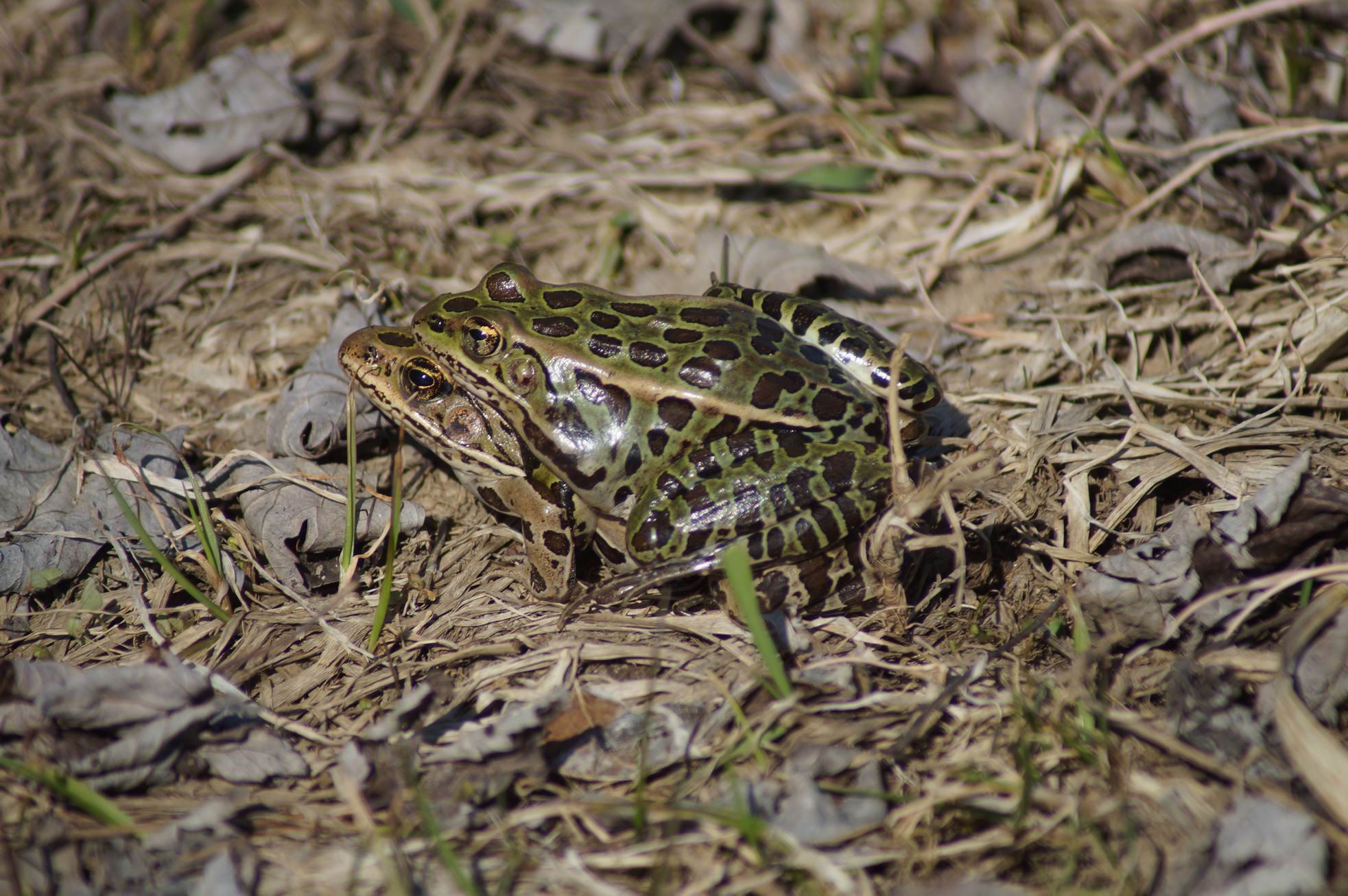
Northern Leopard Frogs, MacGregor Point, May 1, 2018. Photo by Miriam Garfinkle.
Down at the lake
March 18, 2022 - #
Down at the lake
Redwings announce their arrival
Winter ducks prepare to leave
A beaver takes a leisurely swim
And grebes loudly declare their passion.
Spring!
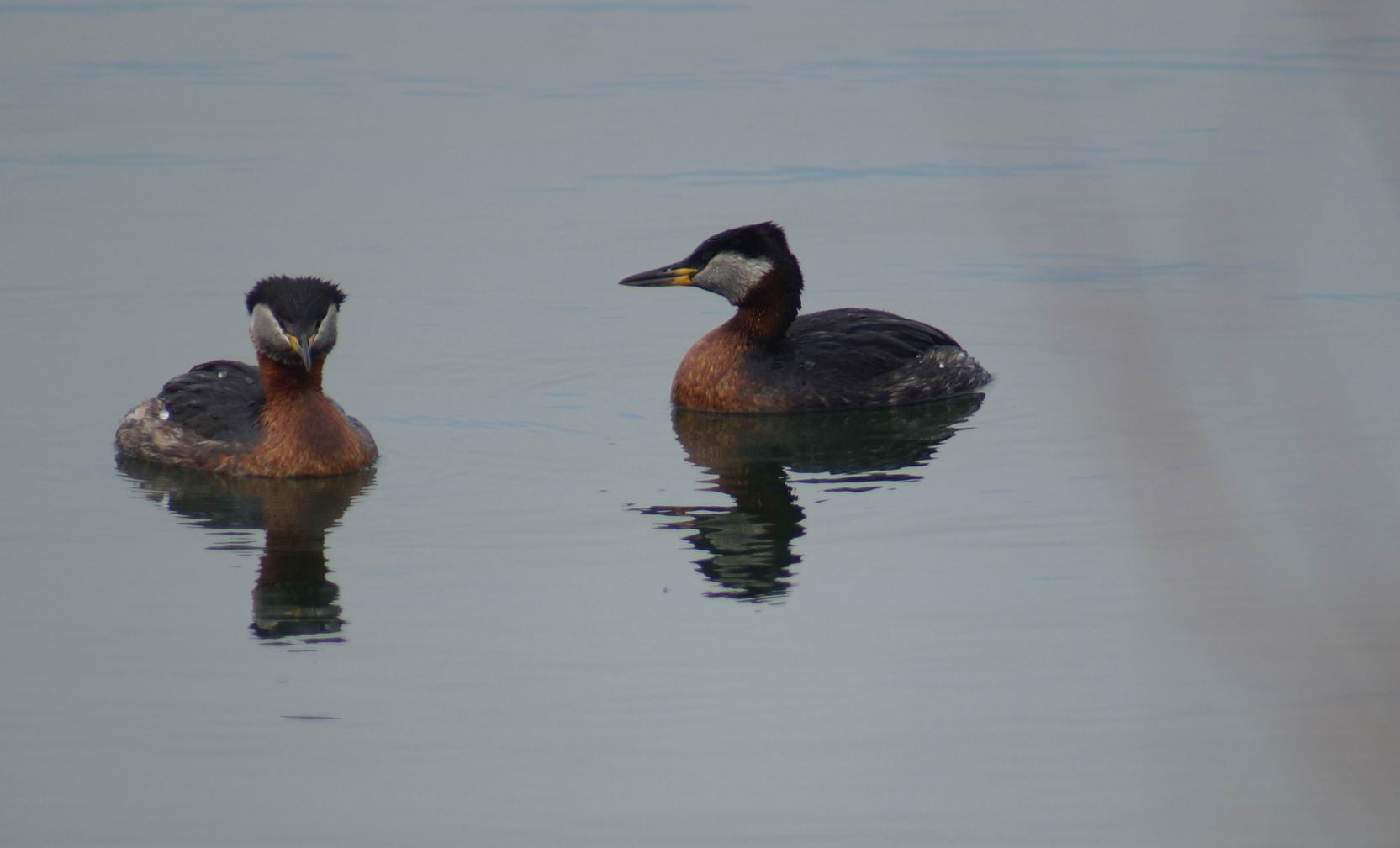
‘When I hear the word Culture ... I reach for my gun’...
March 19, 2022 - #
In Hanns Johst’s play Schlageter (which premiered in 1933 in a performance attended by Adolf Hitler) one of the characters says “Wenn ich Kultur höre ... entsichere ich meinen Browning!” (“When I hear ‘Culture’... I release the safety catch on my Browning!”)
Over time, the line entered popular discourse as “When I hear the word ‘culture’ ... I reach for my gun.”
In the following years, many people reached for their guns, willingly or not, though most of those who died were civilians. Somewhere between 70 and 85 million people perished in World War II. The country that suffered the most was the Soviet Union, where 27 million died as a result of the Nazi invasion.
Nine decades later, the voices of hatred and the calls for reckless military action are once again growing louder, day by day. Another World War seems a real prospect.
Today our culture is dominated by propaganda pushing us to join in a chorus of hate, and calls for escalation, even at the risk of nuclear war.
Faced with this culture of demonization, I reach for poetry instead.
Edna St. Vincent Millay’s poem Conscientious Objector expresses my own feelings today:
I shall die, but that is all that I shall do for Death;
I am not on his pay-roll.
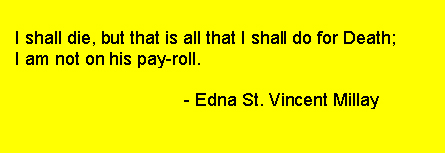
Is this how it all ends?
March 16, 2022 - #
The possibility of nuclear war is increasing day by day.
The mainstream corporate and state media are all pushing for dramatic military escalations. You would think that an order has gone out from the Pentagon to the media, but of course, that’s not the way it works. Our media are more sophisticated: a few key journalists are given exclusive off-the-record briefings by U.S. government officials; those elite journalists produce stories uncritically parroting the line they have been fed, thousands of other journalists and media outlets then produce their own versions of the same talking points, and subsequently those same talking points are amplified by hundreds of thousands of willing accomplices via Twitter, Facebook, etc.
The line that the media is now pushing is that the US/NATO Empire should intervene militarily in Ukraine, including imposing a ‘no-fly zone’, even at the risk of nuclear war. Today’s Toronto Star features an editorial headed “Thinking the Unthinkable.” It acknowledges the risk of nuclear war, but suggests that this is a risk we have to take: “actions which were previously unimaginable seem less so by the day.” By previously unimaginable actions, it means taking actions that will very possibly lead to nuclear war. Also in today’s Star, columnist Rosie DiManno takes the same line: she pushes for a ‘no-fly zone’ even though, as she also acknowledges, this might lead to nuclear war. It’s a chance we have to take, she says.
My expectation is that in the next few days we will see a false flag operation involving chemical or biological weapons. It will of course be blamed on Russia. This will provide the needed pretext for military escalation, including direct attacks on Russian forces. The Russians will respond militarily. The ‘West’ will respond with further military escalations. The risks are enormous.
If there is a source of hope, it is that the rulers of the Empire feel the need for some popular support for their actions. We need to do everything we can to undermine that support. We need to speak out, in every way we can, against military escalation and economic warfare, and in favour of diplomacy and negotiations which recognize that Russia, too, has legitimate security needs which need to be addressed.
If we fail, Greg Mello explains how it might all end in this 2017 interview:
Question: How many people would die during the first day of such a war?
Greg Mello: To a first approximation, in a nuclear war between the US and Russia, everybody in the world would die. Some people in the southern hemisphere might survive, but probably not even them.
Even a couple of nuclear weapons could end the United States as a government and an economy. It wouldn’t take a great deal to destroy the “just in time” supply chains, the financial markets and the Internet. The whole system is very fragile, especially with respect to nuclear weapons. Even in a somewhat limited nuclear war, say a war where only ICBM silos and airfields were targeted, there would be so much fallout from the ICBM fields alone that much of the Midwest would be wiped out, including places like Chicago....
Keep in mind that nuclear war is not one or two Hiroshima-sized bombs. The imagination cannot encompass nuclear war. Nuclear war means nuclear winter. It means the collapse of very fragile electronic, financial, governmental, administrative systems that keep everyone alive.... And if enough weapons are detonated, the collapse of the Earth's ozone layer would mean that every form of life that has eyes could be blinded. The combined effects of a US-Russian nuclear war would mean that pretty much every terrestrial mammal, and many plants, would become extinct.
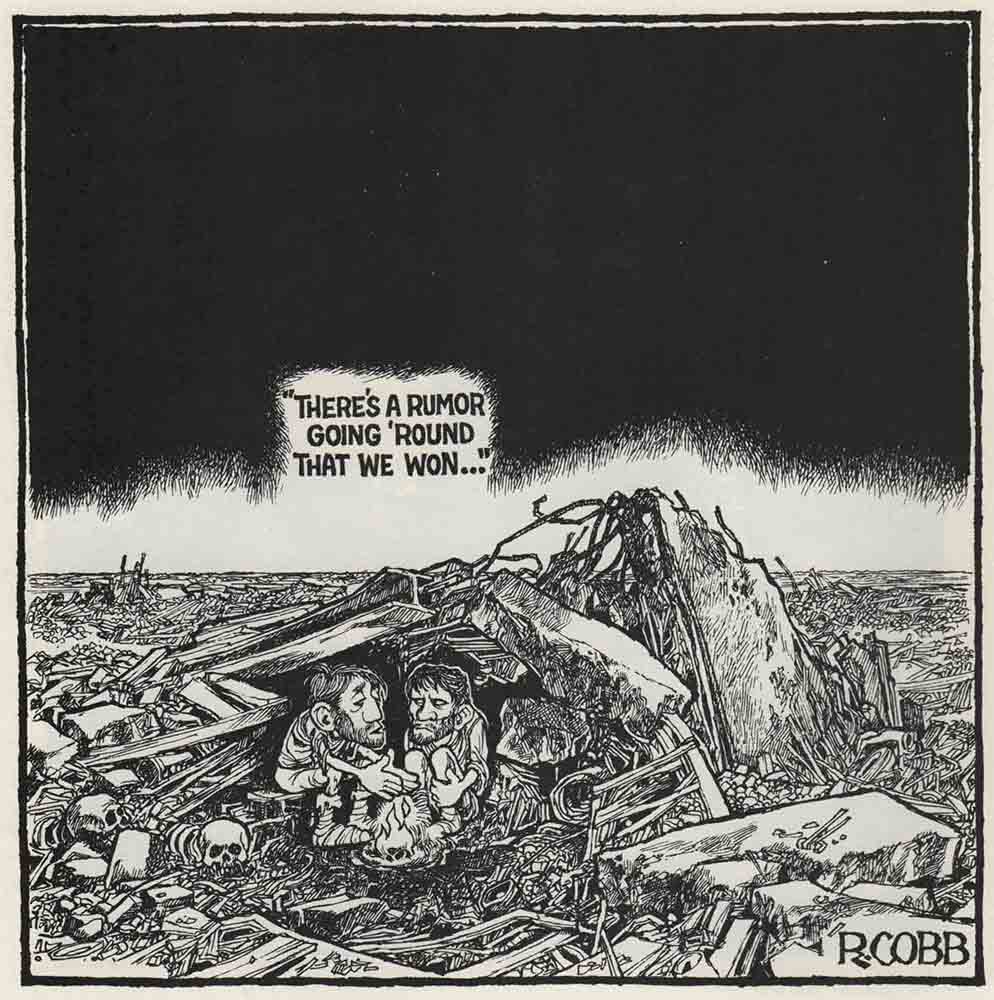
Time to cancel subscriptions to the Toronto Star
March 16, 2022 - #
I cancelled my subscription to the Toronto Star today. Here is the letter I sent explaining my cancellation:
I will not be renewing my subscription. This renewal notice arrived on the same day that the Star carried an editorial headed “Thinking the Unthinkable” which argues in favour of taking military actions which will greatly increase the risk of nuclear war. The editorial takes the position that “actions which were previously unimaginable” - i.e. military escalation up to and if necessary including nuclear war, should now be on our collective agenda. It seems that the Star’s editorial writers (and Rosie DiManno, in her article in the same paper) think that anything, up to and including the annihilation of most of the human race, and many of the other life forms on this planet, is preferable to sitting down with the Russians and negotiating a peace settlement in which all sides make compromises. This is insanity, and it is criminal.
The Star’s foreign coverage has always been appalling: pure pro-US/NATO propaganda, cheerleading for US/NATO interventions and war crimes in Iraq, Afghanistan, Libya, Syria, Yemen, etc. I stuck with the Star despite its massive failings as a newspaper because it provides some half-hearted coverage of local news, has one or two good columnists, and occasionally publishes good investigative journalism on local (Toronto/Ontario) issues.
I can no longer in good conscience provide any financial support to a newspaper that is doing its best to push us to nuclear war.
International Day of Action for Rivers
March 14, 2022 - #
March 14 is the 25th International Day of Action for Rivers.
The announcement says: “The International Day of Action for Rivers is a day dedicated to solidarity – when diverse communities around the world come together with one voice to say that rivers matter. That communities having access to clean and flowing water matters. That everyone should have a say in decisions that affect their water and their lives. That it’s our time to stand up for these rights, now more than ever. Rivers are key to restoring and maintaining the world’s biodiversity. River systems are the zone of Earth’s highest biological diversity.“
This is a cause I can whole-heartedly support. Rivers have always been special to me, starting perhaps when the ship that brought my mother and me to Canada sailed up the St. Lawrence River. The lower St. Lawrence is no longer the ocean, but it is not quite river yet, or perhaps it is both: it is in transition, as my life was in transition as we slowly headed up the river.
Growing up in Toronto, the Don River and all the little creeks that flow into it were special places that I loved to explore. I still return to them regularly. Later I branched out to the Humber and the Rouge. For many years, the Saugeen was the river closest to my heart: I canoed, kayaked, swam, and simply sat by the shore watching it. I watched it flow by in quiet tranquility – and I watched it rise more than ten feet in a few hours and triple its width as it flooded the land.
There are others: the Grand River flowing through Paris, Ontario, the little Kagawong River on Manitoulin Island, the majestic Saint John River (Wolastoq to the Maliseet) in New Brunswick, and the Exploits and Humber Rivers in Newfoundland – all of them are rivers I have come to have a special relationship with. The living waters of a river are among the most precious glories this planet has to offer. I am always drawn to rivers. I treasure them.
The photo is of the Saint John (Wolastoq) River near Hartland.

Two Minutes Hate
March 8, 2022 - #
Sometimes when the real world seems too overwhelming, it’s comforting to settle down with a novel, preferably some light escapist fiction, and just get away from it all. Like this old favourite:
“The next moment a hideous, grinding speech, as of some monstrous machine running without oil, burst from the big telescreen at the end of the room. It was a noise that set one’s teeth on edge and bristled the hair at the back of one’s neck. The Hate had started....
Before the Hate had proceeded for thirty seconds, uncontrollable exclamations of rage were breaking out from half the people in the room. The self-satisfied sheep-like face on the screen, and the terrifying power of the Eurasian army behind it, were too much to be borne: besides, the sight or even the thought of Goldstein produced fear and anger automatically. He was an object of hatred more constant than either Eurasia or Eastasia, since when Oceania was at war with one of these Powers it was generally at peace with the other....
In its second minute the Hate rose to a frenzy. People were leaping up and down in their places and shouting at the tops of their voices...
The horrible thing about the Two Minutes Hate was not that one was obliged to act a part, but, on the contrary, that it was impossible to avoid joining in. Within thirty seconds any pretence was always unnecessary. A hideous ecstasy of fear and vindictiveness, a desire to kill, to torture, to smash faces in with a sledge-hammer, seemed to flow through the whole group of people like an electric current.”
George Orwell, Nineteen Eighty-Four
How are the Germans keeping warm?
March 1, 2022 - #
With the invasion of Ukraine, how are the Germans keeping warm? They largely heat with natural gas, and much of the natural gas they use for heating comes from Russia.
Answer: Russia is continuing to send them natural gas, as always. Much of it transits Ukraine. Even as their soldiers fight each other, Russian and Ukrainian technicians are continuing to work together to keep the gas moving. Russian shipments have actually increased since the start of the invasion because of increased demand in Western Europe. It’s cold in winter.
The Americans want sanctions to prevent the Russians from exporting gas. Canada does too. Canada says it can build a LNG terminal on the east coast which could be used to ship gas to Europe – a few years from now. We’re always glad to help, especially if it increases the profits of the oil and gas industry.
Those who advocate sweeping across-the-board sanctions – better described as economic warfare – might want to consider the implications, i.e. who gets hurt. The Americans don’t care. Asked if she was bothered that at least half a million Iraqi children had died because of U.S.-imposed economic sanctions, U.S. Secretary of State Madeleine Albright said “we think the price is worth it.”
It’s always ordinary people who are hurt by economic warfare. This is all the more true in today’s highly integrated international economy.
Economic warfare kills people. Sending more weapons into a war zone also kills people, and in the present situation, increases the chances of all-out nuclear war breaking out.
We need negotiations, not escalation.
Nature Calendar March: Mallard
March 1, 2022 - #
I turned the page on my calendar this morning (the calendar featuring Miriam Garfinkle’s photos which I have been producing since 2019). Farewell to February’s Fox, which Miriam photographed in Algonquin Park when it was minus 25, and on to March’s Mallard, swimming vigorously in the sun-dappled waters of Grenadier Pond in Toronto’s High Park.
Then I went out for a walk. I heard a Cardinal singing, saw a Robin eating berries, heard and saw Canada Geese flying north. The wind felt a little like a breeze, rather than a blast from the Arctic. It felt like maybe, just maybe, Spring might be on its way. It lifted my spirits.
Oh, I know, the Cardinal has been here all winter, as has the Robin. So have the Canada Geese, who are probably just flying up from the lake to a favourite feeding spot, from whence they will return to Lake Ontario this evening. And there are many, many Mallards overwintering in Grenadier Pond, thriving on the food that helpful humans, including a certain five-year-old dear to my heart, bring to them on a regular basis.
But for all that, and all that: Spring is coming!

This is the March photo in the 2022 edition of Miriam’s Nature Calendar, featuring Miriam Garfinkle’s photos. If Mallards were rare, people would be out with their binoculars and cameras admiring these attractive birds. Because they are common, they get less attention. Miriam liked them, and was happy to photograph them.
Peace Agreement
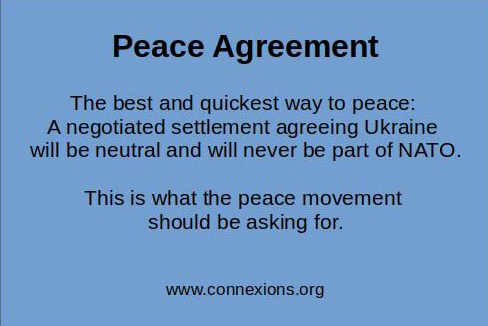
Further reading: Russia-Ukraine Resources: History, context and analysis of the crisis
The main enemy is at home
February 25, 2022 - #
“The main enemy of every people is in their own country!”
– Karl Liebknecht, addressing the anti-war movement in Germany after the outbreak of World War I
*
The outbreak of war is always a human disaster with unforeseeable consequences. The ‘fog of war,’ incessant propaganda, rapidly changing events, our own confused thoughts and emotions, all make it exceedingly difficult to know how to react.
Unfortunately war is by no means an unusual event, so we can look to the experiences of others in the past to see how they reacted to war.
The war that more than any other shaped the modern world was the First World War, called the Great War at the time. The beginning of the First World War was marked by a world-historic tragedy: the collapse of the Socialist International, all of whose members had pledged that they would oppose any imperialist war and call on the workers of all countries to refuse to fight their fellow workers in other countries. As soon as war was declared, the major socialist parties abandoned their principles and rushed to support ‘their’ country in the war. Only in Russia and Serbia did socialist parties stand firm in their opposition to war.
Prior to the war, socialists had been clear that the policies of all the major capitalist powers were pushing Europe toward war. The question was not whether there would be war, but when it would break out, and what particular incident would trigger it. In the years before 1914, there were in fact a number of close calls when war seemed imminent, only to be averted at the last minute when one side or the other backed down, or some face-saving compromise was found. For socialists, it was clear that all the capitalist powers would be responsible for the outbreak of the war they had been preparing for years, regardless of what side fired the first shot.
A small courageous minority maintained that position once war broke out. In Germany, Karl Liebknecht emerged as the leader of the anti-war socialists. The slogan which he made famous was “Der Hauptfeind steht in eigenen Land!” - “The main enemy is at home!”
Liebknecht said: “The main enemy of the German people is in Germany: German imperialism, the German war party, German secret diplomacy. The enemy in our own country is the enemy we must fight.”
Liebknecht’s message is just as valid today as it was then. For those of us who live in the U.S. Empire, that is, the United States and its NATO client states, including Canada, the main enemy is US/NATO imperialism, and our own countries’ complicity in that imperialism. This is the enemy we must fight.
*
This week’s events in Ukraine did not start a few days ago. They were the predictable, if not inevitable, outcome of US/NATO imperialism over the last 30 years. The dissolution of the Soviet Union in 1991 should have been quickly followed by the dissolution of NATO, if NATO had actually been the defensive alliance it claimed to be. The opposite happened: NATO not only remained in existence, but expanded, pushing relentlessly closer to Russia’s borders (Poland, Hungary, Czech Republic), and launching wars of aggression (Yugoslavia/Serbia, Afghanistan, Libya). This, it was clear, was an imperialist alliance aimed at world domination, and above all at Russia and China, the two countries most guilty of the crime of trying to resist U.S. domination.
It was not clear to everyone, of course. All-too-many liberals and activists followed in the footsteps of the socialists who had betrayed their principles in 1914, and cheered on the bombing of Serbia and Libya. Repeating slogans about “duty to protect” and “humanitarian intervention,” people who had once identified with the left were now cheering on NATO’s humanitarian bombing of civilian populations.
Russia tried for years to negotiate agreements that would respect its security. Again and again, the U.S. made it clear they had no intention of co-operating. On the contrary: they unilaterally backed out of arms limitations treaties such as the treaty covering intermediate-range nuclear weapons, announced plans for the militarization of space, and declared that they reserved the right to use nuclear weapons first, posing the nightmare threat of a first-strike attack on Russia.
Events in Ukraine pushed Russia to draw the line. The violent overthrow of Ukraine’s elected government in 2014 led to the establishment of a regime in which fascists and outright nazis played a significant role, especially in the armed forces. The new government moved immediately to remove the status of Russian as an official language. Violent attacks on the Russian-speaking minority by fascist militias became regular events, leading residents of the predominantly Russian-speaking Donbas to arm themselves and defend their territory.
From 2014 until 2022, Russian president Vladimir Putin sought a negotiated settlement, including autonomy for Donbas within a federal Ukraine, and binding guarantees that Ukraine would remain neutral, would not become part of NATO, and would not host missiles and other offensive weapons aimed at Russia. He continued to seek a negotiated settlement until early February 2022.
He was decisively rebuffed: the U.S. broke off negotiations; a large force of Ukrainian military and fascist militias began to mass on the borders of Donbas; artillery attacks against Donbas greatly increased; and – the last straw – on February 19 Ukrainian president Zelensky said Ukraine was considering acquiring nuclear weapons.
*
Like other wars, this one is the outcome of a long series of causes. What can we do now that it has started?
That depends, of course, on who ‘we’ are and where we live. Courageous people in Russia have taken to the streets to protest the war. Russian members of the International Marxist Tendency have issued this statement of opposition to the Russian intervention. They have bravely taken on their responsibility to oppose military intervention by their government.
There is no need for those of us who live in the American Empire to devote energy to denouncing Russia. The entire corporate and state media around the world are already doing that. A few voices on the left echoing what the Empire’s worldwide propaganda apparatus is already saying are meaningless. The only advantage to doing so is that it takes no courage.
Our duty, I suggest, is to heed Karl Liebknecht’s call: “The main enemy is at home.” That enemy – U.S. imperialism, NATO, Canada’s complicity, and the military-industrial complex – is the enemy we must fight. It’s a hard thing to do, and it takes some courage, perhaps, but it’s something that could perhaps make a difference in the long run.
Ulli Diemer
Related Reading:
Russia-Ukraine Resources: History, context and analysis of the crisis
Experts Warned For Years That NATO Expansion Would Lead To This
John Mearsheimer on the siuation in Russia and Ukraine
US Foreign Policy Is a Cruel Sport
War in Europe and the Rise of Raw Propaganda
Keywords: Intervention – NATO – Russia – Ukraine – U.S. Imperialism

Situation Normal – February 24, 2022
News from the real world and beyond
February 24, 2022 - #
Deep thinking about what the census shows # The Toronto Star has published an in-depth analysis of the latest census data for Toronto, looking specifically at which areas of the city have grown in population in the last five years, and which areas have remained more or less the same. The startling conclusion – you may want to sit down before reading further – is that those areas of the city which have seen a lot of highrise construction have grown in population. The population of those areas which haven’t seen new highrises go up has tended to remain stable, or in some cases even declined a little. Who would have thought? Thank goodness we have journalists to figure these things out.
Of course, no feature article in the Star is complete without some finger-pointing and blaming. Karen Chapple, director of the University of Toronto’s school of cities, is glad to oblige. “What’s happening there [in the stable-population areas] is exclusion,” says Chapple. When existing residents ‘hold tight to their homes’, she said, prospective new residents are effectively shut out. In other words, people who live in the same house or apartment year after year, rather than making room by being considerate enough to die or at least move into a nursing home, are guilty of causing social harm.
One has to ask: isn’t that true of everyone who isn’t actually homeless and living on the street? Doesn’t Professor Chapple live in an apartment or a house? Isn’t she just as guilty of ‘excluding’ someone else from moving in by selfishly continuing to ‘hold tight’ to her home?
Measuring Canada’s climate change progress # If you’re wondering how Canada is doing in meeting its stated targets for cutting greenhouse gas emissions, here is a summary from the business press, in one easy sentence: “The Canadian Association of Petroleum Producers says it expects a 22 per cent increase in natural gas and oil investment in 2022.”
Netanyahu's legacy # An Associated Press (AP) story, carried by many corporate media outlets, reports that former Israeli Prime Minister Benjamin Netanyahu is seeking to negotiate a plea deal in his bribery trial. The goal is to avoid an “embarrassing and protracted trial,” says AP, that “risks tarnishing his legacy.”
Isn’t that rather like worrying that a shoplifting conviction could “tarnish” Jack the Ripper’s legacy?
In related news, Israel has announced that it is setting up a national inquiry after it was reported that Pegasus, a cellphone hacking tool made by an Israeli company, had been used to obtain information from Netanyahu’s confidants and other public officials. It was reported last year that Pegasus is being used against journalists and human rights activists in countries guilty of human rights abuses. That’s fine, of course, but targeting elite members of the regime is not. Pegasus, said Israeli Prime Minister Naftali Bennett, was “not intended to be used in phishing campaigns targeting the Israeli public or officials.”
Glorification of Nazism # On December 16, the United Nations voted on a resolution to condemn the “glorification of Nazism.” Only two countries voted against the motion: the United States and Ukraine. The United Kingdom and Canada abstained.
Facebook threatens to leave Europe # Meta Platforms is threatening, once again, to shut down Facebook and Instagram in Europe if the European Union insists that users’ data be stored in Europe, not in the United States. European Union regulators are demanding the move because of a lack of privacy protection in the U.S. Meta claims that if these rules are imposed it would “likely be unable to offer a number of our most significant products and services, including Facebook and Instagram, in Europe.” The real issue is advertising revenue: Meta fears that it would not be able to sell as much advertising, or to target it as effectively, under the stricter European privacy rules.
We are left to wonder: How long could Europe survive if Europeans couldn’t use Facebook or Instagram? The whole world is holding its breath.
“No rule was ever broken” # Ian Scott, the chair of the Canadian Radio-television and Telecommunications Commission (CRTC) is digging in to defend himself in the face of calls for him to be removed from his post, or at least required to recuse himself from deliberations related to Internet competition. This is after it was revealed that Scott met in a bar with a senior Bell Canada executive while the CRTC was in the midst of making decisions about the fees that smaller Internet service provides pay to Bell and other large companies. Scott, himself a former executive in the field he is now charged with regulating, has responded by saying that “no rule was ever broken.” That may well be true, but if that’s the case, perhaps it’s time for some new rules, including rules prohibiting former executives being allowed to hold positions regulating corporations they used to work for.
Through the lens of clichés # Every topic that attracts any attention is now being looked at “through a lens” of one kind or another. Like every cliché that becomes popular, looking at things “through a lens” is now dropped into “conversations” about pretty well anything.
An article in the Toronto Star about the problem of snow that blocks driveways after snowplows have gone by proclaims that it will approach this and other problems by “taking ideas from other places and running them through the lens of Toronto.” It’s not clear how you ‘run things through a lens’, but if it is possible, one wishes the Star would occasionally run its articles through the lens of a copy editor.
Curated Ears # Once upon a time, a curator was someone who managed a collection in a museum or similar institution. Curating was what they did. Now everything that involves selecting or displaying anything, anything at all, is known as curating. The latest is “curated ears.” When I first saw the headline, I thought someone had set up an ear museum along the same lines as the penis museum in Iceland. But no: curated ears are when you wear earrings that you chose carefully and really like. I get it: I have a carefully curated drawer full of socks. It’s a very selective: only socks that don’t have holes are included.
Refreshed and enhanced # A tax form I received from a financial institution informs me that their Account Agreement & Disclosure Document has been “enhanced.” It’s part of an initiative aimed at “refreshing” investment industry rules. I already feel refreshed, just from reading about it.
What I’ve Been Reading
Modern Politics, by C.L.R. James
This is the text of six lectures that C.L.R. James gave in Trinidad in 1960. James covers a vast canvas, from ancient Greece to Marxism and the modern world. He deals with complex topics, which he explains in clear language. He respects his audience, and expects them to work a bit to get the most from what he presents. I heard C.L.R. James speak in Detroit in the 1970s, and was impressed on that occasion too by the richness of his thought. I find I can always return to James’ writings, and get something new out of them.
When Memory Speaks, by Jill Ker Conway
The subtitle of this book is “Exploring the Art of Autobiography.” Conway looks at a diverse selection of memoir writers, whom she groups under chapter headings such as “The Romantic Heroine,” “Feminist Plots,” “Assertive Women,” and “Grim Tales.” Her comments on her subjects shed light on them, and the cultural context in which they find themselves. Conway is a historian, thank goodness, rather than a literary critic, so she writes well and interestingly.
Remembering Frank Showler 1919-2022
February 15, 2022 - #

I first met Frank Showler in 1975. I had just started a new job at Seven News, a community newspaper in the east-of-downtown area of Toronto. Frank was on the Board of Directors and, if I remember correctly, he was also one of the 200-odd volunteer distributors who together delivered 20,000 copies of the paper door-to-door on their streets or in their apartment buildings every second week. Frank was one of the elders, a steadying influence in guiding the paper. I was sometimes assigned to cover community events, and often I would run into Frank and Isabel at those events. I think I was impressed that older people were still so active.
Running into Frank became a predictable occurrence over the years and decades that followed. As people, including Matthew Behrens in his lovely tribute to Frank, have said, no protest or demonstration that took place in Toronto could be considered to have really happened unless Frank was there. But of course Frank was always there, and so I could be sure that the protest I was at was really happening.
In more recent years, I ran into Frank most often at the weekly Friday vigils in front of the Israeli consulate on Bloor Street. My partner Miriam took part in those vigils week after week, month after month, year after year. Originally the group was known as Jewish Women Against the Occupation, but eventually participation broadened, and stalwarts like Frank and Chandler Davis became regulars. They were relentless in their determination to fight for justice for Palestinians. I would sometimes come to the vigil, occasionally to participate, more often to meet Miriam so that we could head off to dinner together afterwards at Maroli or some other favourite place.
In August 2014, I was at Frank’s 95th birthday party at Friends House. Many of us came out to honour Frank and indulge in the food. There came the point where Frank was called on to make a few remarks. If we were expecting a few brief pleasantries, we were mistaken. Speaking without notes, Frank told us how he came to his beliefs and where they had led him. I did not agree with everything he said: unlike Frank, I thought, and still think, that it was necessary to fight a war to defeat Nazi Germany. But it isn’t necessary to agree about everything to respect and work with others, and Frank was a person whose commitment to justice and peace was unwavering and remarkable.
Miriam told me about being with Frank at a ‘toxic tour‘ at Aamjiwnaang in September 2015. Aamjiwnaang is situated in the midst of Ontario’s “Chemical Valley,” a sprawling complex of petrochemical plants near Sarnia. Residents of Aamjiwnaang have to deal with high incidences of cancer, asthma, and other health effects of toxic pollution. The term ‘environmental racism’ might have been coined specifically to refer to Aamjiwnaang. The ‘Toxic Tour’ was arranged to highlight the problems – and the source of the problems – and to organize broader action. The tour was a walking tour along long dusty stretches of industrial roads. It was a very hot day, and there was a bus for those who were unable to walk the distance. Frank, 96 at the time, walked. After a while, Miriam noticed that he seemed to be struggling in the heat. She got him to drink water, and then convinced him to take the bus for the remaining distance. She persuaded him that his presence, his act of solidarity, would be just as valuable and appreciated if he rode on the bus.
That was Frank: if there was injustice, he was there, doing his part. His memory will be with us for a long time.
World Hippopotamus Day
February 15, 2022 - #
February 15 is World Hippopotamus Day. It is a day to honour the hippopotamus and support action to preserve hippos, which means preserving their habitat, protecting them from poaching, and minimizing conflicts between humans and hippos.
Once thought to be related to pigs and other even-toed ungulates, we now know that the hippo’s closest living relatives are actually whales, from which they diverged about 55 million years ago.
Appealing as they look in their own pudgy way, it is best to stay well clear of them. In Africa, about 500 people are killed by hippopotamuses every year, which makes them significantly more dangerous than lions and other large carnivores. They are short-tempered and aggressive, especially when protecting their young. If a boat enters their territory, they may overturn it and kill the occupants. On land, they can easily outrun the fastest human. Admire them from a distance.
But left alone, they are amazing creatures. We should all be grateful for that day 55 million years ago when evolution gave a whale a tiny nudge in a different direction, starting a development which eventually led to the wonderful hippopotamus.
World Bonobo Day
February 14, 2022 - #
February 14 is World Bonobo Day. Bonobos are close relatives of chimpanzees, and the choice of February 14, Valentine’s Day, to honour them is no coincidence. Bonobos are the world’s sexiest primates, who live according to the philosophy “make love, not war.” Unlike their big-brained relatives, chimpanzees, gorillas, and humans, bonobos have been smart enough to develop a culture that is free of violence.
They are living proof that the claim of socio-biologists that all great apes, including humans, are genetically pre-disposed to be violent and wage war, is wrong. Bonobos have found another way: touching, caressing, and sex. Especially sex. As Susan Block says “These loving, sensuous apes have as many kinds of sex as humans do, in a veritable Bonobo Sutra of positions, including face-to-face, with multiple partners and in all combinations, as bonobos are bisexual or pansexual.” “But it’s not just how they have sex that makes bonobos so important, especially to humans. It’s how they use sex: for barter, friendship, stress-relief, anger management, conflict resolution and even political positioning that allows the females to gently dominate the males, and to prevent murder and war in their communities... no bonobo has ever been seen killing another bonobo in the wild or in captivity. Their uncanny ability to make ‘peace through pleasure’ is intrinsically related to their sexuality.”
One of their unique behaviours is what observers have dubbed ‘The Bonobo Handshake,’ that is, social sexual contact. "To strengthen their relationships, females will rub their genitals together. If anyone in the group, male or female, is feeling stressed, anxious, or irritated, someone will run over and give them a ‘bonobo handshake.’ This kind of conflict resolution seems to be at the heart of their peaceful society.”
There is one shadow: the bonobo population is declining because of the pressures of habitat loss and hunting. There are several organizations and foundations working to protect bonobos and their habitat, which many other species share. See www.blockbonobofoundation.org or www.bonobos.org.
In the meantime, Happy Bonobo Day! Enjoy!
Freedom Convoy
February 5, 2022 - #
I went to the “Freedom Convoy” rally in Queen’s Park today. I was working in the office this morning, just a block from Queen’s Park, and I went over to have a look. Given the media hysteria, and the dire warnings from police and politicians, I was curious to see for myself what it would be like. In the unlikely event that I am ever called upon to share my wisdom as an elder, two of my teachings would certainly be “The media lie” and “The police are not your friends.” Rather than trust them, I prefer to see for myself.
My first impression, heading into Queen’s Park North from the east, was visual: a sea of red and white, hundreds of Canadian flags. Once I got close enough to mingle into the crowd, I began to smell marijuana smoke. Lots of marijuana smoke. It’s a smell I find quite pleasant, as it happens. Brings back fond memories.
And now there was sound: Indigenous participants in the protest were doing a welcoming ceremony, drumming and chanting. They invited the crowd to join in, and hundreds of voices rose up together. It was a powerful moment.
There was more singing. A professional singer (I won’t mention her name to protect her from being subjected to online abuse) led the crowd in singing O Canada. That was followed by loud cheering.
Of course, since this was a protest, there were inevitably speeches. I have an extraordinarily low tolerance for listening to speeches, so I listened with half an ear while circulating through the crowd. I always do that at demonstrations: I don’t like standing in one spot very long. You also get to meet more people if you move around.
My overriding impression was one of cheerfulness. Smiles and laughter. Good vibes. I suspect for many of the participants, this opportunity to come together was a welcome break from being isolated because of their views and demonized by the media. For once, they were among people who weren’t hostile.
Nature Calendar February: Red Fox, Algonquin Park
February 1, 2022 - #
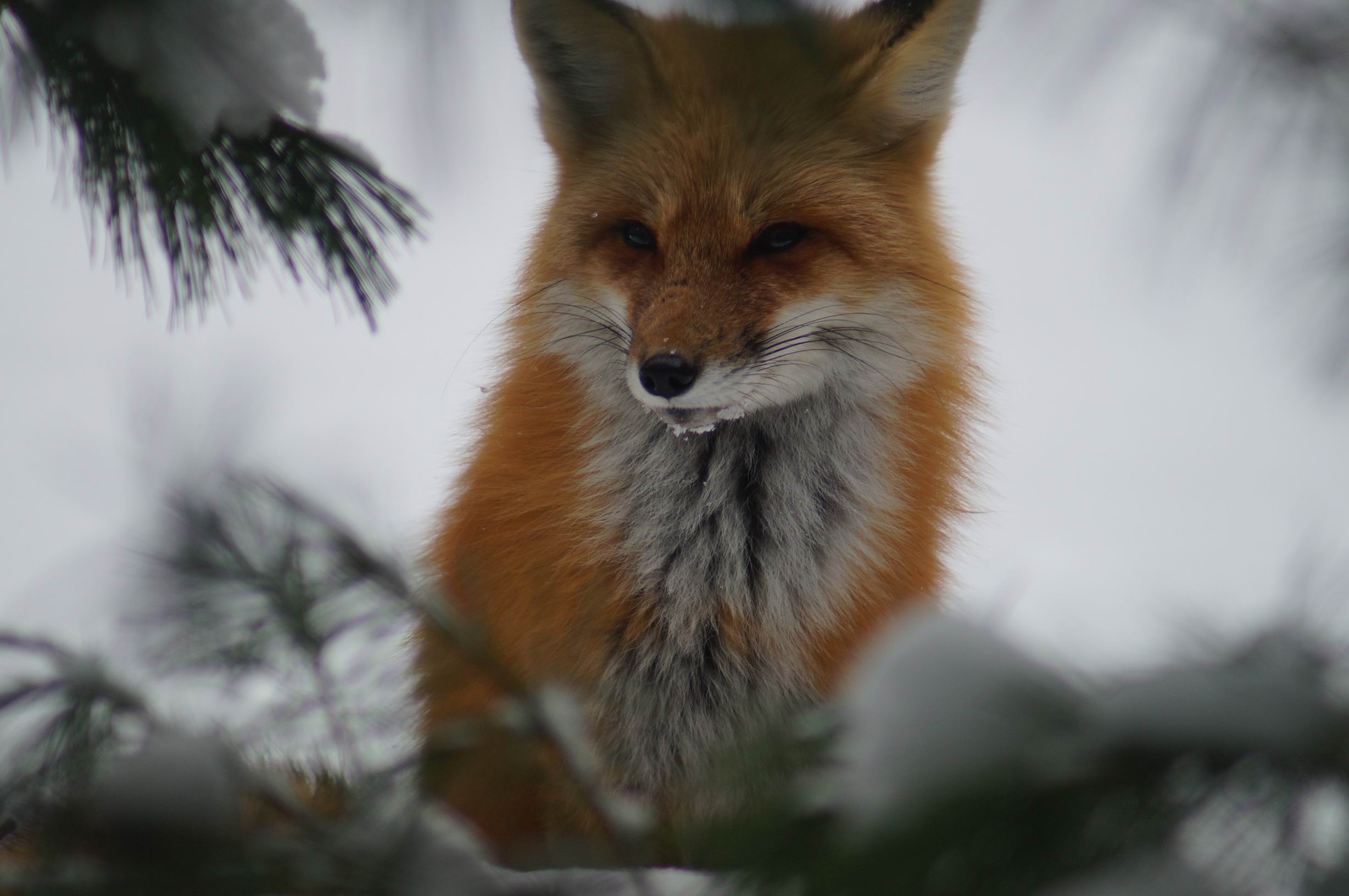
Miriam’s Nature Calendar, February: Red Fox, Algonquin Park.
This is the February photo in the 2022 edition of Miriam’s Nature Calendar, featuring Miriam Garfinkle’s photos. It was taken in February 2016. We were spending a few days in Algonquin Park, staying in the Mew Lake Campground. We were in a yurt, but there were also about a dozen tents, occupied by people hardier than we were. Many of the tents had little wood stoves, adapted to use in a tent, complete with little chimneys. People also had little camping cots in their tents which kept them off the ground. And then there were a few really hardy folks, who eschewed any of these sissy concessions to comfort, and embraced winter camping in its purest form. We admired them, but felt no desire to emulate them. At least I didn't; Miriam was made of sterner stuff, even while battling metastatic cancer, and might have given winter camping in a tent a try if she’d had a braver partner.
In any case, I was glad we had a yurt to sleep in. It was cold during our stay there, dipping to minus 33 at night, warming up to minus 25 during the day. We’d set out on our snowshoes or skis every morning, taking sips of water early on, because after an hour or so, our water bottles would be frozen. We encountered little wildlife on our outings except – of course! – chickadees, those hardy little survivors, sounding cheerful even in the bitter cold. And we saw this fox, which Miriam spotted under an evergreen. It didn’t seem to be perturbed by our presence, or by her camera.
Joyce Nelson
January 17, 2022 - #
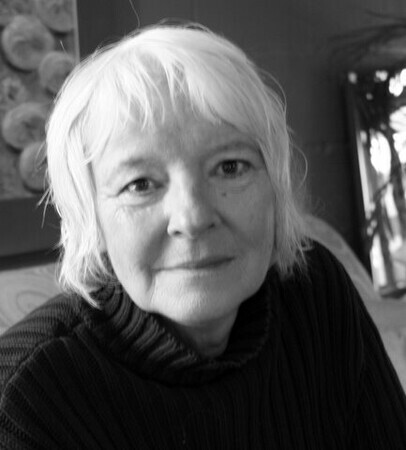
I just heard the sad news that Joyce Nelson died on January 4. I will miss the stimulating conversations we used to have when we met for coffee, and the many valuable and well-researched articles and books that she wrote.
Most recently, her writings were focused on the climate emergency, and especially the enormous carbon bootprint of the military, such as her April 2021 article For real climate action, let’s look at the military elephant in the room
Joyce wrote seven books, as well as hundreds of articles and radio documentaries. I especially recommend her two most recent books, “Beyond Banksters: Resisting the new feudalism” and “Bypassing Dystopia: Hope-filled challenges to corporate rule.”
Joyce was also a painter, and sometimes those lives overlapped. The book launches for the two books mentioned above were held in the art gallery which sold some of her paintings.
Kim Elliott writes about Joyce on the rabble website.
Laura Sky has written a lovely tribute to Joyce, also on rabble.
Barrie Zwicker writes:
This is an unwelcome shock. Joyce and I were to have another lunch at The Outrigger but she cancelled because she had “a nasty cold coming on.” She’d given me permission to reprint her article “The Military’s Carbon Bootprint” in the forthcoming 4th edition of my monograph War, Peace and the Media. The first edition was published in 1983. With each revised and expanded edition the articles have reflected the unholy persistence of militarism. The 4th edition is retitled QUESTIONS OF SURVIVAL: War, Global Heating, Pandemics and the Media. In Joyce’s piece, originally published in the February-March 2020 issue of the Watershed Sentinel, she asks: “As the biggest single user of fossil fuels [on the planet], why is the military exempt from the climate discussion?” If anything, her piece remains stronger than ever. It can be found at watershedsentinel.ca/articles/the-militarys-carbon-bootprint She’ll be suitably recognized in the 4th edition. As a publisher – and former freelancer – I have a more than a clear conscience about the amount of the republication fee I chose to pay Joyce. Rest in peace, wonderful peacenik Joyce.
Joyce’s political and artistic voice and imprint will be sorely missed by me. Recently I hung on my living room wall one of Joyce’s paintings that I had purchased. I will never forget deciding to purchase it at a Fall display of the Beaches Arts & Crafts Show. I didn’t know its title at that point. Joyce asked me what it brought to mind. I replied that the word Portal came into my mind. “That’s it. That’s the title,” she replied.
Now she’s gone through a major portal.
Books by Joyce Nelson
The Perfect Machine: TV in the nuclear age
Sign Crimes/Road Kill: From Mediascape to Landscape
Sultans of Sleaze: Public Relations and the Media
Beyond Banksters: Resisting the New Feudalism
Bypassing Dystopia: Hope-filled challenges to corporate rule
A few of Joyce’s recent articles
The military’s carbon bootprint
The NED’s Useful Idiots
Saugeen Ojibway Nation Has Saved Lake Huron From a Nuclear Waste Dump
How Canada “Fights Tax Fraud” by Legalizing It
Venezuela: Target of Economic Warfare
For real climate action, let’s look at the military elephant in the room
A poem that Joyce wrote in 1996 (quoted in Laura Sky’s tribute to Joyce):
Already I know
that when the time comes
and my body falls away like a husk
I will rise like the heron
my blue wings graceful
and astonishing
while below the ocean endlessly
swells and rolls.
Nature Calendar January: Woodpecker
January 1, 2022 - #
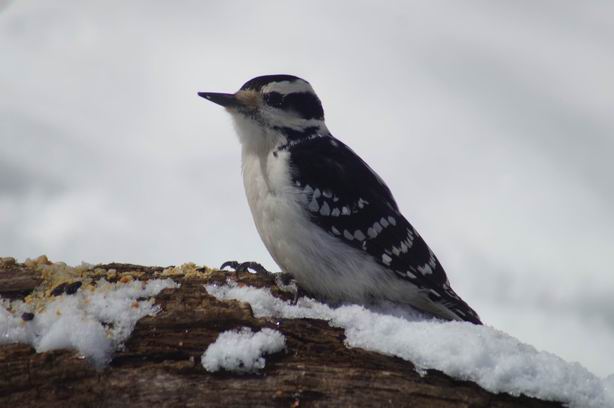
Miriam’s Nature Calendar, January: Woodpecker.
Toronto’s High Park is a refuge for birds that stick around through the winter, such as Great Horned Owls, cardinals and robins. Mixed flocks of chickadees, nuthatches, and woodpeckers move through the park looking for food, which in the winter also includes seeds and nuts provided by humans. Miriam always carried a container of seeds when she went to High Park. Photo by Miriam Garfinkle.
Things are getting better and better and bettxrxr and bxzyxxx
December 18, 2021 - #
For the past few days, every time I log in to Facebook, it pops up a message that I am logging in from an unknown device and have to go through a security check (they send me a code via email which I have to submit to be let in). As it happens, these days I always use the same computer, sitting on top of the same desk, with the same mac address, same network card, same IP address, and same browser.
On the other hand, when I was travelling in the Atlantic provinces in the summer, and infrequently logging in, with a different computer, using the WiFi network at whatever campground or B&B I happened to be in, Facebook was happy to let me in without a security check.
Such are the glories of Artificial Intelligence. This is the corporation governments are now pressuring to use the prowess of their Artificial Intelligence to censor what users are allowed to say.
Certainly Facebook isn’t alone in its ability to screw up seemingly simple things. I have been updating a number of business and personal accounts recently, for example by updating contact information, or switching some payments from one credit card to another. Simple changes, which usually involve going online or calling a 1-800 number.
From these experiences, I have learned a few things about the companies I have been calling:
1) They are experiencing a higher volume of calls than usual.
2) They have been experiencing a higher-than-usual volume of calls for years.
3) They won’t be hiring any more staff to handle the usual, higher-than-usual, volume of calls.
4) They have changed their options to serve me better.
5) The new improved options don’t allow me to do what I need to do any better than the old unimproved options did. They may in fact be worse.
6) In addition to a website and an 800-number, some of them also have an app (an “award-winning app” in the case of one company I called today: the recording mentioned the “award-winning app” three times before it allowed me to choose an option, whereupon I was cut off).
7) The award-winning app doesn’t allow me to do what I need to do either.
(It also doesn’t tell me who bestowed the award on their app, or what the criteria were. I certainly know that the customers weren’t invited to vote on the award.)
8) Sometimes you will be offered an online chat option. To use it, you will first have to choose from a list of topics.
9) None of the choices will apply to your problem.
10) The overworked and underpaid people who answer the phones, if you manage to get through to one (they are often your only hope when the websites and award-winning apps don’t let you do what you need to do) are well aware of how glitchy the systems are. On two occasions this week, the person I was dealing with hurriedly gave me a phone number (different from the main 1-800 number) to call back on “just in case you get cut off during the call.”
11) It’s not going to get better. Ever.
12) We need to overthrow capitalism.
Anti-Vaxxer Protest
December 4, 2021 - #
I went in to the Connexions office this morning to meet one of our volunteers. I stayed until around 1:00, then headed homeward, walking as usual. My route takes me across Queen’s Park North. I heard an amplified voice as I approached (“Freedom! Freedom!” the voice was saying, repeatedly), and noticed that there was a small crowd gathered at the foot of the statue of the horse, the horse that has a guy (Edward, I think his name is) sitting on top of him.
Right, an anti-vaxxer protest, though I’m not sure that “anti-vaxxer” really captures the full range of views represented by the people there, judging by the signs and banners on display. It was a fairly small crowd, maybe 100 people. There was a Trump banner, a number of Australian flags, and a few signs more notable for their passion than the subtlety of their messaging. I don’t wanted to be blocked by the community-standards police, so I’ll just say that a certain F-word appeared on several signs, followed in one case by “COVID” and on another by “Trudeau.” Several signs referred to “human experimentation.” That would be one way of describing my whole life, but these signs were strictly about vaccines, not the long and winding road most of us travel as we make our way through life.
I stayed for a while to watch and listen.
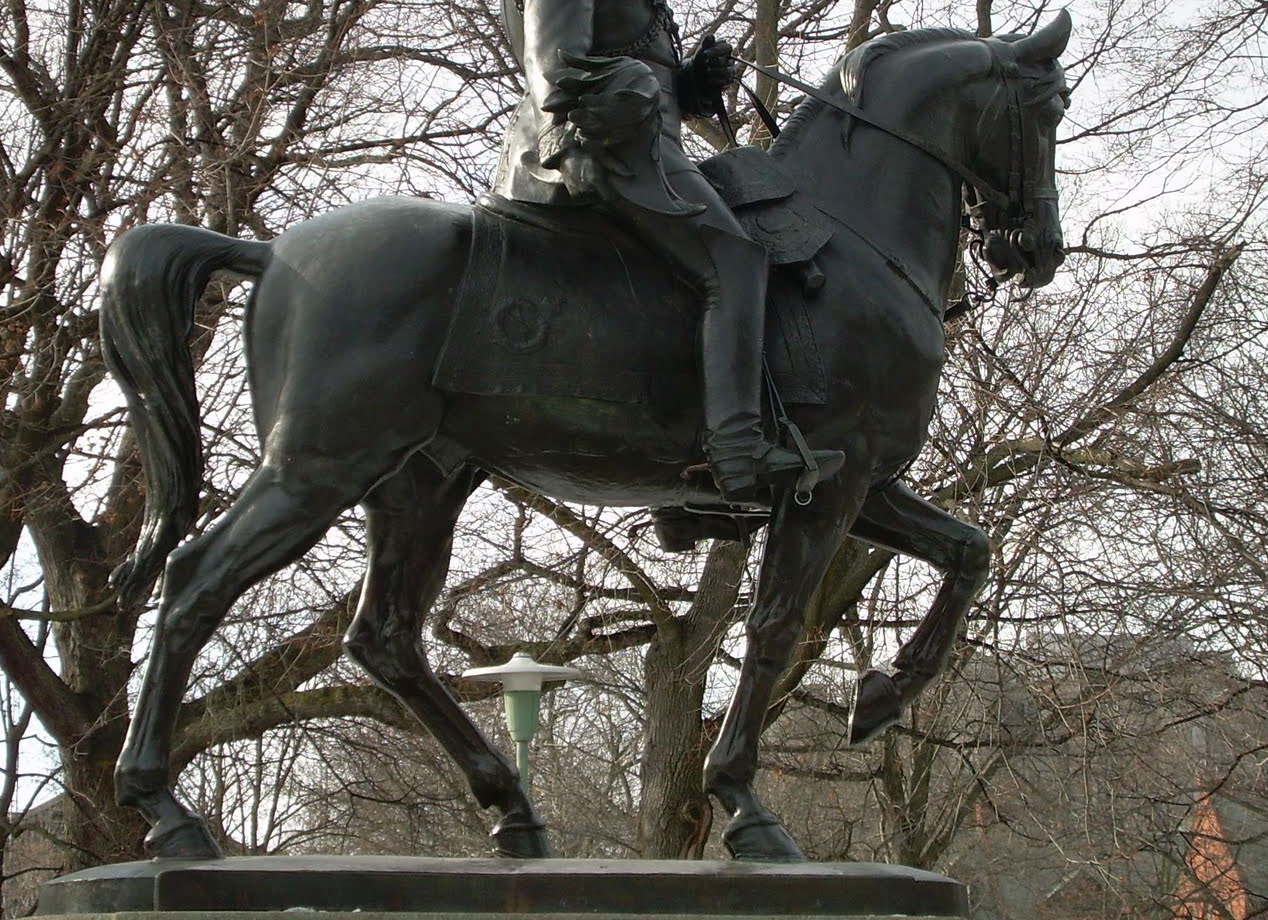
Nature Calendar December: Chickadee
December 1, 2021 - #
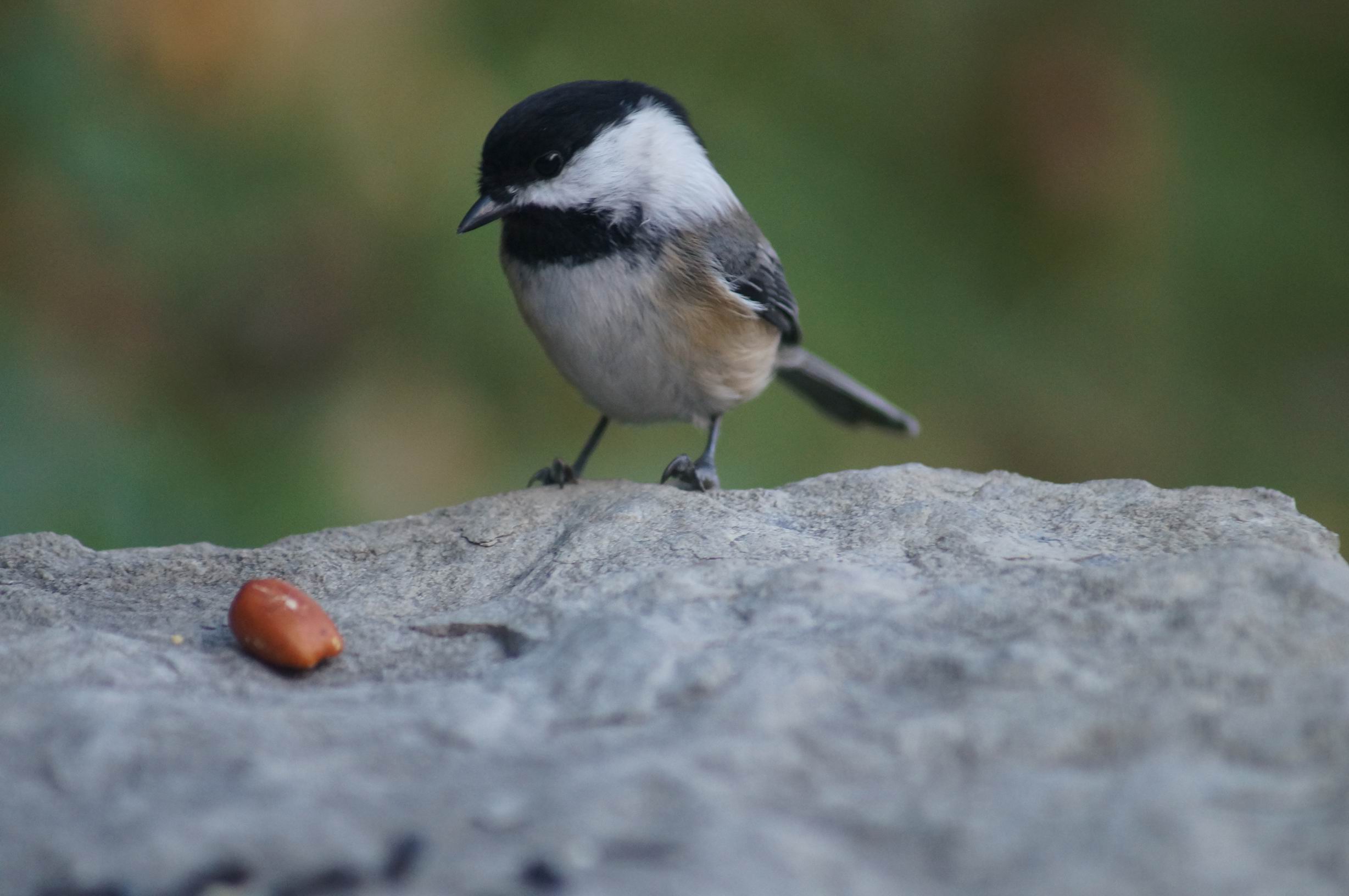
Miriam’s Nature Calendar, December: Chickadee.
Miriam’s love of nature encompassed an infinite variety of places and creatures. But chickadees had a special place in her heart. She loved them. Much as she had a passion for swifts and many other birds, chickadees were the birds she could most relate to. Their curiosity, friendliness, and tenacity matched her own way of being in the world. They were soulmates. Photo by Miriam Garfinkle.
Following the Science? Other Voices, November 13, 2021
November 13, 2021 - #
The November 13 edition of Other Voices, the Connexions newsletter, which I edit, went out by email today. You can see it online here.
“Following the science” has been the mantra of public officials from the very beginning of the pandemic. Their acknowledgement of the importance of science has been a refreshing change from the usual attitude of so many political leaders, who all too often regard science, and scientists, as an annoyance or a threat. But what does “following the science” actually mean? When we as a society are faced with difficult policy choices, can science tell us what choices we should make?
Articles in this issue of the newsletter look at science and society in the context of climate change and the COVID-19 pandemic.
Also in this issue is information about political prisoners currently held in jail by the United States and its partners in committing human rights abuses. Articles shine the spotlight on the cases of Steven Donziger, Craig Murray, Daniel Hale, Leonard Peltier, and Julian Assange.
The featured film in this issue is John Pilger’s The Coming War on China, and the featured book is Big Farms Make Big Flu: Dispatches on Infectious Disease, Agribusiness, and the Nature of Science by Rob Wallace.
The November 13, 2021 issue of Other Voices is online at www.connexions.org/Media/CXNL-2021-11-13.htm
I wrote an introduction to this issue, also titled “Following the Science?” You can read it here
.Nature Calendar November: Kakabeka Falls
November 1, 2021 - #

Miriam’s Nature Calendar, November: Kakabeka Falls, 2016.
One of the best things about Kakabeka Falls, the second-highest waterfall in Ontario, is that it has escaped the commercialization of Niagara. We stood at the edge of a forest, watching the Kaministiquia River plunge over the rocks. Miriam took photos, and then we had a picnic. Photo by Miriam Garfinkle.
Light and Darkness: Other Voices, October 13, 2021
October 13, 2021 - #
The October 13 edition of Other Voices, the Connexions newsletter, which I edit, went out by email today. You can see it online here. The introduction to the issue appears below:
The featured book is this issue of Other Voices is Diana Johnstone’s memoir Circle in the Darkness. The title is inspired by Albert Einstein’s observation that “as our circle of knowledge expands, so does the circumference of darkness surrounding it.”
As Einstein, and Johnstone, remind us, the more we learn, the more we realize how little we know. Each question we answer opens the door to more questions, because there are always more questions than answers. We are called upon to attempt to answer at least a few of the questions that seem important to us, but we do well to keep in mind that our answers are tentative and incomplete, always subject to revision in the light of further investigation. It can be difficult to remain critical, and self-critical, but self-righteousness and absolute certainty, no matter how emotionally satisfying they may be, only do harm, to ourselves, and to those we interact with.
This issue of Other Voices offers some fragments of knowledge and insight, and it also raises questions.
David Rovics observes that, in his view, people on the left and on the right have a lot in common, such as opposition to the elites that are destroying the lives of so many around the world. Why, he asks, do they respond to the same problems in such different ways? Why do they direct so much of their anger against each other, rather than against those who rule?
Cedric Johnson raises a similar concern: blackwashing, that is, the corporate embrace of anti-racist rhetoric, which works to present those who produce and benefit from gross inequalities of wealth and power as allies. If we fall for this, says Johnson, we will inevitably be fighting each other for crumbs, while the rich and powerful get richer and more powerful.
Amory B. Lovins offers a fact-filled critique of the idea that “clean” nuclear power can be a climate “solution.” He shows that nuclear power is much less efficient than solar and wind power, and that investing in it inevitably comes at the expense of more investment in better solutions. In any case, the best solution, by far, as he points out, is using less energy, not producing more. He also makes the important point that new nuclear plants would not come into service until the late 2030s - far too late to make the changes that we have to make now.
In “The Day the World Ended,” Caitlin Johnstone asks us to think about the unthinkable: nuclear war.
In the aftermath, she writes, there will be “No one left to recognize the mistake, to grow as a result of that recognition, and to rise above it. No one left to realize how staggeringly insane it was to flirt with the end of the world for the sake of power, how arrogant it was to think that we could remain in perfect control of all those weapons for decades on end without something going wrong amid our reckless games of nuclear chicken.”
So do it now: “Pursue a life of excellence and live each moment like it could be your last, because of course it could. And above all make sure you do everything in your power to raise awareness and oppose the insanity of the situation we now find ourselves in.”
And on that cheerful note, Happy Thanksgiving!
Ulli Diemer
The October 13, 2021 edition of Other Voices is online here.
Nature Calendar October: Grouse
October 1, 2021 - #
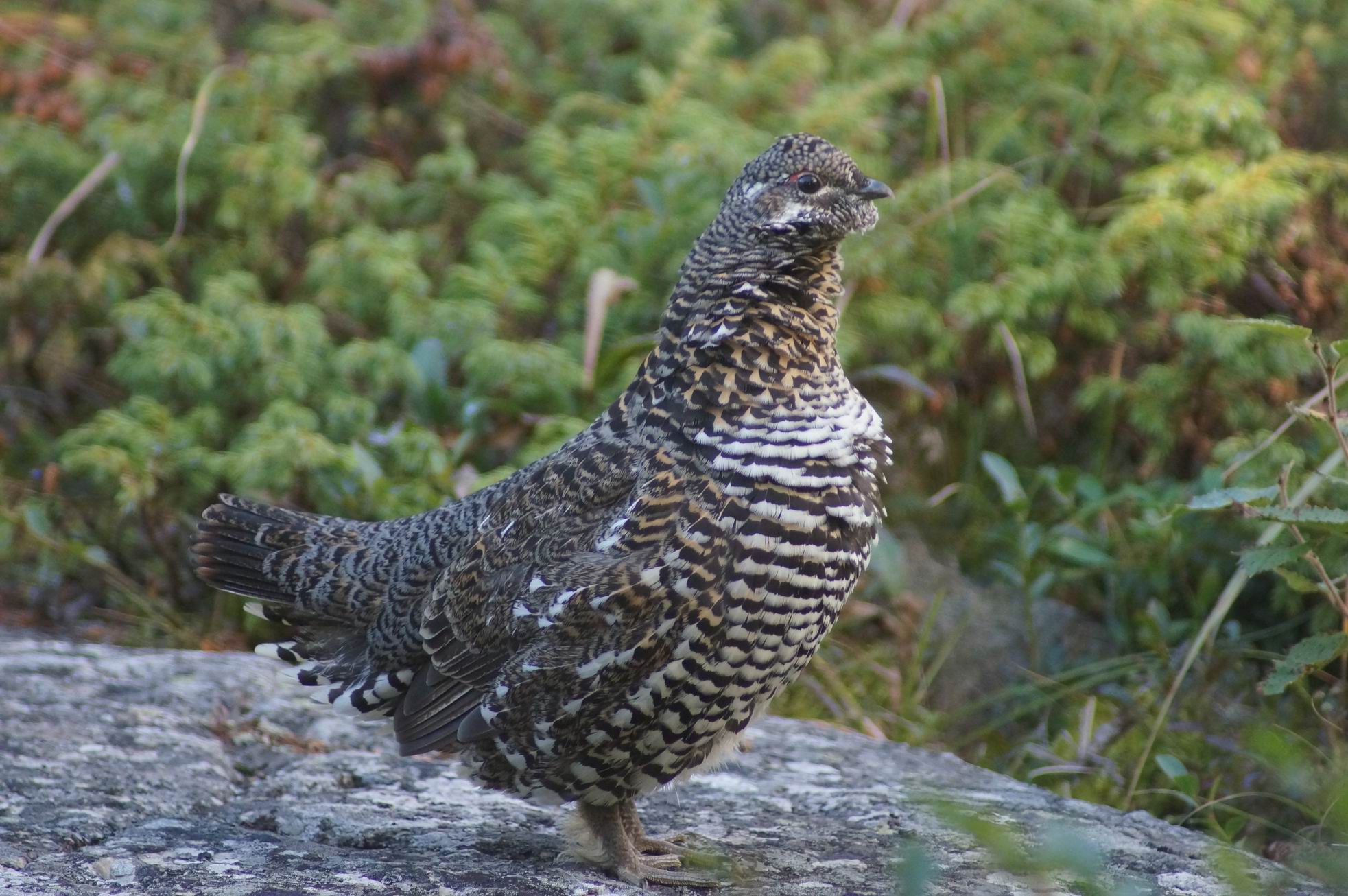
Miriam’s Nature Calendar, October: Grouse, Pukaskwa National Park, 2016.
“You can’t see me!” Sometimes it’s easy to get a photo of a grouse, because their strategy for avoiding detection is to stand completely still. This grouse in Pukaskwa obligingly stayed put while Miriam took several photos. Photo by Miriam Garfinkle.
Nature Calendar September: Milk Snake, Bruce Peninsula
September 1, 2021 - #

Miriam’s Nature Calendar, September: Milk Snake, Bruce Peninsula, September 2014.
We were hiking on the Bruce Trail when we came upon this Milk Snake sunning itself on a rock. We admired it from a few feet away, and Miriam photographed it. We suspected that it had recently eaten. Photo by Miriam Garfinkle.
Watching The News
August 27, 2021 - #
Travel presents you with new and broadening experiences. My road trip to the East Coast has done that for me: staying with family in Newfoundland for a few days, I have been watching television news, mostly CBC, for several evenings in a row. Go hiking during the day, then watch the news in the evening, that has more or less been my routine.
Watching ‘The National’ on CBC, as well as some local news programs, is proving to be an interesting experience. I haven’t lived in a house with TV for more than 15 years, and hadn’t watched TV news for many more years before that, so I come to this experience as a more-or-less naive outsider. I do follow ‘the news,’ by subscribing, out of habit, to a (lousy) daily newspaper (The Toronto Star), and prowling a rather large selection of websites, mostly alternative and left, but also including sites such as Al Jazeera, CBC.ca, and RT. But television news is a whole new experience.
On The National, “the flagship nightly newscast of CBC News,” there are only three topics these days – Afghanistan, COVID, and the federal election – so it may be that I am getting a limited idea of what “The News” is normally like. But in any case I’m noticing the packaging more than the content.
Afghanistan and the “experts”
August 19, 2021
I’m on holiday. I’m not even supposed to be looking at the news, let alone commenting on it.
But, here in North Sydney, waiting for the ferry to Newfoundland, with not much to do except wait, I succumb to temptation, connect to the wifi, and have a quick peek at the CBC website.
The top story proclaims that “Experts say the US withdrawal from Afghanistan didn’t have to lead to chaos.” One of the “experts” quoted, “a senior fellow with the Brookings Institute who specializes in U.S. defence strategy and the use of military force” says that “events in Afghanistan could have played out very differently” had the pullout been effected “on a more gradual and protracted basis.” Another “expert,” a retired major-general, agrees with him.
Yes, “more gradual and protracted.” You read that correctly. Twenty years after the U.S. invasion of Afghanistan, twenty years of bloodshed, twenty years of bombing civilians, twenty years of installing and propping up a series of corrupt governments, twenty years of trying to create an Afghan army capable of standing up to the Taliban, and the problem, according to the “experts” promoted by the CBC, is that the U.S. didn”t stay long enough. If only the U.S. had stayed another year or two, or another five or six years, or maybe another ten or twenty years, all would have worked out so much better.
Nature Calendar August: Pukaskwa, Bimose Kinoomagewnan
August 1, 2021 - #
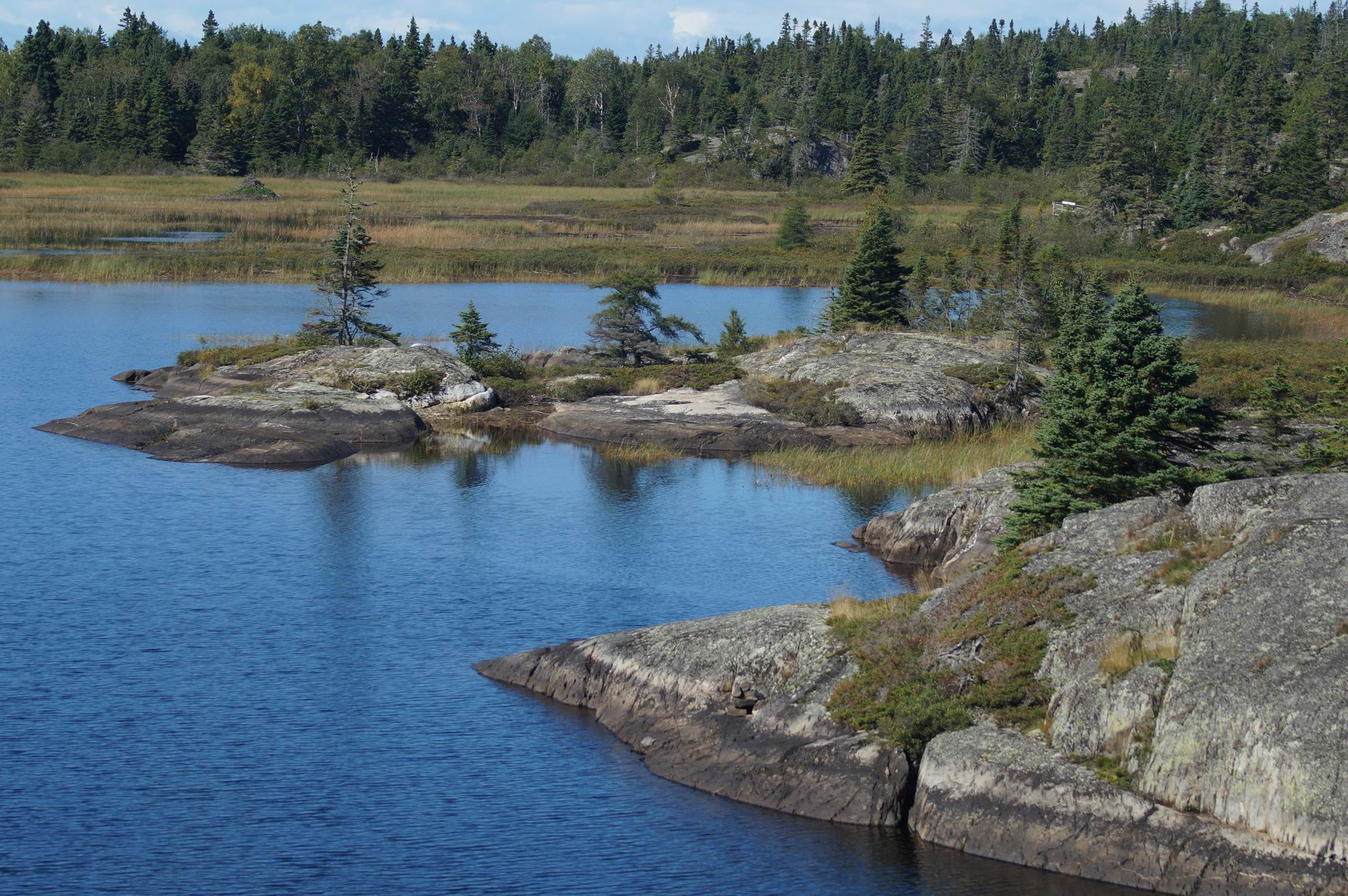
Miriam’s Nature Calendar, August: Bimose Kinoomagewnan, Pukaskwa National Park, September 2016.
In Pukaskwa, the granite of the Canadian shield underlies both the natural environment and the human history. We spent much time walking on the ancient rocks overlooking Lake Superior, and we repeatedly returned to one special place, Bimose Kinoomagewnan: the walk of teachings, created by the Anishnabe people whose ancestral land this is. Photo by Miriam Garfinkle.
Garage Mural on Perly Family Lane, Toronto
July 17, 2021 - #
![I'd l!k3 t0 t3]] y0u S0m37hin6.](/PhotosP/DSC03381bw-GarageMural.jpg)
Nature Calendar July: Northern Gannets
July 1, 2021 - #
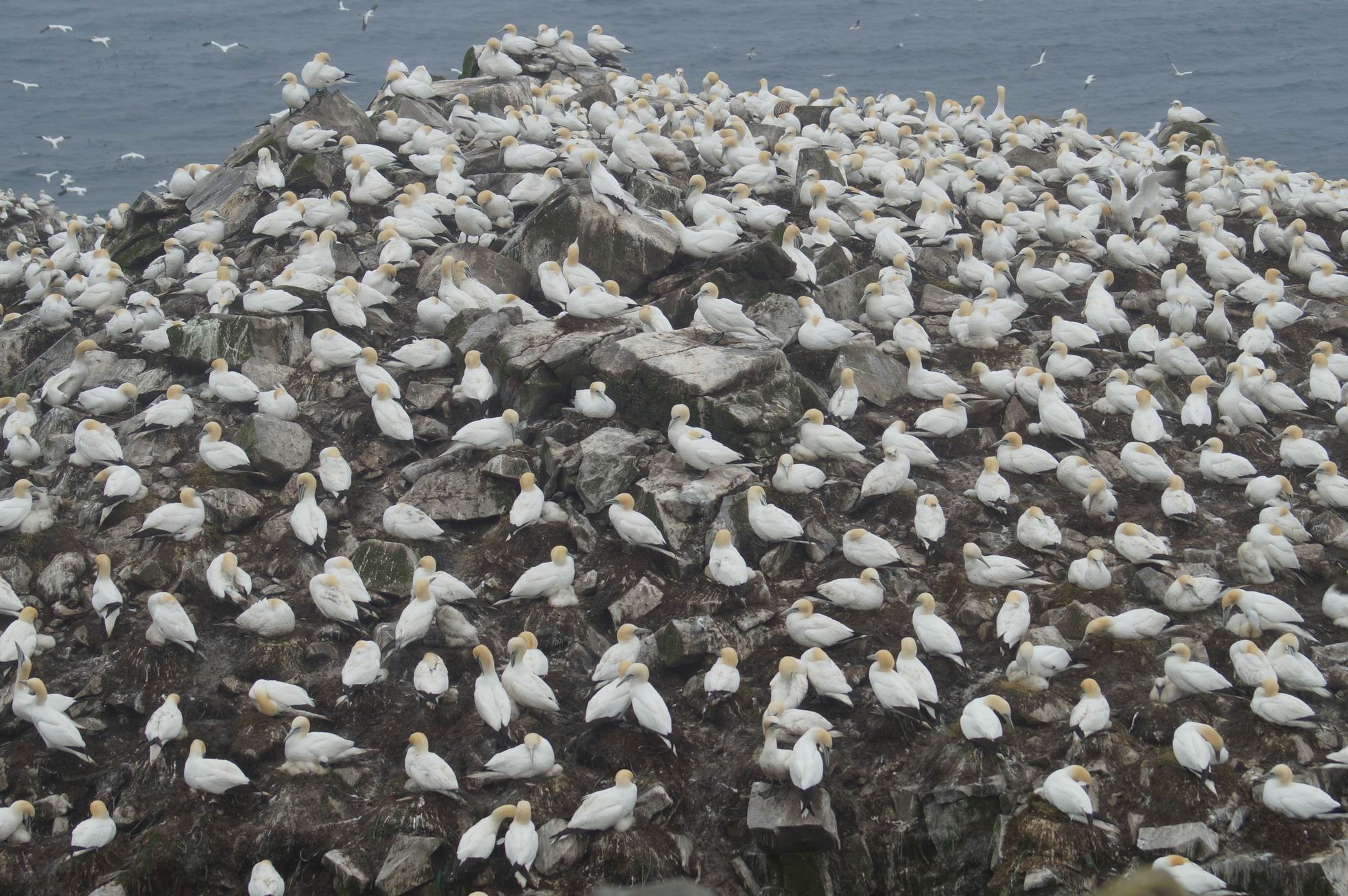
Miriam’s Nature Calendar, July: Northern Gannets, Cape St. Mary’s, Newfoundland, July 2015.
Cape St. Mary’s on the southern end of the Avalon Peninsula in Newfoundland is an extraordinary seabird colony. Living virtually on top of each other are northern gannets, black-legged kittiwakes, common murres, razorbills, gulls, and cormorants. Photo by Miriam Garfinkle.
Nature Calendar June: Cooper’s Hawk
June 1, 2021 - #

Miriam’s Nature Calendar, June: Cooper’s Hawk, Backyard, Summer 2016.
Sometimes you don’t even have to go anywhere to see something exciting. Miriam looked out the back door and saw a Cooper’s hawk in our birdbath. It hung around for a full hour, giving Miriam ample opportunity to get out her camera, as well as to phone me at work to describe what she was seeing.

Situation Normal – June 1, 2021
News from the real world and beyond
June 1, 2021 - #
Upholding journalistic principles # One mark of how seriously the Toronto Star takes its journalistic mission is that it has a Public Editor. Traditionally, a Public Editor is supposed to represent the public interest at a newspaper by keeping a watchful eye on the practice of journalism ethics, identifying and acknowledging significant mistakes, and giving an accounting to readers.
However, under Bruce Campion-Smith and his predecessor Kathy English, the job description of the Public Editor seems to have changed. Now the role of the Public Editor, it seems, is to offer up sanctimonious platitudes assuring readers that the paper upholds the highest ethical standards and journalistic principles. One wonders whether the Star’s Public Editor actually reads the articles in the paper.
Documenting the instances in which the Star fails to uphold journalistic principles on a daily basis would require producing a Phd thesis. A fairly typical example is an article in the April 17, 2021 edition about Cuba: “Unseating Raul.” Like nearly all the Star’s dismal foreign coverage, this is a reprint from a highly biased foreign source, in this case from the Miami Herald, a paper notoriously hostile to Cuba. It’s a standard hatchet job of the kind the U.S. media produce about official enemies. It describes the economic problems that Cuba has been grappling with without ever mentioning the American blockade, American-imposed economic sanctions, and sabotage by the CIA and CIA-funded terrorists.
The Star also keeps assuring readers that it is an indispensable source of local news. How does this square with shutting down community newspapers across the province, and with shutting down local news bureaus, as it did last month in Waterloo and St. Catharines? Oh, but there is still local news. For example, the April 19 Toronto Star has a locally specific feature article on mushroom collecting in a cemetery. Of course, the cemetery is in New York, but if you live in New York, that’s local.
And if you live in the fantasy world of the Star’s editors, the paper is doing a great job on providing local news and upholding journalistic principles.
Excited about Biden # The Star’s editorial writers love Joe Biden. They write (May 1, 2021):
“Joe Biden finally finds his moment”
“His first hundred days restored to their proper place in national affairs the virtues of truth, fact and science, humility, empathy, character and self-control.
...
The president is a fan of the late Irish Nobel Prize winner Seamus Heaney, especially his line from the Cure at Troy about those rare moments - ‘once in a lifetime’ – when ‘a tidal wave of justice can rise up and hope and history rhyme.’
Joe Biden seems to have found his moment.”
Contributor Robin V. Sears concurs. He thinks that Canadian political leaders ought to “study carefully Joe Biden’s new gold standard for post-pandemic leadership.”
We’ll see how these assessments stand the test of time.
Gordie Howe is still Number 1 # I was glad to see sports journalist Dave Feschuk calling out the NHL on its continuing refusal to recognize the existence of the World Hockey Association. The latest instance is the occasion of Patrick Marleau supposedly passing Gordie Howe’s record for the most games played. As Feschuk points out, Marleau is still over 400 games short of Howe’s actual record.
Unlike other sports, such as baseball, soccer, and American football, which count athletes’ major league records regardless of which league they were achieved in, the NHL pretends that the World Hockey Association never existed. Even though many of the top hockey players of the 1970s played in the WHA, their records are written out of history by the NHL. If you look at the NHL’s stats for those players, you’ll see mysterious gaps in their prime playing years for stars like Bobby Hull, Gordie Howe, Mark Howe, Frank Mahovlich, Dave Keon, Norm Ullman, Derek Sanderson, J.C. Trembley, Wayne Gretzky, Rick Vaive, Paul Henderson, Vaclav Nedomansky, Rod Langway, Bernie Parent, and Gerry Cheevers.
The NHL would have you believe that Wayne Gretzky is the top goal scorer of all time. He’s actually number two, with 940 goals, 894 of them in the NHL, and 46 in the WHA. Gordie Howe is number one, with 975 goals, 801 in the NHL and 174 in the WHA. Bobby Hull is third, with 913 goals: 610 in the NHL and 303 in the WHA. But you won’t hear that from the NHL.
Condo heritage # A glossy magazine called Condo Life got dropped off on my doorstep the other day. The cover touts a new condo building called “The Dupont” which, so we are told, combines “urban sophistication” with “heritage charm.” The urban sophistication I could figure out: it’s on a busy street, namely Dupont, and it has lots and lots of glass. Can’t get much more sophisticated than that. But what, I wondered, might the “heritage charm” consist of?
The answer lay within: the new condo will “respectfully complement” the heritage of the surrounding community by incorporating “traditional materials such as brick and stone.” Heritage can’t get much more solid than that.
Karl Marx: born May 5, 1818
May 5, 2021 - #
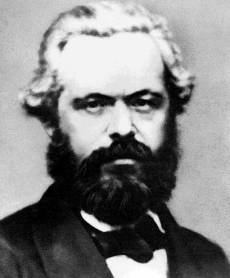
Marx breathes dialectics and revolution. For Marx, radicalism means going to the root, and Marx’s radicalism seeks to go to the root of capitalism, to comprehend its essence dialectically, to understand its inherent contradictions – and the seeds of revolution it contains.
The social reality he sees is not fixed and static, but charged with inner tensions and contradictions, which build up until they burst through the constraints of the present order to assume new forms, again with their own tensions, containing the seeds of yet further transformations. In capitalist society, he writes, “All fixed, fast frozen relations, with their train of ancient and venerable prejudices and opinions, are swept away, all new-formed ones become antiquated before they can ossify. All that is solid melts into air, all that is holy is profaned.”
Marx comes to socialism, unlike his predecessors, not by drawing up blueprints for imaginary utopias, but through his involvement in the real struggle for democracy.
Here is the heart of his politics: there can be no democracy without socialism, and no socialism without democracy.
He starts to study economics, not because of theoretical preconceptions, but because, as a radical journalist, he is trying to better understand the oppression of the poor peasants whose struggles he is striving to bring to public attention.
Marx never constructs a finished system: on the contrary, he struggles to finish anything he writes because there is always more to learn, always further complexities to study and analyze. He hopes to finish the manuscript that becomes “Capital” in a few months; twenty-four years later, it remains only partially completed, and his friend Friedrich Engels has to complete it after his death.
Marx is always deepening his analysis in response to events: from local struggles of weavers and the rural poor in Germany, to the resistance to British imperialism in India, to the struggle against slavery in the United States, to the Paris Commune, to the long campaign to win the eight-hour day.
He continuously adjusts his theories to the facts, not the facts to his theory. Exasperated by pedantic admirers who proclaim a “Marxist” orthodoxy, he growls “If anything is certain, it is that I myself am not a Marxist.”
His investigations bring him to an understanding of the class nature of society: how economic relations, relations of production, shape a society, including its state forms and ideology. He sees, too, that class struggle is inevitable, and that, further, it is the force that can transform societies.
Marx’s analysis shows that the contradictions of capitalism cannot be resolved: capitalism is a system of continuous crisis, capable of destroying the planet on which it feeds in its endless need to extract more profit, more surplus value, and accumulate more capital. Marx is clear about the danger capitalism poses to the earth: he writes angrily about the destruction it wreaks, and reminds us that we are “not the owners of the globe,” that, on the contrary, we have a duty to “hand it down to succeeding generations in an improved condition.”
At the same time, Marx understands clearly that, for all of its contradictions, capitalism will not fall on its own: it needs to be overthrown. He is a revolutionary, not an economic determinist.
Marx believes that there exists a social majority – the working classes, the people who do the work of the society – who are capable of overthrowing capitalism and the capitalist state, and who in doing so can liberate themselves, and all of society. He believes that revolutionaries should engage themselves in the struggles that confront them where they live, but he is clear that finally a revolution that overthrows capitalism, a global system, must be an international revolution.
Marx is clear in his views, but practical in his politics. He throws himself into the work of the First International, which at the beginning is not even explicitly socialist, because he believes it is important to work with others who are engaged in struggle. He never tries to form a political party, and while he usually describes himself as a “communist”, he also at times calls himself a “socialist” or an “anarchist”, without troubling himself much about the terminology.
Running through everything he does is a profound and passionate belief in self-emancipation. He has no time for would-be dictators and saviours who want to bring ‘liberation’ from the outside. Liberation, for Marx, can only be self-liberation: the collective act of individuals working together to emancipate themselves. “Free association” is his watchword, both for the struggle and for the society that we hope to bring into being.
He knows that he won’t live to see that future communist society whose watchword will be “from each according to their ability, to each according to their need” but he devotes his entire life to bringing it about.
Ulli Diemer

Situation Normal – May 1, 2021
News from the real world and beyond
May 1, 2021 - #
Wishful thinking as a climate plan? # Canada’s federal government has announced new targets for cutting greenhouse gas emissions. The new target is to reduce emissions by 40% to 45% below 2005 levels by 2030. That’s an increase from the previous target of 30% set by the Harper government. Even so, the targets are inadequate, and all the more so since they don’t count emissions from shipping, air travel, and the military.
What the new plan also doesn’t include is any plausible strategy for achieving these targets. We’ll continue the present approach of trusting that ‘market mechanisms’ coupled with subsidies for ‘innovative technology’ (and pipelines) will somehow get us there.
That’s the approach that has resulted in a 1 per cent drop in emissions since 2005. One per cent in 15 years. If we continue at the current rate, it will take us roughly 675 years to achieve those targets. The new climate plan isn’t a plan: it’s a fantasy.
Greening the energy sector An article in the business section describes what it calls the “greening of the energy sector.” One strategy for doing this, it seems, is that some companies are selling oil assets to other companies which don’t care so much about pretending to be green. So the company that sells off oil assets can position itself as ‘green’ by showing that it has reduced its activities in the oil and gas sector. Of course, the oil and gas is still being extracted and burned, by someone else.
Some people may be fooled by this, but the planet is not fooled.
Paid sick days # After more than a year of refusing the act, Ontario’s Conservative government is finally proposing a wholly inadequate sick leave plan. The Ford government deserves all the criticism it has been getting, but there is another side to the issue: the refusal of businesses to act on this on their own.
I used to own a small business. We provided paid sick days, not because the law required us to do so, but because it was the right thing to do. We also recognized that having workers come to work sick and possibly make other employees sick was not in our interest.
If a small company like ours could act on its own to provide paid sick days, then corporations many times bigger than ours, could do it too. The fact that they don’t shows that they value profits over their workers’ health.
Vatican approves vaccines ... but some Catholics disagree The Vatican has said it is permissible for Catholics to received vaccines that may incorporate, as many of them do, cell lines from fetuses that were aborted decades ago. The Vatican said “It is morally acceptable to receive Covid-19 vaccines that have used cell lines from aborted fetuses in their research and production process” and that “the use of such vaccines does not constitute formal cooperation with the abortion from which the cells used in production of the vaccines derive.” Both Pope Francis and former Pope Benedikt have received the vaccines.
However, some conservative Catholics are objecting. They maintain that anything that derives in some way from the “evil” of abortion, no matter how remote, must be rejected by Catholics of good conscience. One has to ask: how is it possible for these ‘people of good conscience’ to participate in a church with a history that includes the sexual abuse of children and burning people at the stake?
The myth of Indigenous vaccine hesitancy There have been claims that Indigenous people are reluctant to be vaccinated because of the traumatic legacy of residential schools, and the racism that has historically denied them equal access to health care. Those are the proposed explanations, but it turns out there is nothing to explain, because, as reported in the Toronto Star, Indigenous people get vaccinated at basically the same rate as non-Indigenous people. A Health Canada survey found that 97 per cent of reserve residents, and 94 per cent of Inuit, regard it as important to get their children vaccinated. This is a lower rate of 'vaccine hesitancy' than exists in the non-Native population.
Veldon Coburn, an assistant professor at the University of Ottawa’s Institute of Indigenous Research and Studies, observed that children in Indigenous communities get vaccinated routinely. “We get needles all the time,” he said. “It is not a traumatic experience.”
Coburn suggests that there’s a “cultural zeitgeist” that makes some people think Indigenous people are “very delicate” and need others to care for them. “It’s sort of a self-flagellation from certain segments of the populations,” he said. “They sort of invented an injury that didn’t exist, and they want to be the crutch.”
Protection money in the 21st century # The domain name registrar I deal with (Webnames) offers “Domain Privacy.” If you purchase the “Domain Privacy” option from them, they will hide your personal information (name, email, address, phone number) in the public WHOIS directory. Doing this, they say, will give you protection from unwanted spam and telemarketing, domain phishing, and identity theft.
And if you don’t pay them? Then they will publish your personal information, without your consent, and make you vulnerable to spam, telemarketing, domain phishing, and identify theft. It’s not just Webnames; many of the domain name registrars do the same. Apparently it’s legal under Canada's privacy laws.
A moment on Queen Street #
A man is standing in front of a store he wants to enter. However, a sign on the door says “No Entry without a Mask.” He doesn’t have a mask. What to do?
Another man walks out of the store at that moment. He’s wearing a mask. “Hey,” says the first man, “Can I borrow your mask for a minute?”
No luck. The other man doesn’t want to share.
What I’ve Been Reading
That Precious Strand of Jewishness That Challenges Authority, by Leon Rosselson
Leon Rosselson is best known as a songwriter. We saw him perform at Beit Zatoun in Toronto a few years ago.
In this slim volume, he explores what being Jewish means to him. He writes: “For my parents and grandparents, Jewish identity, in religion, culture, and language, was a given. Not so for me. I’m not religious, nor a Zionist, so in what consists my Jewishness? Is a love of chopped liver and a belief that chicken soup cures all ills enough? And does it matter? This is the story of my search for answers.”
Even though I’m not Jewish, I read Rosselson's musing with a certain sense of recognition because my partner Miriam, strongly Jewish-identified, and at the same time an atheist and an outspoken critic of Zionism and of Israel’s treatment of Palestinians, also had to figure out the questions that Rosselson explores. She did it quite successfully, in my opinion, and so does Leon Rosselson.
A People’s History of the German Revolution 1918-19, by William A. Pelz
In November 1918, a revolution swept aside the old order in Germany. The Kaiser was bundled off into exile in the November revolution, but the struggle for what was to come next was just beginning. The Social Democrats, who had betrayed the working class by supporting the war, nevertheless still had mass support, including, for the time being, the support of elements of the old order who saw in the Social Democrats the best hope for preventing the political revolution from turning into a social revolution. The radical left was just beginning to get itself organized. On the right there were forces ready and willing to shed as much blood as it took to stop socialism.
Members of my family was intimately involved in these events. My paternal grandfather was a member of the Spartacists, the radical left group which was involved in a failed uprising in January 1919. My maternal grandfather, a career soldier demobilized after the defeat in 1918, was a member of the Freikorps Hülsen, one of the most notorious and vicious of the Freikorps, proto-fascist militias which fought to put down the revolution.
A People’s History of the German Revolution depicts the story from the bottom up, from the points of view of ordinary working people. It’s a well-written fascinating story.
A Reading Diary: A Year of Favourite Books, by Alberto Manguel
I picked up this book, which someone had left out on their front lawn, on my way to get my first COVID vaccination.
Manguel writes (in 2004) “I decided to reread a few of my favourite books, and I was struck, once again, by how their many-layered and complex worlds of the past seemed to reflect the dismal chaos of the world I was living in.”
Manguel guides us through twelve books, beginning in June, and ending in May.
The books are The Invention of Morel, by Adolfo Bioy Casares; The Island of Dr. Moreau, by H.G. Wells; Kim, by Rudyard Kipling; Memoirs from Beyond the Grave, by François-Renè de Chateaubriand; The Sign of Four, by Arthur Conan Doyle; Elective Affinities, by Johannn Wolfgang von Goethe; The Wind in the Willows, by Kenneth Grahame; Don Quixote, by Miguel de Cervantes; The Tartar Steppe, by Dino Buzzati; The Pillow-Book, by Sei Shonagon; Surfacing, by Margaret Atword; The Posthumous Memoirs of Brás Cubas, by Joaquim Maria Machado de Assis.
A Very Ordinary Life, by Rolf Knight & Phyllis Knight
When Rolf Knight told his mother Phyllis that he would like to interview her to record and eventually publish the story of her life, she was skeptical. “[T]here wasn’t anything in my life, that happened to me personally, that was extraordinary. At least nothing that millions and tens of millions of other people didn’t experience themselves. I always lived a very ordinary life.”
The story of her life demonstrates vividly that “ordinary” working people are extraordinary in their capacity to rise to life’s challenges, including their readiness to help others even though they themselves are struggling.
A Very Ordinary Life was originally published in 1974. I read it then, but after all this time, it was again fresh and fascinating.
Nature Calendar May: Swallowtail Butterfly
May 1, 2021 - #
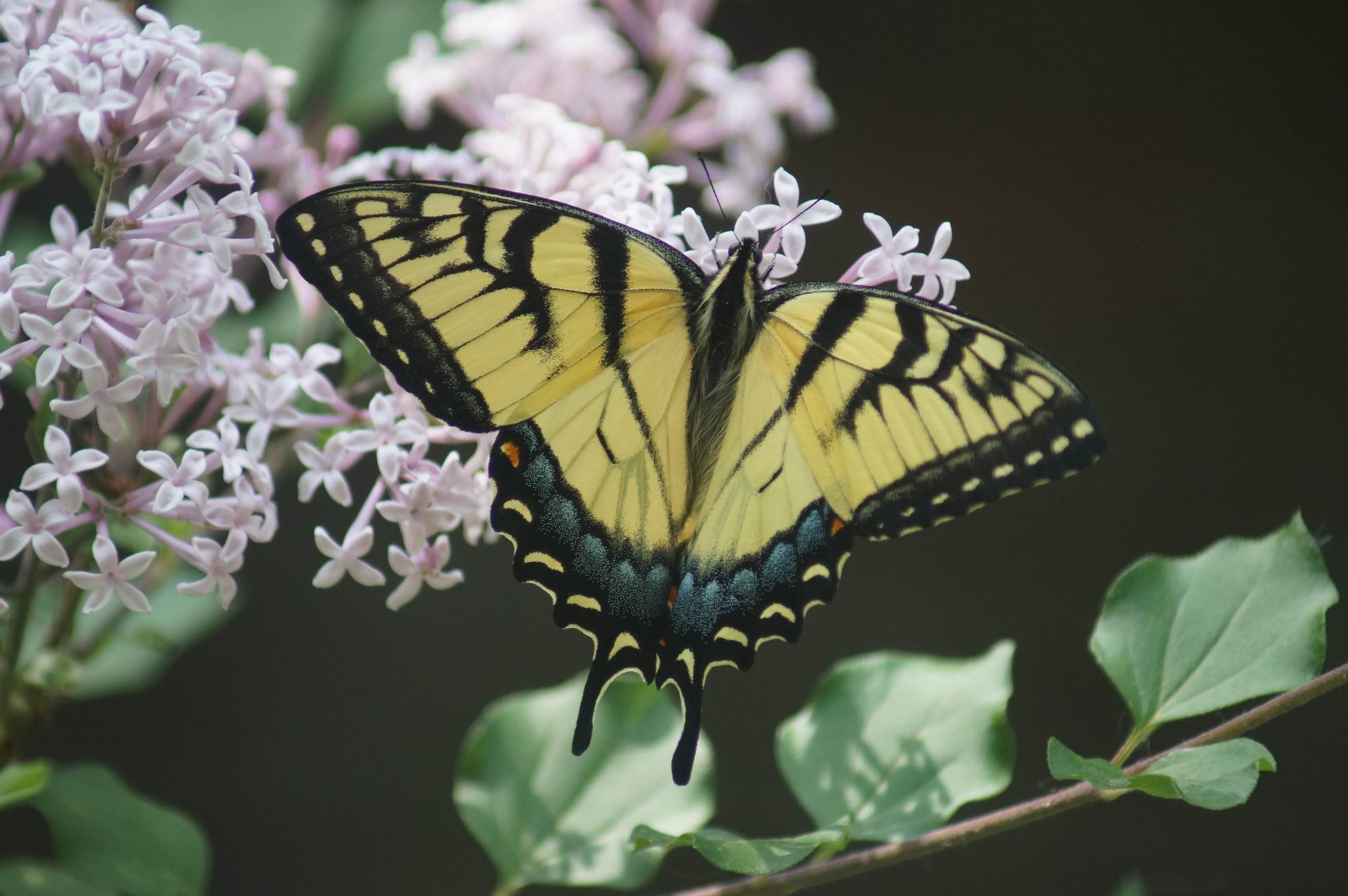
Miriam’s Nature Calendar, May: Tree Swallow, Craigleith Gardens, May 2015.
Miriam rarely had an agenda when she was out in nature. She knew that the best moments, in nature and in life, are those that simply happen. We don’t find them; they find us. So it was on this walk, when we suddenly came upon a group of Swallowtail butterflies feeding on a cluster of flowering shrubs. Photo by Miriam Garfinkle.
Deadlines
April 30, 2021
I miss deadlines.
Connexions – the project I work on, which encompasses both a physical archive and an office, as well as the Connexions.org website – shut down in March 2020 because of the pandemic, and clearly we’re still some way from being able to re-open. I wander over to visit the archive space every week or two, just to make sure everything is still OK and run my fingers lovingly over the materials on the shelves, but of course there is no one else there.
I miss the human contact of working with other people, of course – I really miss it! – but I realize that I also miss the deadlines that working with other people imposes. Working with other people – even in an all-volunteer project like Connexions – imposes deadlines. You agree to do something, you set a completion date, and then you work to meet that deadline because you made a commitment. Now that we have to work remotely, we are working much more independently on longer-term projects with few real deadlines.
And that’s a problem for me, because I’ve always depended on deadlines to motivate me. In high school and university, I mostly wrote my essays the night before they were due. That usually worked out pretty well, so I had no reason to change my ways. After that, I moved into journalism, where the typical pattern is that an editor gives you an assignment in the morning, and you have to hand it in, finished, by the end of the afternoon. That also worked well for me.
White-throated Sparrow
April 29, 2021 - #
I’ve been hearing a white throated sparrow out back for the last couple of days. They have been stopping over in the backyard (in downtown Toronto), for a few days every spring for as long as I can remember, certainly more than a decade. It seems a bit mysterious: can they live that long? Do they migrate with their young and tell them: “Remember this place: it's a good place to stop?”
They seem to be arriving earlier. Last year, they were here on May 3. In 2016, it was May 10. I hope that’s OK; they need to be synchronized with their food sources: insects, seeds, berries.
I’ve also learned that some of them have developed a new variation of their song. It was first heard in B.C. in 1999 (I guess cultural innovation often starts on the west coast), and started to be heard in Ontario five years ago. I’m not good enough to be able to tell if this one is singing the old song or the new variation.
I just know that I’m pleased when I hear them: a brief but precious visit.
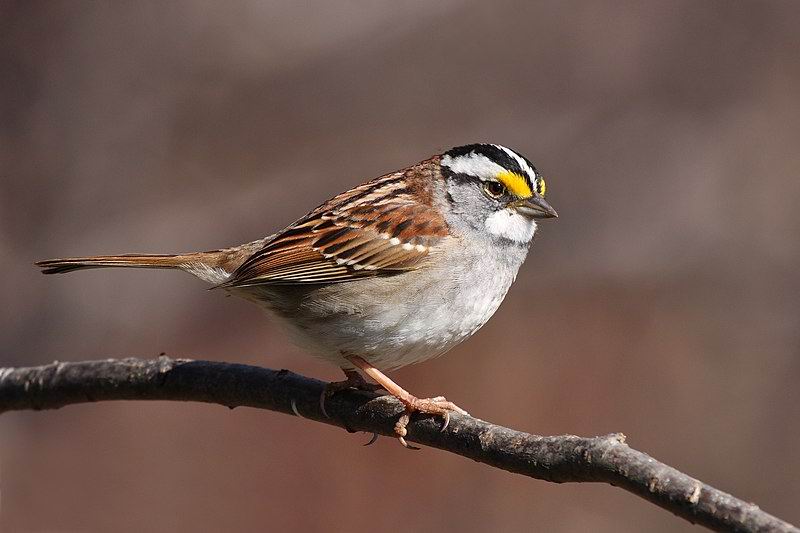
Update May 2, 2022: The white-throated sparrow arrives once again!
The white-throated sparrow that appears in the backyard every spring is back, singing to announce its arrival. Actually, it’s unlikely to be the same individual, since this is a regular spring occurrence going back quite a few years, and I don’t think they live that long. Perhaps the knowledge of this backyard is passed through the generations? As I wrote last year, “Do they migrate with their young and tell them: ‘Remember this place: it’s a good place to stop?’”
The date varies a bit: Last year, it arrived on April 28. In 2020, it was May 3. In 2016, it was May 10. Whenever it arrives, it makes me happy: a lovely mystery and a precious sound of spring.
The intelligence of ravens and the foolishness of (some) humans
April 13, 2021 - #
There is something special about ravens. I am always pleased when I encounter them on my wanderings, partly because they make me feel, as Dorothy might say, “Ulli, we’re not in Toronto anymore!”
I am far from alone in feeling that there is something special about them. Ravens feature in the mythology and folklore of many cultures, from North American indigenous peoples to ancient Greek and Celtic legends. They are seen as creators, as destroyers, as tricksters, as harbingers. They can be all those things, because they are complex, adaptable, and highly intelligent.
Knowing my fondness for birds, several people drew my attention to a recent study of the intelligence of ravens, reported in Scientific American, which concluded that “Young Ravens Rival Adult Chimps in a Big Test of General Intelligence.”
I’ve frequently taken pleasure in hearing about and observing how smart ravens and their Corvid relatives are. But this kind of study bothers me.
The first thing that troubles me is the idea that it’s OK to lock up animals in cages and make them perform tricks to test their intelligence or observe their behaviour. Ravens are wild birds meant to live in the wild. If they choose to interact with humans, as they sometimes do, that’s one thing. Caging them against their will so that a few academics can advance their careers by publishing yet another paper, is another thing entirely.
Another thing that bothers me is that studies of this kind continue to propagate the idea that intelligence is a single quantity, a thing that can be measured and quantified. This idea has a long and ignoble history.
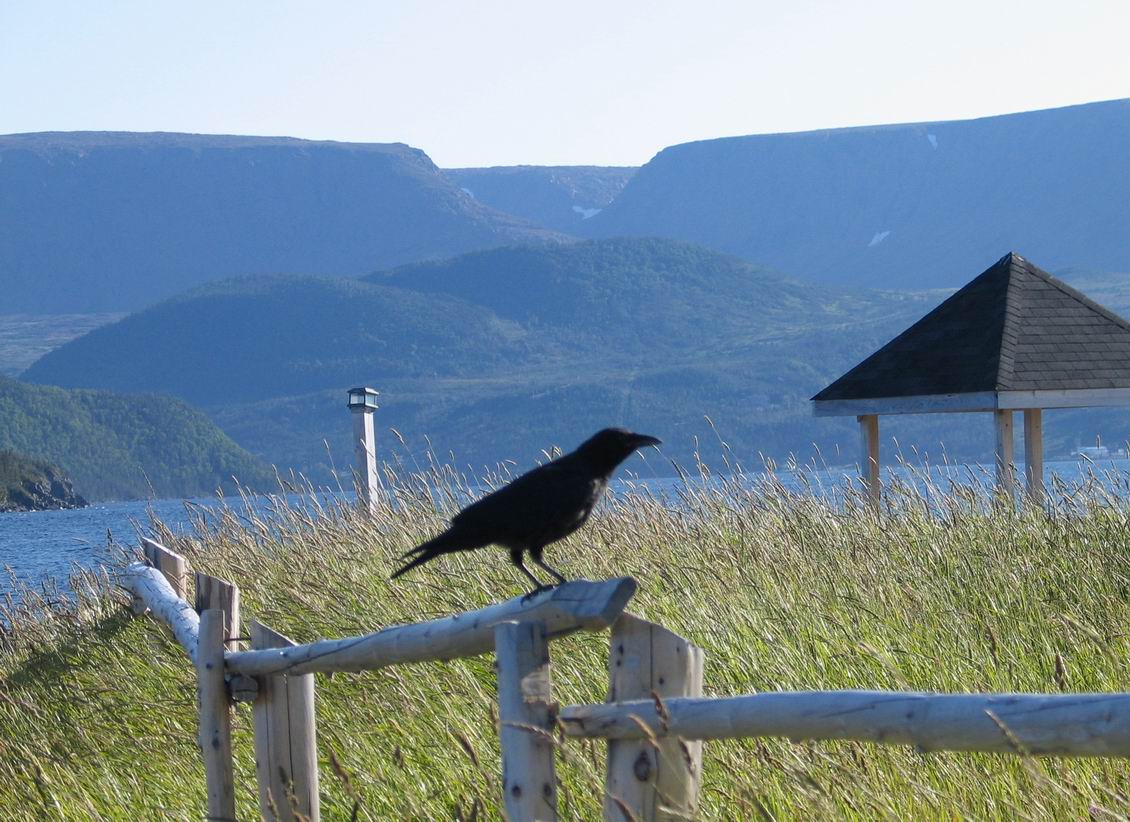
Raven, Noris Point, Newfoundland, 2015. Photo by Ulli Diemer.
Mighty Moe: book review
April 12, 2021 - #
Mighty Moe tells the story of Maureen Wilton, a youthful long-distance runner from Toronto who set a women’s world record in the marathon in 1967, when she was 13. Wilton didn’t pursue an athletic career: a few years later, she stopped running and turned her life in a different direction: work, marriage, children. As the years passed, her accomplishments faded from memory until John Chipman tracked her down for a 2010 CBC radio documentary “Did My Mom Ever Run?” which gave Maureen, now Maureen Mancuso, another moment in the spotlight.
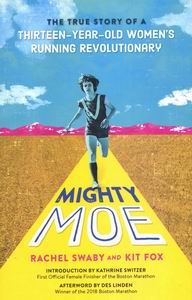
Authors Rachel Swaby and Kit Fox thought Maureen’s story was a story that should be known more widely. They told it first in a 2017 podcast for Runners World, and then in this book, which broadens the story to include the other young women who were Maureen’s teammates on the North York Track Club, as well as their coach, Sy Mah. The book is primarily aimed at readers aged 10 to 16, but readers of all ages will find it an enjoyable read.
Reading this book transported me back to my own days in the track and field world of North York (then a suburb of Toronto).
Read the rest of the review here
How I got vaccinated
April 5, 2021 - #
Having heard horror stories about the difficulties of booking a vaccine appointment online I decided to try the phone number, 1-888-999-6488. I called last Thursday. First off, there was a four-minute recorded announcement about COVID and about what to do if you feel sick (spoiler alert: call Telehealth, or 911 if you are really sick).
Then, within five seconds, a human came on the line, who asked me where I live and how old I am. I aced both questions.
She then offered me an appointment for Monday morning at Toronto Western. She asked me if the location and time were convenient for me. I said yes and yes.
Monday morning, I set off. I had forgotten to bring something to read, which I usually do when I have an appointment, but serendipitously, someone on Palmerston Avenue had left a box of books for people to take. I spotted “A Reading Diary: A Year of Favourite Books” by Alberto Manguel, and took it. It turned out to be a perfect choice.
The wait at the hospital was short. I was led in, asked the usual questions, and got jabbed. Then off to the waiting area to sit for a while in case I had a reaction. My only reactions were to Alberto Manguel’s prose, and those reactions were, as always, positive.
And then home, for coffee and chocolate, which I felt I’d earned.
After I posted this, a reader asked “Why did you rush to take a rush-job vaccine with many unknowns?” I replied:
I have no more concerns about this vaccine (I received Pfizer) that I do about tetanus, hepatitis, and influenza vaccines (not to mention polio, measles, etc.) all of which I have willingly taken. Nothing in life is 100% risk free, but all in all, I think the riskiest thing I did yesterday was crossing several busy streets in downtown Toronto in order to get to the site where I got the vaccine.
Nature Calendar April: Tree Swallow
April 1, 2021 - #
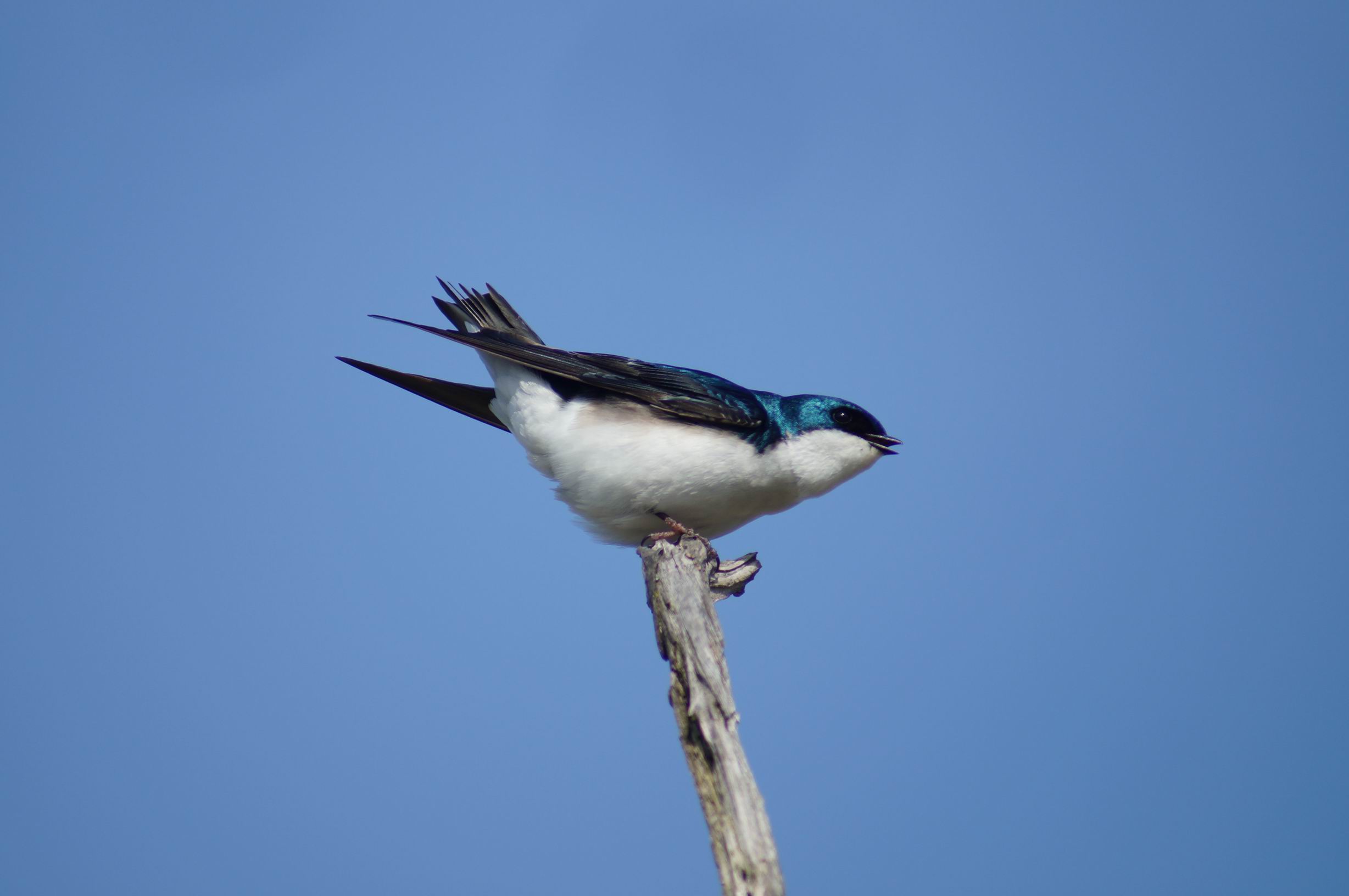
Miriam’s Nature Calendar, April: Tree Swallow, Colonel Sam Smith Park, Spring 2013.
An extraordinary variety of species have made their homes in Colonel Sam Smith Park, a modest-sized park on Toronto’s waterfront. Over the years, Miriam photographed ducks, grebes, snowy owls, mink, butterflies, and much else. Tree swallows nest there in the spring, dazzling us humans with their speed and beauty. Photo by Miriam Garfinkle.

Situation Normal – April 1, 2021
News from the real world and beyond
April 1, 2021 - #
Death by capitalism # ColdType (Coldtype.net) has been handing out Covid awards. There are many deserving recipients. The Bronze Covid award for February goes to the Italian medical supply company, Intersurgical, which threatened to sue a 3-D printer start-up for producing the company’s ventilator valves during last spring’s Covid emergency in northern Italy. Intersurgical, which charges $11,000 for each valve, had been unable to meet the needs of hospitals overrun with desperately sick patients. So Alessandro Ramaioli and Christian Francassi of Isinnova, a 3-D printer company, reverse engineered the part because Intersurgical refused to release the specifications. The valves they supplied cost $1 apiece. Now Intersurgical is threatening to sue the two Isinnova men for patent violation. The virus had killed more than 97,000 Italians as of December. See Coldtype.net
“Silencing” the unsilent # A March 7 opinion article says it’s “Time to stop silencing women in politics.” The author takes offense to Ontario Premier Doug Ford being bluntly critical of the Leader of the Opposition, the NDP’s Andrea Horwath.
As anyone who follows politics must know, politicians are constantly attacking and putting down opposing politicians. Andrea Horwath, for one, does it on a daily basis.
But if a female politician is criticized by a male politician, then, according to this columnist, the male politician is “silencing” the woman politician. This would appear to be an instance of the broader cultural moment which holds that if anyone disagrees with you, let alone criticizes you, then this creates an “unsafe“ environment and “silences” you. Even though, one can’t help observing, those who proclaim that they have been “silenced” are rarely silent: commonly they are articulate middle-class people who are well able to make themselves heard and make themselves the centre of attention.
Certainly Andrea Horwath, a tough and experienced politician, has not been silenced, not in the least. She is up on her feet pretty much every day, usually in front of a microphone, frequently saying harshly critical things about Premier Ford, who, for his part, is also anything but silent. Politics as usual, in other words.
Facebook offers a few pennies to buy good PR and ward off legislation # Facebook is getting a bit worried about the threat of legislation that could might it to pay for the content created by other media companies (e.g. newspapers and magazines) that is published on the Facebook site. On March 23, 2021, Facebook announced that it will be contributing $8 million to a fund for journalism in Canada. To the newspapers facing extinction, and unemployed journalists and new journalism graduates, this might sound like a lot of money.
For Facebook, not so much. Facebook’s annual reported revenue is $105 billion. To put their $8 million contribution in perspective: a Canadian making the approximate median annual income of $65,000 who gives $5 to charity is contributing a greater percentage of their income than is Facebook.
What I’ve Been Reading
Behind Canadian Barbed Wire, by David J. Carter, and Escape from Canada! by John Melady
Two books about the more than 34,000 German prisoners of war who were held in Canada during the Second World War. My father was one of them. The books describe life in the camps, escape attempts, and how former prisoners remembered their experience. While being a prisoner is no one’s idea of a good time, being held in Canada was for many a blessing in disguise, certainly compared to the fate of the millions who died in the war.
And life in Canada was not that bad, all things considered. In fact, when the war ended, some 6,000 German POWs asked to be allowed to stay in Canada. Under the Geneva Convention, this was not allowed: all POWs had to be returned to their country of origin. Many of them subsequently applied to come back to Canada as immigrants, and several thousand were permitted to do so. Again, my father was among them. Some of the POWs were particularly anxious to return to Canada as quickly as possible because, thanks to relaxed discipline at some of the remote camps, they had ended up with Canadian girlfriends and wives, and in at least one instance, a Canadian-born child.
Where is Here? Canada’s Maps and the Stories They Tell, by Alan Morantz
Morantz describes the ways in which the inhabitants of this land have created and used maps. He situates the creation of maps in the context of their purpose. An Inuit hunter, for example, carried a map in his head, but that map had to be constantly adjusted as snow melt, changing ice conditions, and weather changed the terrain. When Inuit travelled to a new location, the men typically took responsibility for selecting a route to move from one place to another in the safest and most efficient way, but once it was time to set up a new camp, the women took over because they knew how the camp had to be set up, and where to find the best places for finding berries and material for making fires.
Morantz quotes Hooley McLaughlin, who points to the distinction between “teleological maps,” those created with an end in mind, such as road maps and image-based maps, and “dialectical maps,” those made as the journey progresses and which reflect the emotional and physical experience of the map-maker.
Revolutionary Activism in the 1950s and 60s, by Ernie Tate. Volume 1: Canada 1955-1965. Volume 2: Britain 1965-1970. Ernie Tate’s two-volume memoir cover his political activism in the Trotskyist movement from his arrival in Canada from Northern Ireland in 1955, up to 1970. Volume 1 covers his years in Canada, as a member and key organizer for the Socialist Educational League. Volume 2 covers his years in Britain, when his work focused on organizing against the war against Vietnam, as well as on developments in the Fourth International.
Private ownership of long-term care homes means overcrowding and more deaths
March 17, 2021 - #
In an op-ed in the Toronto Star on March 16, Walter Wodchis and Bob Bell offer arguments in defence of privately owned long-term care facilities that are peculiar, to say the least.
The fact that the death rate in privately owned nursing homes has been much higher can’t be blamed on the private ownership of those facilities, they tell us. It’s simply due to the unfortunate fact that privately owned homes cram more people into each room, substantially increasing the risk of infection. These privately owned homes are in urgent need of upgrading and replacement, according to Drs. Wodchis and Bell, and, since the owners have failed to modernize them, despite their substantial profits, they urge that the province pick up the tab for doing so, while leaving the people who have mismanaged these facilities in charge.
The bottom line, which they fail to acknowledge, is that private ownership is associated with overcrowding, failure to invest in modernization, and more deaths. This certainly seems like an argument in favour of ending private ownership of long-term care facilities.
Nature Calendar March: Red-winged Blackbird
March 1, 2021 - #
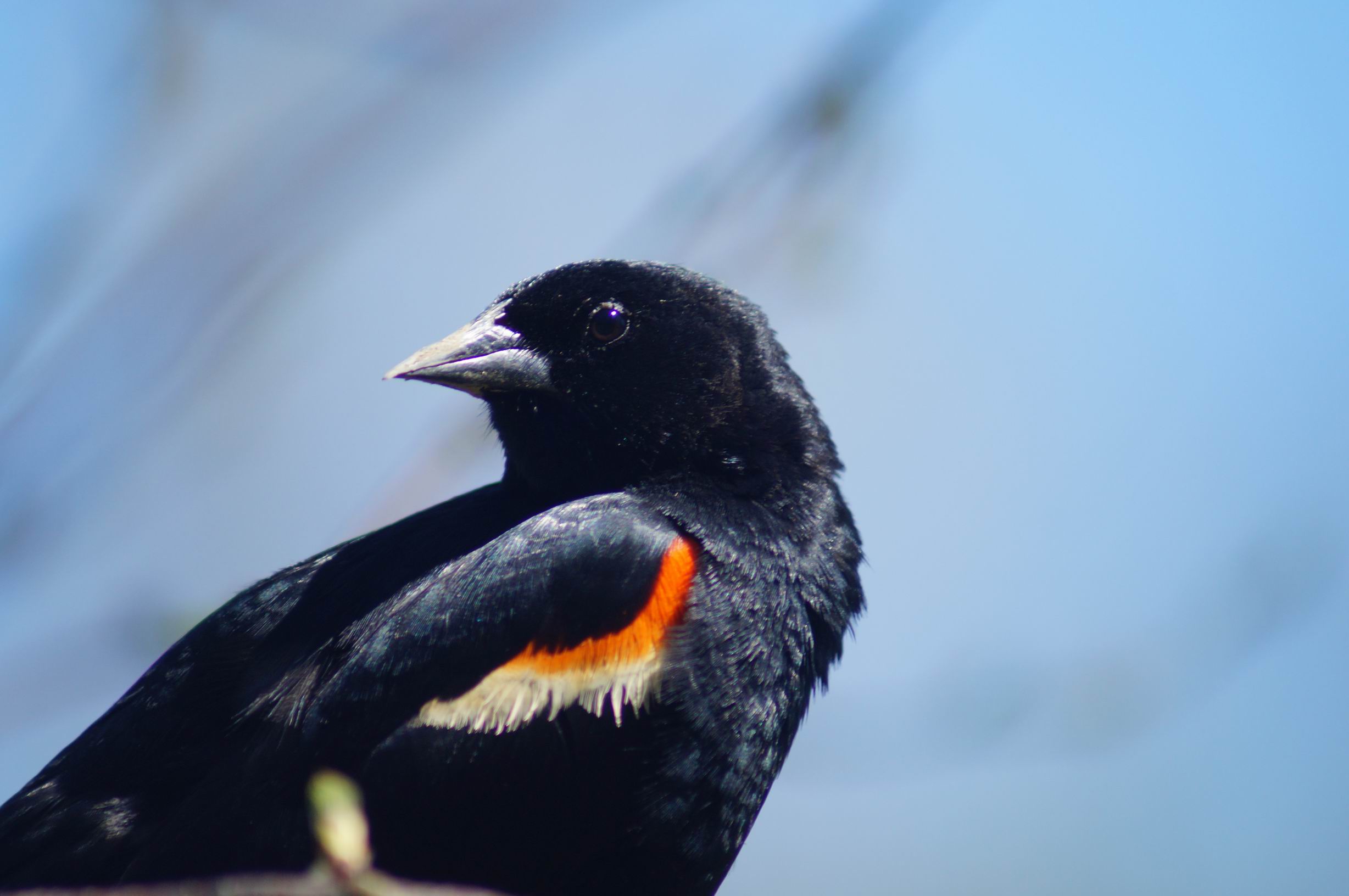
Miriam’s Nature Calendar, March: Red-winged Blackbird, Brickworks, Spring 2013.
Hearing and seeing the first red-winged blackbird of the season is always exciting because it is a sign that spring is going to arrive, even if it hasn't actually arrived yet. The earliest we ever heard a redwing was on February 21 in 2016, in Rattray Marsh. However, it was a warm day in May when Miriam photographed this vigilant male. Photo by Miriam Garfinkle.
Notwithstanding Clause
February 27, 2021 - #
Rick Salutin, writing in the February 26 Toronto Star, commented on what he calls the Canadian tendency to try to have it both ways: “Canada is a master practitioner of this kind of gesture, particularly when it involves human rights. I call as witness our Charter of Rights and Freedoms. Ambiguity and hypocrisy are built into its core, by way of the notwithstanding clause. Canadians are guaranteed these rights – except if some government, somewhere, for any reason or non, decides we don’t have them after all.” He cited as an example Doug Ford’s unilateral interference in the rules of Toronto’s 2018 municipal election, right in the middle of the election, and Ford’s statement that if anyone tried to stop him, he’d invoke the notwithstanding clause.
I sent Rick an email expressing a different point of view. I said:
I think you are mistaken in thinking that the notwithstanding clause signifies hypocrisy at the core of the Charter of Rights and Freedoms. I would argue that, on the contrary, the notwithstanding clause is a vital safeguard.
Even though you say “definitions are overrated,” you seem to assume that “human rights” are objective realities about which there can be no dispute. But “human rights” are hotly disputed, which is why they give rise to legislation, legal challenges, and court rulings.
The Charter of Rights and Freedoms laid the basis for decades of judicial activism, with courts asserting the ‘right’ to make sweeping decisions on matters which previously were seen as the purview of Parliament and the provincial legislatures. Courts now routinely overrule laws passed by Parliament.
But courts are not neutral arbiters of objective fact. They are, as commentators from Karl Marx to Harry Glasbeek have explained, class-based institutions presided over by individuals with clear class biases. They often make rulings which are outrageous.
The notwithstanding clause makes it possible for legislatures to overrule the courts. There are times when this is necessary, and a good thing. There are also times, Doug Ford’s outrageous actions around the 2018 municipal election for example, when it can be abused. But given a choice between allowing courts to make unchallengeable rulings, and allowing legislatures to overrule the courts on rare occasions, I think the power to overrule via the notwithstanding clause is preferable. At least we can vote for who forms the government, albeit through an electoral system where government routinely take office with 40% of the vote. We can’t vote to overrule the courts when they make bad decisions, so the notwithstanding clause is at least a meager protection against judicial tyranny.
To bring this down to the nitty-gritty of current events: the courts have recently been faced with legal actions brought by doctors seeking to overturn the Canada Health Act and provincial medicare systems on the grounds that a universal publicly administered single-payer medicare systems infringes on the human rights of wealthy individuals who assert the right to buy their way to the front of the queue, and on the human rights of doctors who want the freedom to make as much money as they can by giving preferential treatment to the well-off. Should the Supreme Court rule against medicare, which it might, given that its membership consists of well-off members of the ruling class who would be quite able to afford the best private health insurance, then I would hope that the government would invoke the notwithstanding clause. And I, and millions of others, would say, thank God for the notwithstanding clause.
Beyond the Walls: The February 14, 2021 edition of Other Voices
Febrary 14, 2021 - #
The February 14 edition of Other Voices, the Connexions newsletter, which I edit, went out by email today. You can see it online here. The introduction to the issue appears below:
Here we are. It’s the middle of February, and we’re still in the midst lockdowns and alarms, missing our normal lives. We could probably all use some sunshine and some cheering up, and surely Other Voices is up to the challenge of providing that?
Absolutely. Sunshine and warmth? You’ll find four items about Gaza and Palestine in this issue. Gaza? Yes, Gaza. Gaza has sunshine, as well as its share of beauty, humour, and giggling children playing amidst the rubble. As Zainab Wael Bahseer writes in Gaza City, an unusual beauty, by carrying on with eyes and ears open, “we teach life.” Her article appears on We are not Numbers, the featured website in this issue, created for Palestinian youth to tell their stories to the world.
In Postcard from a Liberated Gaza Hadeel Assali joins other writers and activists in imagining a post-pandemic, post-occupation Gaza where people drink coffee by the sea and share stories.
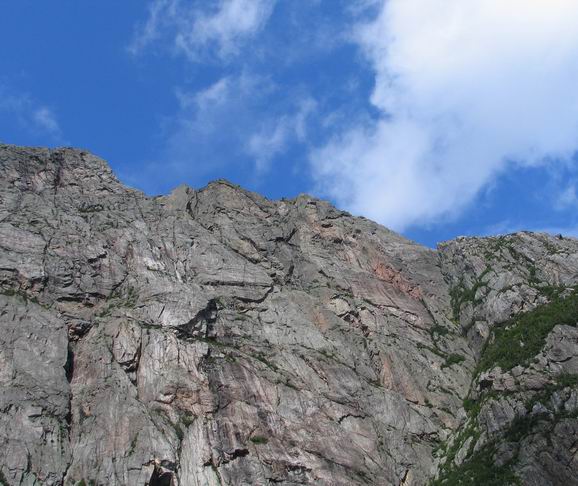
Sameer Qumsiyeh, meanwhile, sets out from Palestine, travels to places (not many) which will accept a Palestinian passport, copes with all the additional restrictions of a pandemic, and makes a film, Walled Citizen. His goal in making the film, Qumsiyeh says, was to create "a picture of how things can be if you can transcend walls and barriers."
From Palestine, we continue on to Kashmir, a territory blessed with apple trees, and oppressed by a military regime which, like its counterpart in occupied Palestine, has been destroying those trees by the thousands as part of a strategy of making it impossible for indigenous people to live. Largely cut off from the outside world, Kashmiris nevertheless also continue to live, and to teach life, in the land they are rooted in.
In India itself, people must try to find a way to keep living in the face of poverty and a pandemic made more difficult by a government that is worse than useless. Online classes, offline class divisions tells the stories of students in the Ambujwadi slum in north Mumbai who are trying to manage online learning using borrowed and shared cell phones while continuing to work to help their families survive. Serving customers who come to your vegetable cart while simultaneously continuing to pay attention to what the teacher is saying is part of a normal day for these young people.
John Pilger takes us behind the walls of Belmarsh prison, where Julian Assange continues to be imprisoned even after a court rejected an American extradition request. Watching the trial, Pilger says, was like watching a Stalinist show trial. Although, Pilger points out, at least in a Stalinist show trial, the prisoners were able to stand and face the court directly. Assange was imprisoned behind a thick wall of glass, and could only communicate with his lawyers by crawling on his knees to a slit in the glass to pass out a note, on yellow sticky notepaper, which would then be passed along the length of the courtroom to where his lawyers were sitting. Pilger reminds us that Assange’s “crime” is to have “performed an epic public service: revealing that which we have a right to know: the lies of our governments and the crimes they commit in our name.”
Leonard Peltier remains locked up in the American prison where he has been held for more than 40 years, convicted of a crime he didn’t commit. The International Leonard Peltier Defense Committee continues to work for his release. A film about his life: Warrior: The Life of Leonard Peltier is the featured film in this issue of Other Voices.
The featured book is Viktor Frankl’s “Yes to Life: In Spite of Everything,” written in 1946 not long after he was released from Auschwitz. “As long as we have breath, as long as we are still conscious,” says Frankel, “we are each responsible for answering life’s questions.”
Life asks us to laugh, love, live, and struggle.
Ulli Diemer
The February 14, 2021 edition of Other Voices is online here.
Nature Calendar February: Point Petre
February 1, 2021 - #
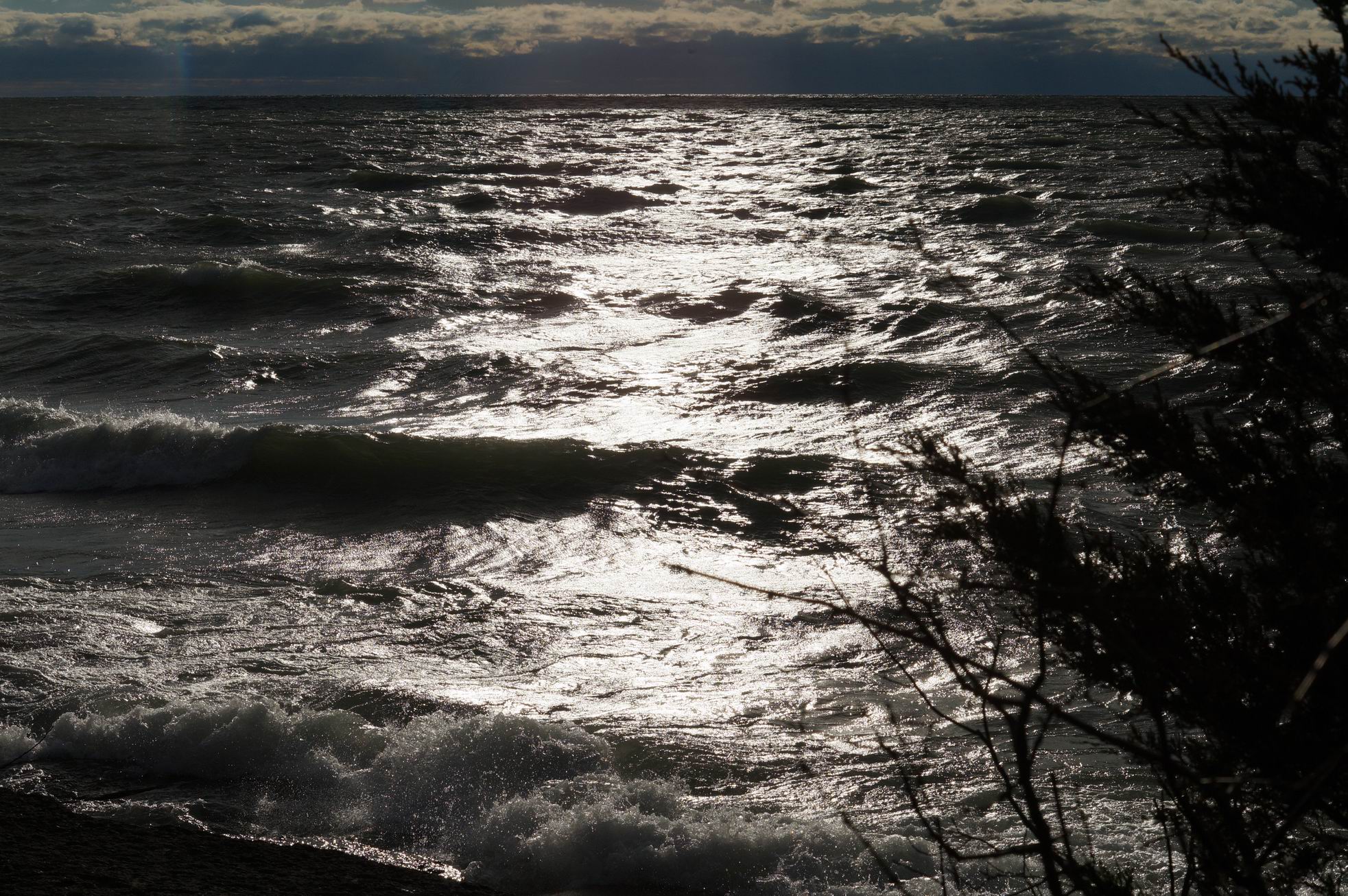
Miriam’s Nature Calendar, February: Point Petre, Prince Edward County.
Each place has its own magic. The lake off Point Petre is usually sunny and inviting in summer. In the winter, the mood is very different. It was a place Miriam appreciated, no matter what side of its changing personality was on display. Photo by Miriam Garfinkle.
Nature Calendar January: Trumpeter Swans
January 1, 2021 - #
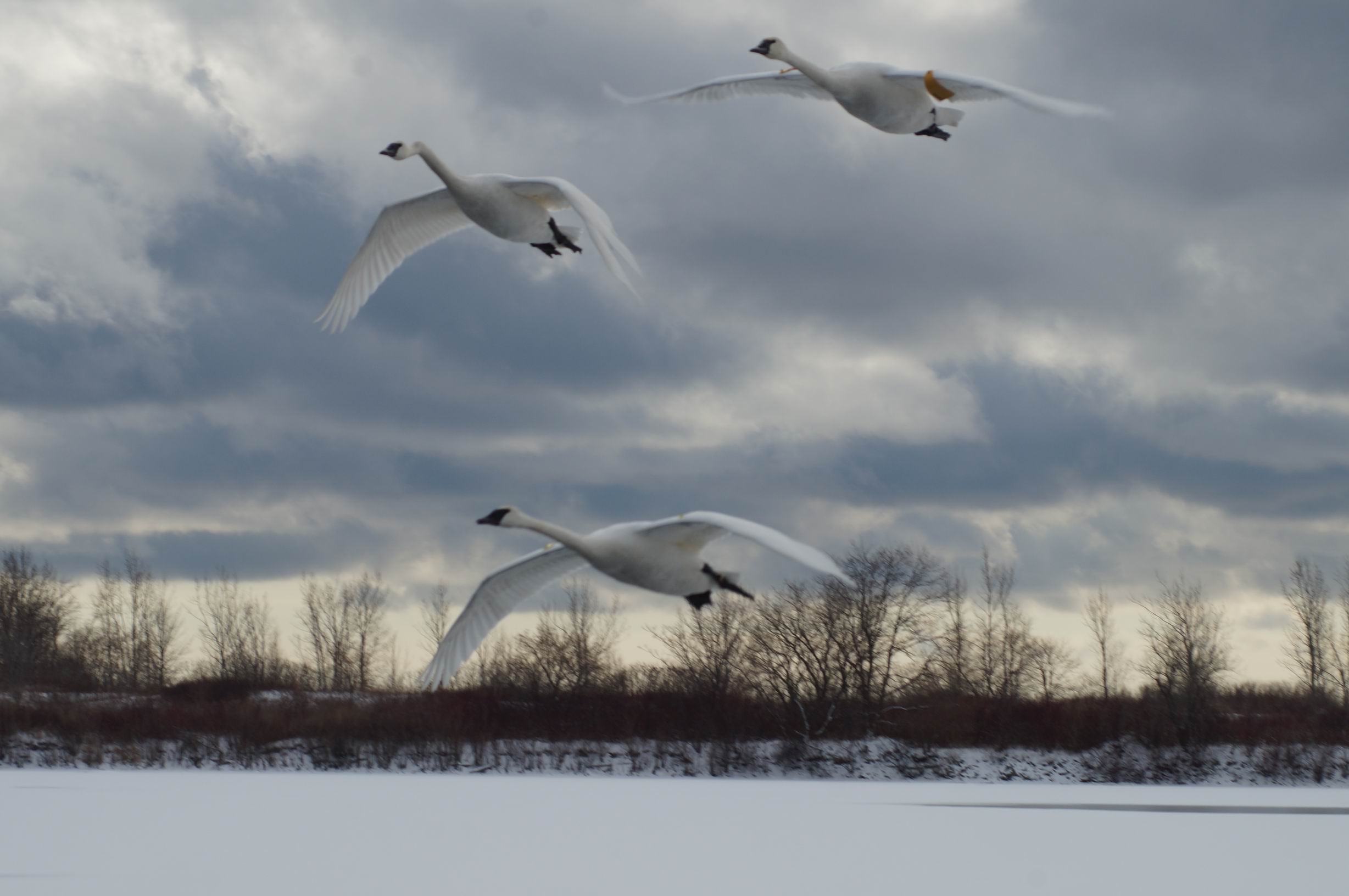
Miriam's Nature Calendar, January: Trumpeter Swans, Leslie Street Spit, Toronto.
Trumpeter swans are impressive, the biggest wild birds in North America. Miriam was always glad when we encountered them because each one we saw was a sign that the effort to bring them back from the edge of extinction is succeeding. Extirpated from most of their range, including Ontario, in the 1800s, Trumpeters are slowly re-establishing themselves. Photo by Miriam Garfinkle.
The people who are preparing for war, and the lies they tell
December 22, 2020 - #
I don’t like Donald Trump. If I was pressed to explain why, I suppose I’d say that part of the reason is that he’s a loathsome racist misogynist lying war criminal. Also, I don’t like people who POST THEIR OPINIONS ALL-CAPS.
I feel I should mention this before explaining why I have a degree of sympathy with Trump supporters who feel that their man is treated unfairly by the mainstream media purveyors of ‘fake news.’ I think they’re quite right. The double standards, hypocrisy, and dishonesty of the media are absolutely breathtaking. That’s true in general, and it’s certainly true in relation to Donald Trump.
A recent example is the alleged hack of Solarwinds, an American software company. Solarwinds’ own report on the alleged hack makes no claim that Russia was responsible, yet within hours the entire mainstream media were pointing the finger at Russia. In a flash, the coverage moved seamlessly from speculating that Russia – not merely Russian hackers, but the Russian state – was behind it, to asserting this as a proven fact, to demanding swift and hard retaliation.
And then President Trump, always the spoiler, chimed in with his own speculation that maybe it was China, not Russia, that was behind it. And anyway, he said, it’s not such a big deal: the U.S. security apparatus is quite capable of handling this kind of thing.
The media were outraged. Shocked! Appalled!
Adding up to Zero
December 6, 2020
As someone who has subscribed to a daily newspaper for all of my adult life, I long ago learned that the real news is to be found in the business section. This is even more true now. The main ‘news’ section (down to a few skimpy pages as newspapers spiral downwards toward bankruptcy) is basically all-COVID, all-the-time, with a few random bits of Trump melodrama thrown in for variety.
It’s from the business section that I just learned that Canada’s biggest meat company is now proclaiming itself both “carbon neutral” and “carbon zero.” I found that difficult to believe, but the newspaper assures me that the company is adding “a jazzy new label to its packaging:” “a seal that declares its products carbon zero,” so it must be true. A corporation wouldn’t put a slogan on its packaging that isn’t true: I take that as an article of faith.
But, sceptic that I am, I still wondered: all those cows and pigs that feed their assembly lines, are they no longer producing the methane gas which we have been told makes a rather significant contribution to greenhouses gases in the atmosphere? And the trucks that haul their products across the country, they’re no longer burning gasoline? And those huge meat processing plants, you know, the ones with all the COVID-19 outbreaks, they’re no longer using fossil fuels?
Nature Calendar 2021
December 2, 2020 - #
Again this year, I created a calendar featuring photos taken by my partner, Miriam Garfinkle, who died on September 15, 2018. Miriam was frequently out in nature, and she’d often have a camera with her. As I did last year, I gathered up some of the photos she took and compiled them in Miriam’s Nature Calendar 2021. I printed about 120 copies for friends and family. The PDF version is available online.

November 11
November 11, 2020
November 11. Remembrance Day. The day the Great War – now called the First World War – finally ended. The date has always been a significant one for me, first of all because it is my birthday, but also because the horrors of the war that ended on that day, and the even greater horrors that followed it, had a huge impact on my family, and therefore on me.
Official remembrances are often about forgetting as much as they are about remembering, and “Remembrance Day” is no exception. Why did the fighting end at 11 am on November 11?
Butterfly
July 9, 2020 - #
Standing on the front walk with my neighbour, I’m trying to find words, but what is there to say? Her daughter died yesterday. In the face of her grief, I have nothing to offer except my presence and feeble words of sympathy.
It wasn’t so long ago that we were standing on this same spot: I was the one who had lost my beloved, also to breast cancer, and my neighbour was trying to find words of comfort.
My neighbour knows, as do I, that life and death, love and grief, walk hand in hand. She is 92 years old, her husband died more than 20 years ago, and still, every Valentine’s Day, she visits his grave.
Lives end, but life goes on. When she goes back inside, I see a Monarch butterfly flitting around the milkweed plants in the front yard. I hope she is looking for a spot to lay her eggs. A woman is walking by with her young daughter. They stop: the mother points to the butterfly and the milkweed and explains what is happening. The daughter is listening and watching intently.
I smile, despite my sadness. Life goes on.

Monarch Butterfly. Photo by Miriam Garfinkle.
Heat Wave
July 9, 2020
It’s hot. It’s really hot. It has been hot for days in Toronto, and the heat isn’t going away.
I am sitting in my air-conditioned home, reading and writing. Ever since COVID arrived, I have been working from home, so when it is this hot, I mostly stay inside during the day, and only head out for walks early in the morning, and later in the evening. I am very aware of how lucky and privileged I am to have the luxury of living the way I do.
I just picked up Jane Jacobs’ 2004 book Dark Age Ahead (a great book which I highly recommend) and re-read the chapter in which she talks about the 1995 heat wave in Chicago. More than one thousand people in excess of the usual number for that period were admitted to hospitals because of heatstroke and other related effects of the heat. Deaths in Chicago during that week were 739 in excess of a typical summer week. There were so many dead that a fleet of refrigerated trucks belonging to a local meat-packer were used to store the bodies, and even that proved not to be enough. Inevitably, those who died were predominantly poor and elderly.
An evening paddle
July 8, 2020 - #
Went canoeing on the Humber River with a friend yesterday evening. We paddled the river and explored the marshes. Saw egrets, great blue heron, grebes, wood ducks, mallards, Canada geese, mute swans, red-winged blackbirds, swallows. Cormorants, gulls, and terns were diving for fish. A highlight was a kingbird nest in a branch above the water, the young with their mouths wide open, the busy parents flying back and forth bringing them insects.
That’s one of the wonderful things about being in a canoe: you can go places you can’t approach in a car or even on foot, moving quietly or staying still in one spot. Life slows down, and you can breathe.

Longing for freedom, and grieving loss: Reflections on watching swifts on a summer evening
June 25, 2020 - #
The chimney swifts lured me outside again this evening. I’d already been out for one walk, but my door was open, and hearing their calls pulled me out in search of them, as it so often does. They’re active in the evenings in my neighbourhood, and going for a walk in the summer pretty much guarantees that you’ll hear them, though seeing them is not always quite as easy.
The tricky thing about seeing swifts is that you hear them, look up to where the sound came from, and they aren’t there. These are birds that can fly 100 km/hour, so if it takes you a half a second to look up, they can already be 100 metres away. They are called swifts for a reason.
Swifts are mysterious birds, enigmatic and paradoxical.
In a sense, they are supremely urban birds, at least during the summer, having adapted themselves to nesting in chimneys a long time ago, though once upon a time they nested in hollow trees. Centuries of logging pretty much eliminated that option, and now they live among us, though as old chimneys get capped or disappear, so do their options for nesting sites. Common swifts and Alpine swifts, species found in Europe, Africa, and the Mediterranean, have been nesting in human-built structures for thousands of years. A swift colony in the Western Wall in Jerusalem has been there for more than 2,000 years: the land has seen enormous changes, but every spring, without fail, the swifts arrive and claim their nests.
Yet unlike other urban birds, swifts have nothing to do with us. They don’t interact with us or hang out in our vicinity in the way that we are used to other birds doing. They don’t perch in trees or on wires, they don’t land on the ground or at a birdbath. They can’t: swifts are so uniquely evolved to a life in the air that they have shed features characteristic of most of the birds we know. Their feet only allow them to cling to vertical surfaces like bricks or trees. That is sufficient for their purposes, because they spend such a small part of their lives down in our terrestrial world.
Some musings about risk
June 21, 2020
The first time my partner and I arrived in Pukaskwa, a wonderful national park on Lake Superior, planning to spend a week or so camping, we were presented with some disconcerting news. “I just want to inform you,” the person in the registration booth said, “that a woman was attacked by a bear in the park yesterday.”
Not exactly news one wants to hear. I looked at Miriam, she looked at me. We didn’t actually discuss what to do, because we knew each other well enough to assume that we’d have the same reaction, and looking at each other’s expression was enough to confirm that. Off we went to pick a campsite and pitch our tent.
We had encountered enough black bears in the woods over the years that even the news of an attack wasn’t enough to shake our conviction, born of our own and other people’s experience, that bears are usually no trouble as long as you remain alert and, when you encounter one, back off slowly, muttering apologies. Even though we felt sorry for the woman who had been attacked, we suspected, perhaps unjustly, that she must have done something to provoke the bear – and we felt sad when we heard subsequently that the bear had been shot. After all, the park was its home, not ours.
The only time I can recall feeling nervous about a black bear was one time when we encountered a mother with three cubs. We backed off quite expeditiously on that occasion.
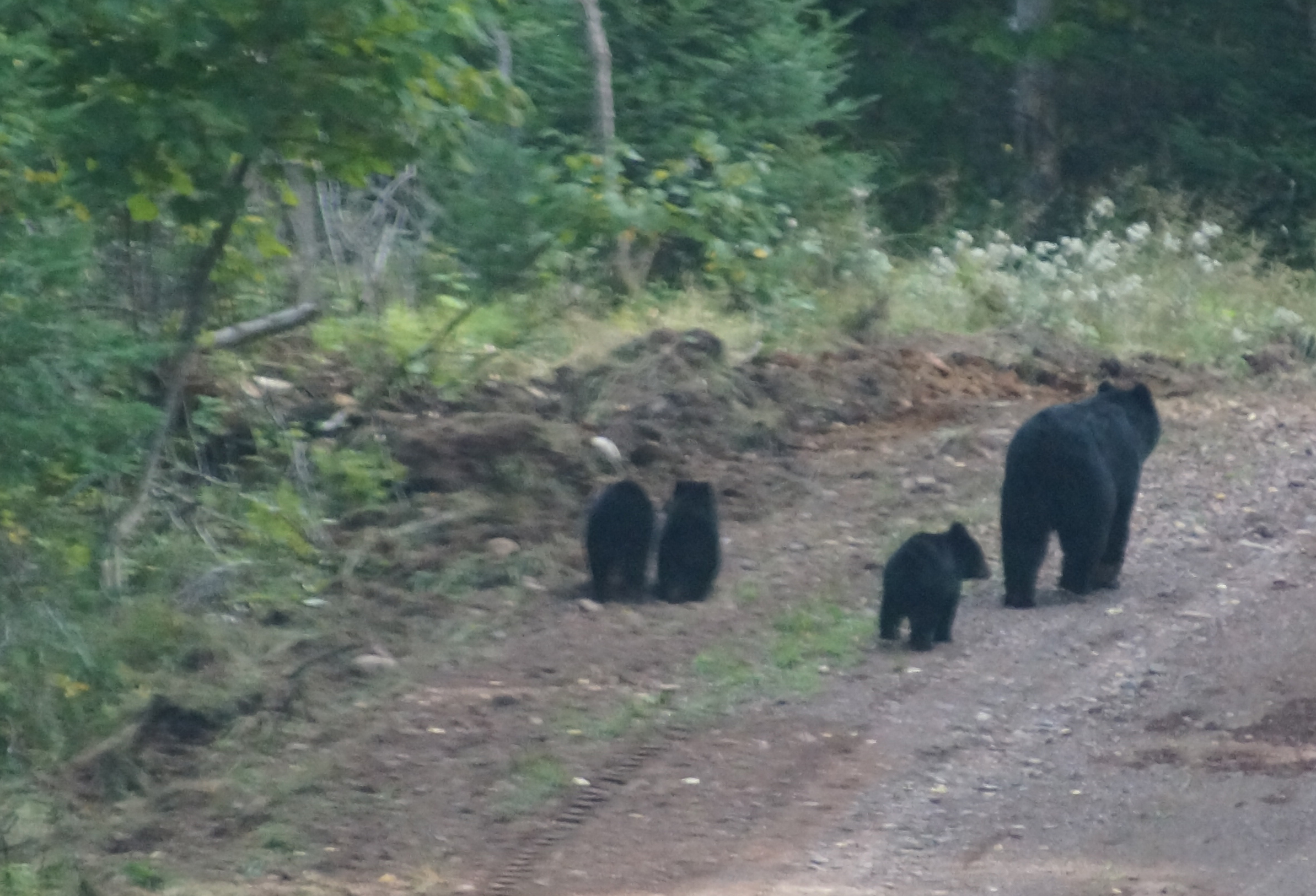
Mother with 3 cubs. Photo by Miriam Garfinkle.
Eratosthenes: Measuring the Earth on the Solstice
June 20, 2020 - #

The Solstice falls at 5:44 EDT on June 20 this year.
It’s a special day, and for nerds like me, it’s also historic because it was on the Solstice in 240 BCE (give or take a couple of years, the record is a bit unclear) that Eratosthenes, a Greek geographer, mathematician, astronomer, poet, and librarian, first calculated the circumference of the earth.
Eratosthenes lived in Alexandria, where he served as the librarian of the great library of Alexandria. He learned from travelling merchants that in the town of Syene, far to the south of Alexandria, on midday on the day of the solstice, the sun shone directly down a deep well, reflecting off the water below, something that happened on no other day of the year.
Eratosthenes knew that the sun would have to be directly overhead for this to happen, and he also knew that this never happened in Alexandria. Using the shadow of a vertical stick, he measured the sun’s angle in Alexandria on day of the Solstice, and found that it was about 7.2 degrees away from being vertical, about one-fiftieth of a circle (360 degrees). He reasoned that if he could measure the distance from Alexandria to Syene, he would then be able to calculate the earth’s circumference.
Traders told him that it took 50 days for their camels to travel from Alexandria to Syene. Eratosthenes knew that travellers riding camels could cover about one hundred stadia (about 11-and-a-half miles) in one day, so he calculated that the distance from Alexandria to Syene was about 5,000 stadia, or about 570 miles. He multiplied this figure by 50, and arrived at an estimate of about 28,500 miles for the earth’s circumference. That’s about 15% off the current measurement of about 24,900 miles; not bad for 240 BCE.
Strange Sounds Up in the Trees
June 6, 2020 - #
I’m sitting out back reading (Uncle Tungsten, by Oliver Sacks) but I find I’m being distracted by the sounds coming from up in the trees above my head. Usually I have some idea of what I’m hearing from up above – swifts, robins, cardinals, sparrows, squirrels, cicadas later in the summer – but these sounds I can’t place. They’re just weird: a combination of whistles, clacking sounds, chuckling, rattling, in no particular sequence that I can make out, and certainly not musical.
Finally I grab my binoculars and have a look. Two birds, darkish. It’s not so easy to recognize a bird when it’s 30 feet up and you’re directly below it. Not for me, anyway. Hmmn, yellow bills. Aha: starlings. Since they have yellow bills, I presume they are adults, since the young have dark bills. They’re sitting on separate branches, but occasionally one hops onto the branch the other is on. Some kind of mating behaviour? That seems possible, but they don’t seem to be actually doing anything.
I look them up. My Peterson guide says they are “garrulous.” That they are. Another bird book tells me that starlings are “monogamous,” their version of monogamy being that they stick with one partner until they pick a new one. Yeah, OK.
So maybe they’re discussing the pros and cons of raising another brood? Or maybe they just enjoy sitting around making weird noises? I don’t know.
This seems to be the story of my life: I see things, but I don’t really know what’s happening, or why. It wasn’t always like this: when I was 20, I knew everything. Since then, life has been a constant journey of discovery: that is, discovering how much there is to know, and how little I know.
The mosquitoes drive me inside. Back to Oliver Sacks.
M is for Miriam
June 5, 2020 - #
I’ve written a children’s book about my partner Miriam Garfinkle, who died in September 2018.
It’s an alphabet book, illustrated by Emma Lightstone, with each page devoted to some aspect of Miriam’s life: C is for Community, D is for Doctor, G is for Garden, L is for Laughter, N is for Nature, P is for Piano, Q is for Questions, S is for Solidarity, W is for Waffles....
It’s intended for kids aged roughly three to nine, but adults who knew Miriam seem to like it too. For more information including how to get a copy, see the Contact page.

Thinking Clearly in a Time of Crisis
May 12, 2020 - #
A crisis like this pandemic is not a time to stop thinking. It is a time when critical thinking and public discussion are more important than ever.
A small number of officials and politicians are taking decisions with enormous and far-reaching implications for the lives of many people, not just for the duration of this pandemic, but far into the future. The time to have serious discussions about what they are doing, and the direction we are heading in, is now, not some day in the future when it will be difficult, or too late, to change course.
To be clear: I believe that public health officials, the people who are taking a leading role in shaping our response to COVID-19, are doing their best to deal with a very real crisis. I respect their dedication, and I know that it is very difficult to respond to a rapidly changing situation with imperfect information and limited resources. And I certainly have no stomach for the rapidly spreading pandemic of conspiracy theories, let alone the disgusting racist attacks on Canada’s Chief Public Health Officer.
Nevertheless, we need to be asking questions....
Read the full article here.
We Don’t Repeat
April 23, 2020 - #
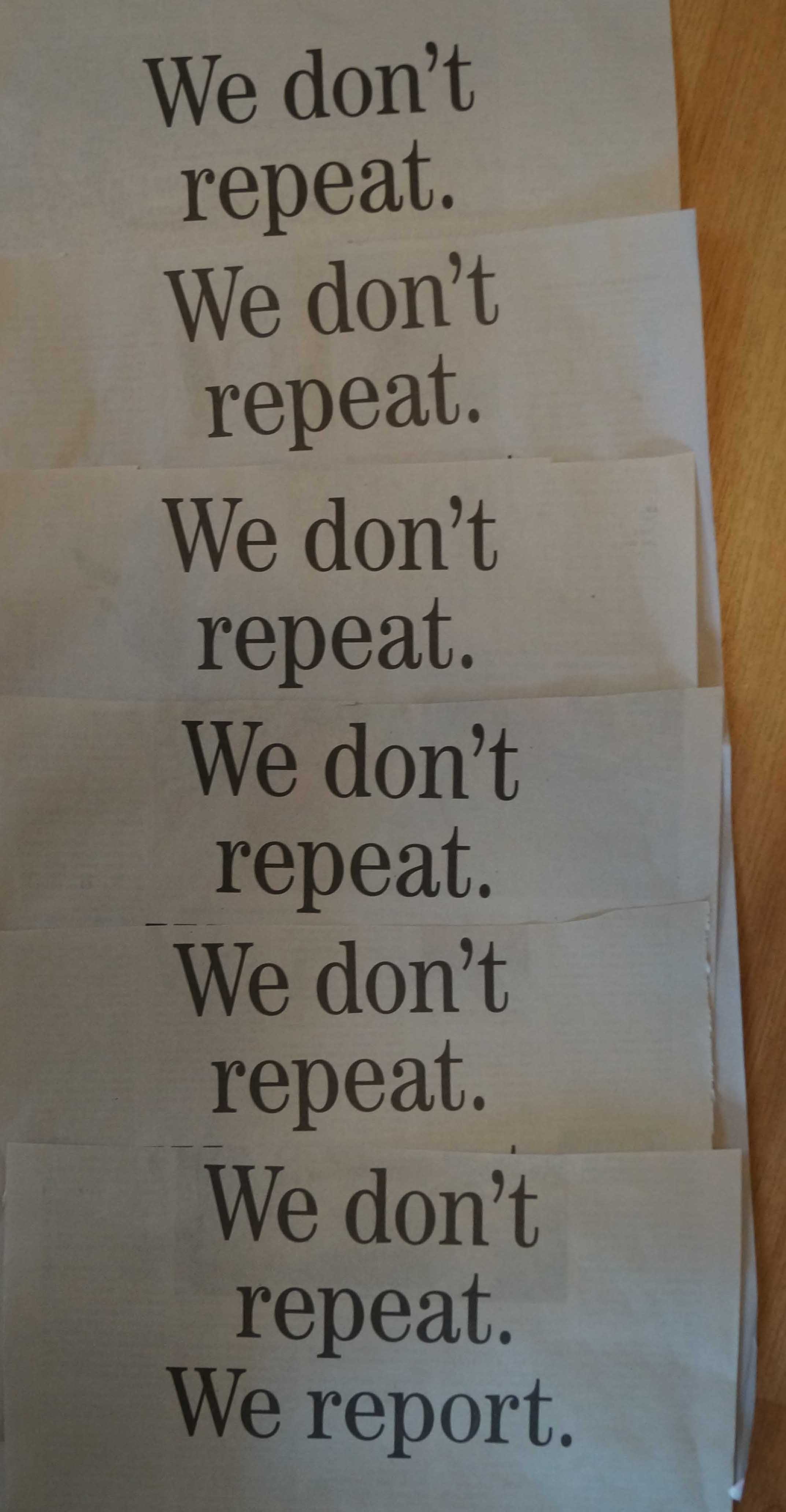
In an uncertain, disquieting world, it is reassuring to have moments that are predictable. For me, one such moment comes every morning when the Toronto Star lands on my doorstep. When I pick it up and take it inside, I am comforted by the knowledge that even though almost the entire paper will be full of COVID-19 coverage, every day the Star will manage to find one page to run a self-laudatory full-page ad telling me that
“We don’t repeat... We don’t repeat... We don’t repeat... We don’t repeat... We don’t repeat... We don’t repeat... We don’t repeat...”
Don’t Use Bleach
April 16, 2020 - #
Among the many myths about the COVID-19 coronavirus is the theory that you can use bleach on yourself to kill it. DO NOT do this!

Morality in an Amoral World
March 19, 2020 - #
A crisis is a mirror.
It shows us – if we have the courage to see – who we are as individuals and as a society. The self-congratulatory poses of governments, politicians, and state institutions are confronted with the harsh test of reality. Each of us – as individuals, friends, families, neighbours, communities – face new and sometimes difficult challenges.
The novel coronavirus COVID-19 is such a crisis. Governments? Some are well-prepared, with solid public health systems and free health care for all. Meanwhile, in the US, in mid-February, two weeks after the World Health Organization declared the novel coronavirus outbreak a public health emergency of international concern, the Trump administration pushed ahead with major funding cuts to U.S. public health programs, including a $25 million cut to Office of Public Health Preparedness and Response, and $85 million in cuts to the Emerging and Zoonotic Infectious Diseases program. In Ontario, when COVID-19 struck, public health authorities were facing the looming 27% cut to public health spending announced by the Ford government in its budget. (Belatedly, Ontario has just declared a state of emergency and put those cuts on hold – for now.)
In the confusing rush of events that mark a crisis, it is easy to be so focused on what is happening that we forget to ask why. Yet it is when we ask why that we confront the ethical and moral questions that illuminate who we are and what kind of society we live in.
Why, for example, are pharmaceutical companies competing to produce a vaccine for COVID-19? Why, instead of keeping their work secret, aren’t scientists around the world collaborating, sharing their research, and making the results freely available? Why isn’t this question even being asked in public discourse? It seems that we are supposed to take it for granted that, above everything else, the goal of scientific work should be to make a profit. U.S. government officials have already stated that an eventual COVID-19 vaccine may not be available to everyone in the U.S., let alone in poorer countries, because it may be ‘too expensive.’
We’ve moved backwards.
The worst epidemics in Canada and the U.S. in the last 100 years were the recurrent polio epidemics. In Canada, an estimated 11,000 people were left paralyzed by polio just between 1949 and 1954. In 1954 alone, there were 9,000 cases including nearly 500 deaths. In the U.S., in 1952, there were 58,000 cases of polio, resulting in 3,135 deaths and 21,269 cases of paralysis. The polio nightmare started coming to an end when Jonas Salk developed the first successful polio vaccine in 1955. The patent? None. Salk refused to patent his discovery: he wanted it to be freely available to everyone.
Salk himself was following in the footsteps of Fredrick Banting, Charles Best, and James Colip, the discovers of insulin. They did patent their discovery – and then sold the patent to the University of Toronto, for $1. They said they didn’t want to profit from a discovery for the common good.
Salk’s and Banting’s attitude would be unthinkable now. What capitalism has succeeded in doing, it seems, is to make it acceptable for corporations to engage in behaviour, on a large scale, which most of us, as individuals, would refrain from as a matter of common decency.
And indeed, as individuals, as friends, as a community, people continue to support and help each other in times of trouble. Informal networks of mutual support spring up, as they nearly always do in a crisis. Beyond the headlines about COVID-19 emergency measures, closures, and social distancing, there are countless stories about people reaching out and helping those who need help.
Yet capitalism tells us, endlessly, that selfishness is good and inevitable. In the place of morality, it proclaims an amoral vision in which nothing matters except making as much money as possible. Greed is good. Exploiting others, destroying the planet, condemning people to a life of poverty and suffering, it’s all good, as long as money can be made. Capitalism allows no moral qualms.
While there are some – too many, it’s true – who have internalized this attitude, most of us do not act this way in our own lives. Society could not exist if we did, because we need each other. As social beings, we survive and thrive to the extent that we can form and count on relationships that are built on mutual support, co-operation, and trust.
The moral principle that has come to be known as the Golden Rule embodies this truth. Versions of what we call the Golden Rule emerged in many different religions, as the Golden Rule poster below illustrates. The fact that it is part of so many different traditions tells us that it pre-dates those traditions: it is embedded in human nature itself.
If we, or at least most of us, did not recognize the fact that each of us is worthy of respect and deserving of having our needs met, we could not survive as a social species. At the same time, if treating others as we ourselves would wish to be treated were always perfectly natural and automatic, then we wouldn’t need a Golden Rule. We don’t have a rule that tells us to breathe. We just do it.
One of the things that the existence of the Golden Rule tells us, then, is that we humans are imperfect and full of contradictions. Even when we know what we should do, we sometimes fall short, and need to be reminded or held to account. That, no doubt, is why discussions of the Golden Rule so frequently stress compassion, forgiveness, and second chances. It recognizes that there are times when we need to forgive, and times when we need to be forgiven.
At the same time, no rule, no matter how profound, is a substitute for thinking critically about real-life situations. For example, few of us would advise a woman in an abusive relationship to return to her violent partner and give him a second – third – fourth – fifth chance. There are times when anger is a healthier response than turning the other cheek.
There are occasions, in fact, when, confronted with the life’s complexities, we might also want to keep in mind George Bernard Shaw’s contrarian dictum: “The golden rule is that there are no golden rules.”
Nor does the Golden Rule, by itself, guide us in dealing with those who have power over us, especially when that power is wielded to oppress. To deal with them, we need to draw on another part of our human nature: our impulse to come together and support each other to fight for justice. As Cornell West has said, “Justice is what love looks like in public.”
The coronavirus outbreak is a crisis that challenges us to look beyond our own immediate concerns and ask ourselves what kind of world we want to live in. We don’t have much time: climate change will make this virus seem like a picnic.
But we do have some time right now, because many of us have had our lives put on hold. Let’s try to use that time as constructively as we can.
There are things we can do to help, like donating money, even while we are self-isolating. There are people who are facing this virus – and other concurrent public health disasters, like malaria, which kills 3,000 children every day – under infinitely worse conditions than we are. Think of Yemen, Gaza, Congo. Venezuela and Iran are trying to cope with their outbreaks even while the United States is tightening sanctions on medical and humanitarian supplies.
They need our active solidarity.
One step you can take today is to donate to Tarek Loubani’s GLIA Project, which is printing 3D masks and stethoscopes for Palestine and other under-served communities whose capacities for dealing with a health crisis are much worse than ours. You can donate to them here here.
Please help. And stay well!
Ulli Diemer
This article is also available in Bulgarian and Vietnamese.
Keywords: Corporate Ethics – Crises – Ethics – Golden Rule – Human Nature – Kindness – Morality – Pandemics – Public Health – Public Safety
Related Reading:
Abandoning The Public Interest
Contamination: The Poisonous Legacy
of Ontario’s Environmental Cutbacks
Public Safety: Other Voices, June 26, 2017

Taking a Stand Other Voices – February 18, 2020
February 20, 2020 - #
Psychologists call it cognitive dissonance. George Orwell called it double-think. Some of us might call it organized hypocrisy.
Call it what you will, it surrounds us. The government proclaims its commitment to ‘reconciliation’ with indigenous people, and says that its relationship with them is its most important relationship. At the same time the RCMP, following an order by a colonial court, invades unceded indigenous land and arrests people for occupying their own land. Governments mouth platitudes about the importance they place on dealing with the climate emergency while at the same time they build new pipelines and approve massive new tarsands projects. The biggest polluter on the planet – the U.S. military – meanwhile receives constant increases in its budget, even while it pursues demented schemes to take us to the edge of war, mostly recently by deploying a new generation of “low-yield” thermonuclear weapons on submarines. The theory, presumably, is that if the U.S. drops a few “low-yield” nuclear bombs on Russia or China, the Russian and Chinese won’t mind too much, and won’t retaliate.
All this is business as usual. Fortunately many people across the country, and around the world, are saying no to business as usual. They are taking a stand and disrupting business as usual.
In this issue of Other Voices, we spotlight the actions of people who are taking a stand and, in many different ways, are insisting on change.
See the February 18 issue of Other Voices here.
Keywords: Indigenous Struggles – Militarism – Nuclear Weapons – Oil & Gas/Environmental Issues – Police Raids – Anti-Psychiatry – Direct action – Non-violence – Rural Women
Toronto’s newest street sign
January 4, 2020 - #
Toronto’s newest street sign went up yesterday on Miriam Garfinkle Lane. I don’t think I ever had a favourite street sign before, but this one is now definitely my favourite.

A theological moment
January 3, 2020 - #
I’m walking to work along Bloor Street this morning. Two guys are smoking in a doorway. One of them stops me: “Excuse me. My friend and I, we are having a discussion. Do you know, what is purgatory?”
I reply: “Yes, it’s where you go when you aren’t good enough to go straight to heaven, but not bad enough to go to hell. It is an in-between place, sort of like jail, where you stay for a period of time, and then when you have served your time, you go to heaven.”
Guy: “So you do go to heaven after?” He looks meaningfully at his friend.
“Yes,” I reply. “If you believe in that kind of thing.”
They seem happy with my answer. I go on my way.
Faith, Hope and Persistence Other Voices – December 15, 2019
December 15, 2019
When we look at what is happening in our world, it can be difficult to believe that there are grounds for hope, let alone faith. And yet we – we humans – continue to live and act in ways that testify to our hopes, and to our faith in the possibility of a better future. We plant gardens and trees, we have children, and we resist injustice and act to protect the planet we share.
Hope is something quite different from optimism. Optimism – and pessimism – assess the likelihood of something happening. But being optimistic or pessimistic is irrelevant to standing up for justice and defending the earth. For most of us at least, our moral principles aren’t based on a calculation of the odds. And in fact most acts of resistance, and most movements for justice, arise in the face of what are often overwhelming odds. They are the powerless challenging those with entrenched power. It is only by acting that people who feel powerless come to feel that they do have power. And when we act, that which seemed impossible to achieve starts to become possible, because enough people believe it is possible and are working together to make it so.
Hope is about possibility, not certainty. Even when we know that we are rowing against the tide, as we often are, we know that the future is not preordained. We know the future is shaped by human actions, and so we act. And we hope that our actions will help to steer the future in the direction we want to go in.
When we act collectively, we are also expressing our faith in other people, and in ourselves. Not blind faith – we know our own contradictions and faults, and we know all too well the immorality and cruelty that humans, or at least some humans, are capable of. But we also know, from our own life experience, that part of the common heritage of humanity are impulses to create community, to share, to love one another, to treat others as we ourselves would wish to be treated. And the fact that these capacities exist is a basis for faith in people, including ourselves, and in our ability to change and to rise to our potential to be who we are capable of being. By working to change the world, we change ourselves.
Miriam’s Nature Calendar 2020
November 26, 2019 - #
Again this year, I created a calendar featuring photos taken by my partner, Miriam Garfinkle, who died on September 15, 2018. Miriam was frequently out in nature, and she’d often have a camera with her. As I did last year, I gathered up some of the photos she took and compiled them in Miriam’s Nature Calendar 2020. I printed about 130 copies for friends and family. The PDF version is available online.

Fallacies about free public transit
November 25, 2019 - #
Whenever the movement for free public transit shows signs of gaining public support, the media digs up ‘experts’ who furrow their brows and tell us what an impractical idea it is. An article in the November 25 Toronto Star is a case in point. Here is a letter I wrote in response:
Opponents of free public transit resort to two fallacious arguments.
The first is that good transit is more important than free transit in persuading commuters to take transit. This is not an either-or choice. It is quite possible – and necessary, if we are to avert climate catastrophe – to have transit that is good, accessible, safe, and free.
The second fallacy is the claim that providing free transit will be expensive. This is false. The operating costs of a transit system are the same whether the costs are paid out of fares, or out of taxes, or some combination. Providing free transit would in fact eliminate the substantial costs of collecting and enforcing payment, including the horrendous costs of the ongoing Presto debacle.
Free transit simply means that transit is paid for out of general tax revenues, rather than fares. Free transit benefits everyone, including those who don’t use it. It is an idea whose time has come.
Keywords: Municipal Transit – Public Transit – Public Transportation – Urban Transportation
What Next? Other Voices – October 27, 2019
October 27, 2019 - #
Millions of us, in many different countries, came out in late September to demand action on the climate crisis. Around the world, in diverse ways, we are working to keep up the pressure. Time is short, and the tasks are huge.
In the midst of our activism and organizing, we need to keep asking ourselves some important questions: What are our goals? And what should we do to reach our goals?
The high of massive demonstrations is often followed by a slump of discouragement, when we realize that nothing fundamental seems to have changed as a result of our protests.
It may be worth remembering the history of other mass protests. In early 2003, a huge anti-war movement arose in reaction to the planned American invasion of Iraq. Some 36 million people came out in cities around to world to protest against the threat of this illegal war, launched on the basis of transparently false pretexts. Despite the massive protests, the war started, hundreds of thousands of Iraqis died, and the fallout continues to this day. The anti-war movement continued for some time longer, and then virtually disappeared, even though the threat of war has been increasing year by year, with the United States started pulling out of international arms control treaties and engaging in dangerous military provocations on the borders of Russia, China, and Iran.
The hard truth is that while mass protests can be energizing while they happen, their momentum can be difficult to sustain unless we are able to convert them into ongoing organizing.
To keep moving forward, we have to find ways of working together to create a counter-power to challenge capitalist system, including the political structures and institutions that sustain it. To put it another way, we have to understand where the real power lies, and we have to have strategies for challenging that power with the power of vast numbers of people, organizing together. We also have to have a clear idea of what our goals are - not only specific goals related to carbon in the atmosphere, but goals of worldwide system change.
This issue of Other Voices includes a number of articles, books, and other resources which suggest approaches to, and answers to, some of those questions.
See the October 27 issue of Other Voices here.
Keywords: Anti-Capitalism – Capitalist Crises – Climate Change – Climate Justice – Ecosocialism – Just Transition – Movement Building – Working Class & Climate Change –
A new laneway mural by Nick Sweetman
September 27, 2019 - #
A new mural, by Nick Sweetman, has just appeared in the laneway which the City is about to designate as Miriam Garfinkle Lane.

Time for creative disruption?
September 2, 2019 - #
The business world, including business schools and the corporate media, is in love with “disruptive innovations” which "disrupt" established ways of doing things. Like all buzzwords, “disruption” has become a woolly cliche whose meaning is rarely defined. But we are meant to understand that “disruptive innovations” are great, the very epitome of progress – and anyway, they’re inevitable, so there is no use questioning them or trying to stop them.
But what gets to be called a “disruptive innovation?” We tend to think that it involves a new technology of some kind, but in fact that is rarely the case. The disruptive innovations we are seeing typically involve a new way of doing something that is already being done, using already-existing technologies.
So what about them is new?
Not so much, actually. They are simply the latest incarnation of a process as old as capitalism itself. Karl Marx described it more than 150 years ago. It boils down to this:
1) Wherever possible, eliminate jobs, because paying workers is expensive. Fewer workers = higher profits.
2) Where it is necessary to have workers, reduce their wages to the absolute minimum and make their working conditions as precarious as possible, to undermine their ability to organize and fight for higher wages and better working conditions.
3) Keep telling people that what is being done to them is (a) progress and (b) inevitable.
Could things be different?
It is possible to imagine other kinds of “disruptive innovations,” different ways of doing things which would disrupt the status quo. To bring them about, we would need to come up with creative ideas, persuade other people that they are good ideas, and organize to bring them about. Here are a few ideas, none of them all that original, which would qualify as creative disruptions of the status quo.
1) Free public transit. Eliminate fares and improve service. This would, at the same time, fight climate change, help the working poor, and save all the money wasted on fare collection. We urgently need to transition away from our dependence on automobiles. Transit service that is reliable, efficient, safe, and free is absolutely necessary if we are to accomplish that transition. Let’s disrupt the hegemony of the automobile by making transit cheaper and better.
2) Provide good housing for everyone who needs it. Our current system, which treats land and housing as commodities and relies on private developers to build housing, has failed miserably to provide good affordable housing. Let’s disrupt the real estate industry, stop treating land and housing as commodities, and start building homes for people, not profit.
3) Disrupt the military-industrial complex. Far from making us safe, the madness of militarism threatens to trigger a war that would wipe out most of the human race. The military, and especially the U.S. military, which dwarfs all other countries, is also the single biggest producer of greenhouse gases and therefore a major cause of the climate crisis. And military production distorts the economy, producing for destruction while human needs remain unmet. A first step in disrupting the military-industrial complex would be to shut down all U.S. military bases in other countries. That’s not enough, but it would be a start on the road to the ultimate goal of eliminating the military entirely.
4) Disrupt the tax system. The rich keep getting richer, and the majority of the population keeps getting poorer. One obvious step is to radically change the tax system. Eliminate exemptions and preferential tax treatment for capital gains and investments. Make the tax system truly progressive. Set a maximum income for individuals (let’s be generous, and say $300,000 per year). Any income above that would be taxed at 100%. Tax wealth as well as income to prevent rich people from accumulating and holding on to obscene amounts of wealth.
Miriam’s Nature Calendar 2019
December 8, 2018 - #
I created a calendar for 2019 featuring photos taken by my partner, Miriam Garfinkle, who died on September 15. Miriam was frequently out in nature, and she’d often have a camera with her. I gathered up some of the photos she took and compiled them in Miriam’s Nature Calendar 2019. I printed about 120 copies for friends and family. The PDF version is available online.
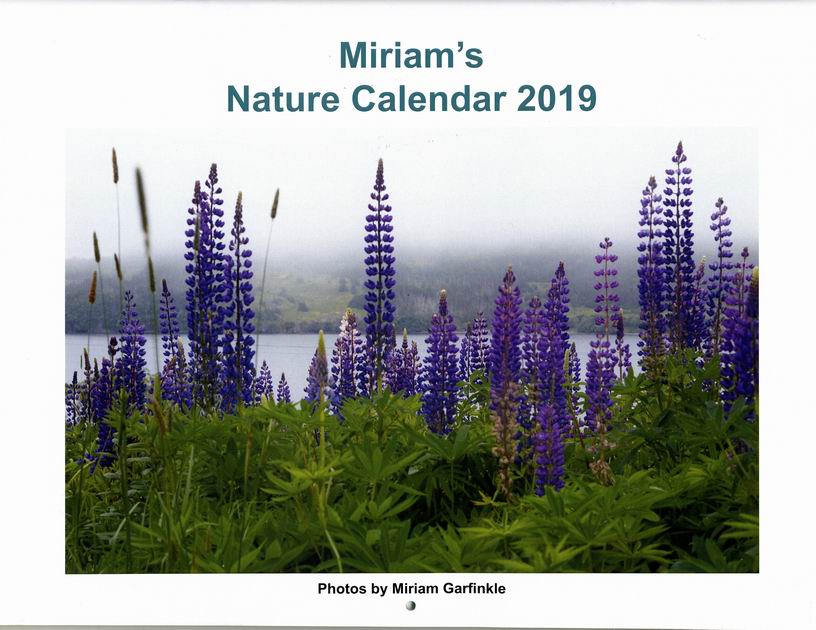
Miriam Garfinkle 1954 - 2018
September 16, 2018
My partner Miriam Garfinkle died on September 15. The obituary I wrote for her appears below. I also delivered a eulogy at her memorial which you can read here.
Miriam died at home, surrounded by the love of her family and friends. Left to mourn, and to cherish her memory, are her partner Ulli Diemer, her daughter Leah, her son Simon and daughter-in-law Melissa, her grandson Ben, sisters Diane (David) and Carol (Johnny), her nieces, nephews, great-nieces, great-nephews, and those she called her “chosen family”.
Her chosen family was large, because she touched so many lives: Smadar, Reem, Miriam M., Peggy, Judy, Sini and Kai especially were like family in every sense, and many others were deeply woven into her extraordinary network of relationships.
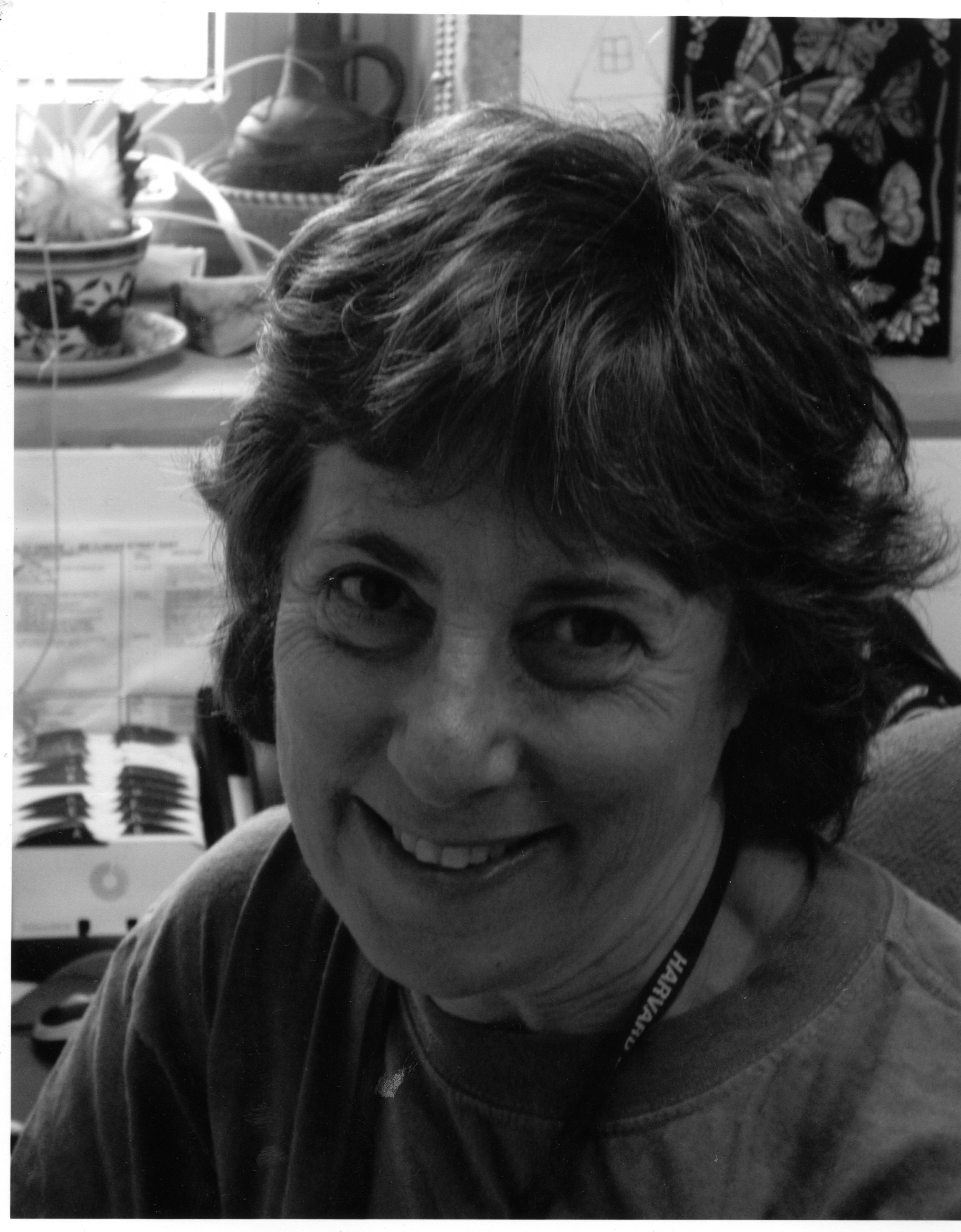
She was an amazing mother to Simon and Leah, and she watched their progress in life with pride and devotion. In her last 18 months, it gave her great joy to see her grandson Ben blossoming into the world.
Dr. Miriam, as she was known to her patients, practised medicine in Toronto for more than 30 years. As a physician, she engaged with her patients in a way that went far beyond the provision of clinical services. She was a doctor who would make a ‘house call’ on a homeless patient in the park where he lived, head out without her coat in the middle of winter to find a patient having a mental health crisis, or drive twenty kilometres to the home of a patient who didn’t have a phone when she received a lab result that needed immediate action.
Miriam spent many years working at the Immigrant Women’s Health Centre and at the Regent Park Community Health Centre, where she was known, not only for her conscientiousness and compassion, but for her sense of humour and infectious laugh. Her concern was not only for her individual patients, but for the social conditions that lay at the root of many of their problems. On her own time, she fought for an increased minimum wage, lobbied for better funding for reproductive health care for immigrant women, and occupied a cabinet minister’s office to demand full funding for health care for refugees.
Her activism went far beyond issues related to health care. Raised in a left-wing secular Jewish family, she was eight years old when she wrote her first political letters, to U.S. President Kennedy and Soviet Premier Khrushchev, asking them to stop testing nuclear bombs. As she told them, “I am sure me and everybody else will appreciate it.” When she was fourteen, she spent Saturday afternoons leafleting outside her local supermarket in support of striking farmworkers.
The cause of the Palestinian people was central to her political activism. As a Jew, she felt a special obligation to speak out about this and to say “Not in my name.” She saw the parallels between the oppression of Palestinians and the oppression of indigenous peoples in Canada, and she spoke up often for indigenous rights.
What tied her diverse involvements together was a fierce commitment to justice, to doing what was right. She was a committed socialist who was enraged by injustice and never wavered in her belief that the world had to rid itself of capitalism and replace it with a new society based on justice and grassroots democracy.
Befitting someone who was a force of nature, Miriam was happiest when she was out in nature, be it in Toronto’s High Park, Pukaskwa on Lake Superior, or Gros Morne in Newfoundland. Famously impatient with urban annoyances like traffic jams (she would get off the bus and walk rather than sit in traffic), she could spend hours in the woods watching and listening to birds and frogs. At home she was often outdoors gardening, or trying (always failing, but never giving up) to find a foolproof way to keep squirrels and raccoons from raiding her bird feeder.
Perhaps her greatest loves in life were music and dancing. She played piano, guitar, banjo, and sopranino, and she danced at every opportunity, be it at a “mug-up” in Newfoundland, a folk dance in the park, or dancing with Ulli in her own kitchen.
Whatever she did, she did with passion and a sense of joy. She will be missed, but those who lives she touched will remember her for as long as they live.
Interment was at the Necropolis Cemetery. A memorial gathering to celebrate Miriam’s life was held on October 28, 2018, at 918 Bathurst Street in Toronto, with about 300 people in attendance. I delivered a eulogy, which you can find here.
Memories of Miriam, and tributes to her life, can be found on the Moments with Miriam page: HTML — PDF. A collection of Miriam’s articles, interviews, talks, letters, activism and photos can be found at www.diemer.ca/Miriam/.
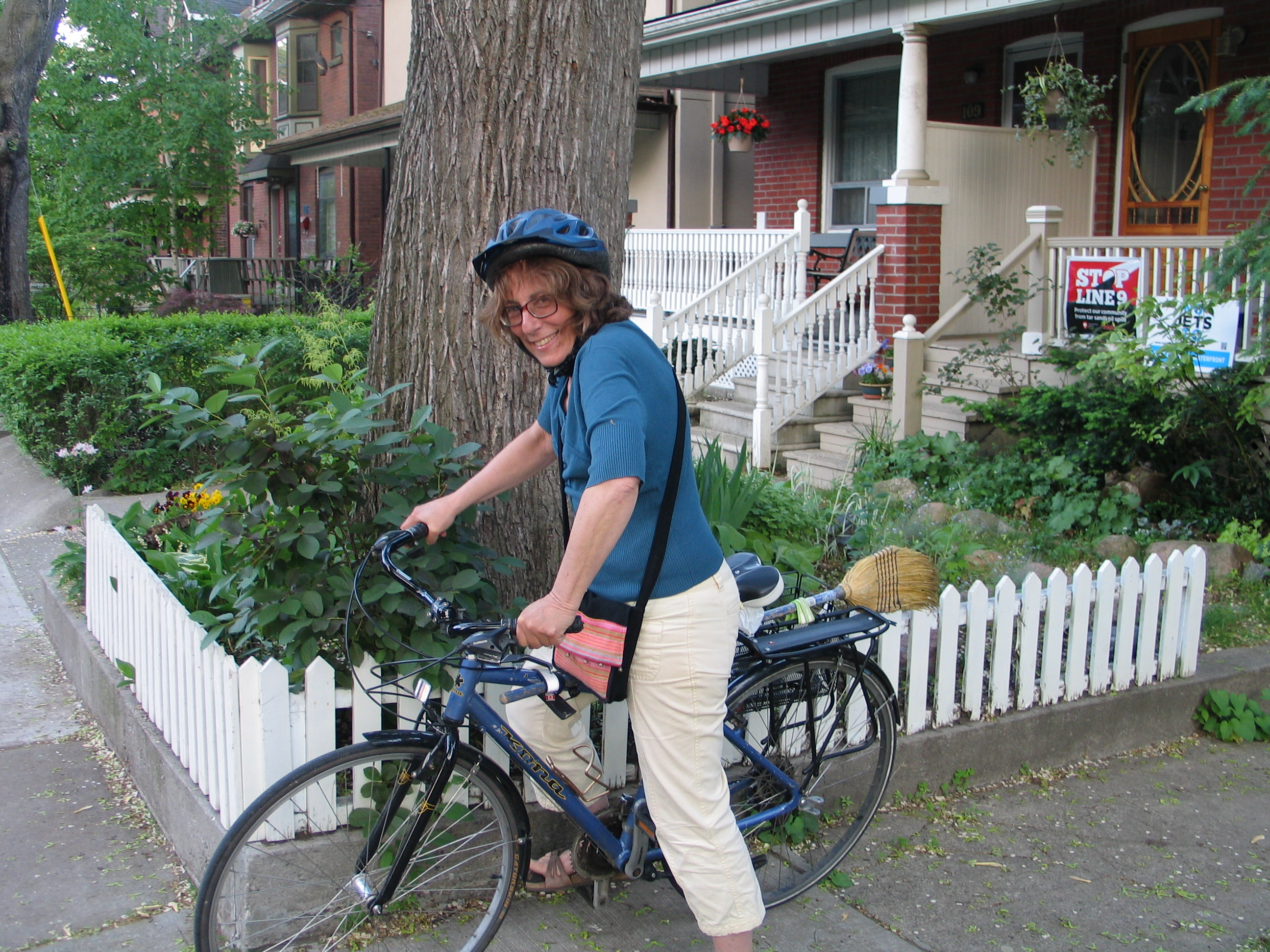
Massacres and Morality
June 10, 2018
As long as there have been states and armies, there have been massacres. In previous centuries, these were openly acknowledged for what they were: acts of terrorism against those who resisted their rulers or their conquerors, or those who seemed likely to resist in the future. Terrorism was understood by all to be what a state did to keep subjugated populations in line, at home or abroad.
In the modern era, however, rulers of the major colonial powers were confronted by working class struggles in their own countries, including struggles for democracy, at the same time as they were faced with the need to put down the resistance of colonized peoples against their colonizers.
Democracy, even in its limited parliamentary form, was seen as a terrible threat. The British ruling class never forgot that Parliament had tried and executed the king, Charles I, in 1649. The French never forgot that the Revolution had beheaded Louis XI in 1793.
In this new and dangerous world, shaping public opinion became increasingly important for those in power. If the people were going to be allowed to vote, then they had to be made to believe in the legitimacy of the existing social system, and ideology and propaganda are more effective tools for doing this than naked force. In the context of colonialism, the public at home, and the officials and soldiers who imposed their rule on the colonies, needed to be told that what they were doing, no matter how brutal, was done in the interests of defending Western values and Western civilization. In the colonies themselves, it was desirable to persuade the elites, at least, that they too would benefit from colonial rule, which, after all, was bringing them the benefits of Western civilization.
The problem with propaganda, however, is that it is often starkly at odds with reality. When people don’t buy into the lies they have been told, they can become dangerous.
And so, all too often, it seems that defending civilization requires massacres.
Hearts and Minds: How Do People Change? Other Voices – February 17, 2018
February 17, 2018 - #
If we want to change the world, we need other people – millions, eventually hundreds of millions of others – to agree that the world needs changing and to join us in changing it.

It’s a daunting prospect. How can we reach and persuade those who may have voted for the likes of Donald Trump and those like him in other countries, or who are not interested in engaging in ‘politics‘ at all?
Many on the left practise their own version of political disengagement. With the best of intentions but questionable priorities, they reach out to the already converted to organize actions which bring together the same small groups of people to proclaim their principled dissent from the status quo. What is all too commonly missing is any attempt to reach out to the vast majority of the population, those who won’t come to, or ever even hear about, the protests of the left.
How can we reach the millions we need to reach and engage if fundamental change is to happen? How can we accomplish the essential task of persuading a majority of the population that a fundamental social and economic transformation is necessary?
Even more importantly, what will it take for people to come together and act collectively to bring about that transformation? What can we do to help make this happen?
This newsletter presents a number of approaches to answering this crucial question. At heart, though, they share the same fundamental wisdom: you do it by talking to people. One-on-one, or in small groups. And talking to people, having conversations, means listening and asking questions. A good organizing conversation, says Jane McAlevey, is 70 per cent listening and 30 percent talking. The key to canvassing people door-to-door, says Momentum, is asking people what they are concerned about, and listening to their answers.
There is another crucial element to this approach: it means talking to strangers. People you don’t know, people who aren’t political. On their doorsteps, on the street-corner, in front of public buildings.
While every conversation we have can potentially have an impact, to be effective in bringing about social change, such conversations need to be part of a strategy for organizing. Groups working for change need to prioritize organizing that reaches out to people, ordinary people, where they work, live, shop, and play.
Finally, we need to understand that having conversations and listening to people is not a mere tactic, a technique to get them to listen to what we have to say. Listening to people means hearing what they say, and learning from it. We don’t have all the answers. We have much to learn, and we have to be open to learning. It is not only other people, but we too, who need to change if the world is to change.
See the February 17 issue of Other Voices here. Sign up to receive Other Voices by email here
Keywords: Community organizing – Compassion – Empathy – Grassroots Campaigns – Kindness – Labour Organizing – Left-Wing Politics – Listening – Organizing – Transformation

A puzzling moment in the park
February 14, 2018 - #
A woman is playing with her dog. It’s a friendly tail-wagging German Shepherd, excited by their game of fetch, tugging on the stick in her hand, impatiently waiting for the next throw.
“When you start approaching the final stages,“ she tells it, “you start to lose focus, and that’s when you get into trouble.”
I’m bemused. I know that German Shepherds are quite intelligent, but even so this seems like awfully sophisticated feedback to be giving a dog. And anyway, the dog seems very focused indeed.
The woman continues speaking. I realize that she talking to someone on the phone. Presumably not a dog.
The German Shepherd runs happily after the stick, and I too trot on my way.
Collective Memory and Cultural Amnesia Other Voices – December 17, 2017
December 17, 2017 - #
The December 17, 2017 issue of Other Voices, the Connexions newsletter, focuses on Collective Memory and Cultural Amnesia.
Our society is obsessed with the short-term present. It devalues memories and the past. That’s the nature of capitalism, especially the speeded-up hypercapitalism of today. The past is useless: profits are made by getting rid of the old and replacing it with something new.
Certainly this applies to commodities, which, as Marx taught us, are both the incarnation of value under capitalism, as well as the embodiment of capitalist values. Commodities (whether or not they take a physical form) have to be destroyed or made obsolete so that new commodities can be sold.
The need to eclipse the past also applies to ways of living. For the sake of increased profits, steady jobs have to be eliminated and replaced with precarious work. Unions have to be ground down and where possible destroyed. Farmers practising traditional agriculture have to give way to industrial farming, or be forced off their land. Culture has to be packaged as a product so it can be bought and sold.
This ceaseless enterprise of social engineering works best if people can be made to forget that things once were different. Collective memories of unionized jobs with benefits, air you could breathe and water you could drink without being poisoned, times when you could live your life without being spied on by the government and the corporations – such memories are dangerous. It’s best if people forget that such things ever existed.
Even more dangerous are collective memories of resistance – times when people got together, and fought for their rights, sometimes winning, sometimes losing. The very idea that things were different in the past, and could be different in the future, is perilous because it gives people dangerous ideas.
Official society, including the mainstream media, busily carry on their daily work of fostering social amnesia, focusing on the present and the trivial, while erasing the past by misrepresentation or neglect. Certainly neither media nor governments have any interest in having people remember the lies that were used to justify past wars and past crimes. Recycled lies (including promises of a better future) work best if people don’t remember how often the same false tales have been told in the past.
But there are those who do remember, and who work to preserve and share our collective memory. They do their work for different reasons, in different places.
Sometimes the impulse is nationalist or even racist. Those who live on conquered or stolen land rarely care to remember much about how the land came to be theirs. They prefer collective myth to collective memory.
But they have to contend with the collective memories of those who were displaced. From Canada to Palestine, from South Sudan to Burma, people are working to document their stories and bring them to the attention of the world. In such instances, and others, the burning impulse is truth: to tell what happened to us.
Other initiatives and projects – Connexions itself is an example – see historical memory as a way of contributing to the struggle for a different world. For us, knowledge of history is subversive, and remembering can be a form of resistance. To understand how we can change society, we have to understand it. That means understanding where it – where we – came from.
When we know and understand more about those who came before us lived and fought, we can gain a deeper understanding of how we can best live and fight.
In this issue of Other Voices, the last of 2017, we share some stories about people's struggles to use collective memory as a form of resistance and a tool for creating a better world.
See the December 17 issue of Other Voices here. Sign up to receive Other Voices by email here
Keywords: Collective Memory – History – Left History – Memory – Oral History – People’s History
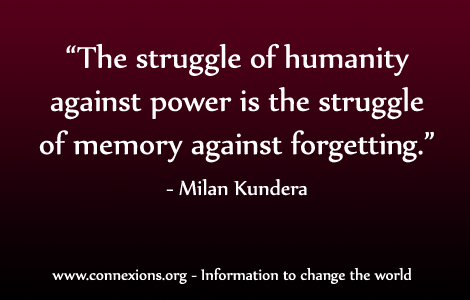
Left parties Other Voices – November 11, 2017
November 11, 2017 - #
“There is no alternative.” That is capitalism’s message in the neo-liberal era. The rich keep getting richer and richer, millions of people are unemployed, millions more are trying to survive on precarious, marginal, and part-time work, hundreds of millions are without health care, housing, education, or clean water. Environmental collapse is increasingly likely, masses of people are fleeing wars and economic disasters, nuclear war is a real danger. And all that the corporate elite, the corporate media, and the mainstream political parties have to offer is their insistence that there is nothing we can do about it: there is no alternative.
In those countries where some version of liberal democracy still exists, an ever-increasing percentage of the population has stopped participating in elections where none of the parties offer an alternative. The parties that used to offer something for working people – the various versions of social democracy – have been absorbed into the neo-liberal consensus, and where they form governments, alone, or in coalition with other neo-liberal parties, they enforce the same neo-liberal program.

The political vacuum left by the mainstream parties has opened up space for new parties and political movements to emerge on both the right (see Other Voices October 9, 2017 and the left. In recent years, a number of left parties have emerged out of mass movements in countries like Spain (Podemos), Germany (Die Linke), and Greece (Syriza). In Latin America, in the last two decades, left movements or parties have formed governments in Venezuela, Bolivia, Brazil, and Uruguay. In Britain, exceptionally, the emergence of a socialist left has happened within the mainstream Labour Party, inspired by Jeremy Corbyn’s articulation of a socialist vision that has attracted enormous numbers of new members to the party. In the United States, Bernie Sanders’ campaign also showed that a politician who calls himself a socialist can inspire millions of people, though Sanders’ insistence on channelling their energies into the Democratic Party undermined the possibilities for a new political movement that his campaign could have opened up.
What these new left parties/movements have in common is a strategy of engaging in grassroots organizing and also running in elections. They all describe themselves as socialist, though in many cases their programs are more reminiscent of what social democrats used to advocate decades ago: reforms that would tame and manage capitalism rather than abolish it. Their ultimate vision may be a world without capitalism, but their immediate proposals are more modest and incremental, though still significantly to the left of the neo-liberal consensus.
The ambiguities and contradictions in their goals are in large part attributable to the fact that, being based on social movements, they are therefore coalitions incorporating diverse points of view, some radical, some less so.
A second tension is one that emerges in every leftwing political movement that engages in elections. Those who are elected to office, and the party/parliamentary apparatus that surrounds them, are almost inevitably absorbed into the narrow world of elections and parliamentary politics. This is all the more true if a left party manages to attain office.
Indeed, the experience of the left parties to emerge in the last two decades shows that the real test, and the real danger, comes when a left party forms a government, or becomes part of a coalition government.
A coalition by definition requires the parties participating in it to sacrifice parts of their programs. When a socialist party enters a coalition with a non-socialist party, it is always on the basis that the socialist parts of its program are set aside in exchange for including some of the specific reforms it wants in the coalition government’s agenda. The prospect of achieving a share of political office in a coalition can be extremely tempting, but for a left party the result is almost always a political disaster.
The dangers and challenges of achieving office are most starkly posed when a left party comes to power in its own right. Being in government is not the same as being in power, as it soon comes to learn. Real power is wielded by the capitalist class, those who control the levers of finance. When they don’t like the results of an election, they move their money out of the country, and international money markets institute a de facto boycott of the disobedient country. International institutions, such as the European Union and the International Monetary Fund, as well as the biggest and most powerful international institution of all, the American Empire, bring enormous pressure to bear. In this, they have the help of a ‘fifth column’ within the country: the corporate sector (including the corporate media), as well as significant parts of the state apparatus, such as the senior bureaucracy, the police, and the military.
If a left party is to have any hope of surviving and carrying out its program, it has to have a clear understanding of the obstacles it will face, and a strong determination to meet them head on. Even more importantly, it can only succeed if it remains the expression of a broad-based social movement. An isolated left government has no chance. A movement of millions of people which is committed to an ongoing process of social transformation can sustain a left government, even as such a government can help to achieve the goals of the movement.
See the November 11 issue of Other Voices here. Sign up to receive Other Voices by email here
Keywords: Left Parties – Bolivarian Socialism – British Labour Movement – Political Alternatives – Strategies for Social Change – Syriza
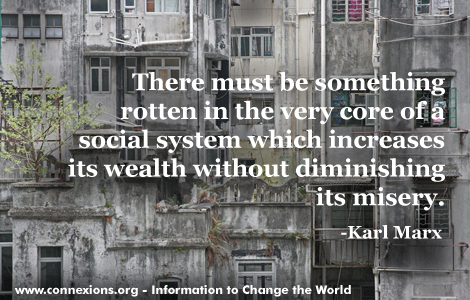
Meeting the Challenge of the Right Other Voices – October 9, 2017
October 9, 2017 - #
The October 9 issue of Other Voices focuses on the challenge of meeting the Right.
When we talk about the Right, it is well to keep in mind that “the Right” is by no means a unified political force or organization, but rather a label used to describe a disparate collection of ideologies, parties, groups, and individuals.
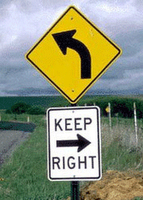
Many of the mainstream political parties which hold government office or form the official opposition in countries such as Germany, Britain, Denmark, the Netherlands, and Canada carry the label ‘conservative,’ meaning that they are on the right of their country’s political spectrum. In most of these countries, little distinguishes these parties from the mainstream parties to their left. If the programs of the conservative parties typically call for austerity and cutbacks in public spending, coupled with more tax breaks for the rich, the programs of their more ‘progressive’ opponents will tend to call for a little bit less austerity and slightly smaller tax breaks for the rich. These parties have been following the same neo-liberal template for decades, and as the failure of neo-liberalism to improve the lives of anyone except the wealthy has become increasingly apparent, they have steadily lost support.
The hegemony of the virtually indistinguishable mainstream parties has been challenged by the emergence of hard-right parties in places such as India, Ukraine, Hungary and Poland (countries where they hold power), in France, where the National Front has become a major political force, and in Germany, where the anti-immigrant AfD finished in third place in the recent national election. With millions of people unemployed or working in marginal precarious jobs, desperation and hopelessness is leading some to listen to right-wing demagogues who offer scapegoats – usually immigrants or other minorities – or who divert their attention to social ‘evils’ such as abortion, homosexuality, and sex education. These far-right parties in fact have no real solutions to offer, but they pose a very real danger to those they target as scapegoats.
Further still to the right are a wide variety of groups and movements that openly flaunt racist and Nazi symbols and rhetoric. These groups and individuals, who have been given the name ‘alt-right’ in the United States, are by no means united, and their numbers are small, but they have shown that they are quite capable of committing serious acts of violence against those they hate. They have been challenged by anti-fascists who work to stop fascists in their tracks whenever they seek to march in the streets.
The strategy and tactics of meeting the challenge of the right are naturally subjects of debate. Those activists who identify with the label ‘anti-fa’ tend to focus their energies on trying to stop fascists from marching. Important as this is, it can also serve to divert energies from the important organizing that needs to be done. The real problem, arguably, is that the right – the more mainstream right as well as the fascists – has succeeded in attracting support among the broader population because they are putting their energies into grassroots political organizing, while much of the left has given up on organizing, or even talking to, ordinary working people.
The emphasis on fascist fringe groups also can lead to ignoring the most dangerous anti-democratic forces. The greatest totalitarian threat comes, not from small fringe groups, but from the state’s security apparatus itself: the police and the myriad agencies that monitor and record everything that we say and do. They are the ones who driving the push to ever-increasing police militarization, surveillance, and restrictions on civil liberties in the name of ‘anti-terrorism.’
See the October 9 issue of Other Voices here. Sign up to receive Other Voices by email here
Keywords: Anti-fascism – Anti-racism – Fascism – Hate – Nazi History – Police State – The Right – Strategies for Social Change – White Supremacy
Official Enemies Other Voices – August 27, 2017
August 27, 2017 - #
The August 27 issue of Other Voices looks at Official Enemies.
We are never left in any doubt about who our enemies are. The word goes out from the United States that a certain country is a dictatorship which abuses human rights, supports terrorism, and poses a terrible threat to the U.S. and to the world. The mainstream media then swing into action with military precision and flood us with stories, images, and commentary about how dreadful country ‘X’ is. The U.S. and its client states – also known as its ‘NATO allies’ – then move into action with a standard package of sanctions and forms of pressure, which may include economic warfare, military threats, and measures to lay the groundwork for a coup via clandestine contacts with opposition leaders and those elements of the military command who have been on the CIA payroll for years. When regime change is the goal, any method, from buying an election to military invasion, is acceptable.
There is also no doubt that ostensible reasons for branding a country as an official enemy are never the real reasons. One clear indication of this is the way a particular leader or government can be an ally one day, and an enemy the next. Saddam Hussein’s Iraq was an American ally, showered with favours and military hardware, until the day Saddam disobeyed the U.S. and took over the Kuwaiti oil fields. Suddenly the U.S. discovered that Hussein was a dictator who didn’t respect human rights, and invaded Iraq. It was a similar story in Panama, where President Manuel Noriega, a brutal thug and known drug dealer, was a trusted U.S. ally who was on the CIA payroll for years. When Noriega got too greedy and started stealing from U.S.-owned businesses, the U.S. invaded and overthrew him, killing a few thousand people in the process. It was a similar story with Assad’s Syria, which served the U.S. as a clandestine location to which it sent prisoners to be tortured (e.g. Canada’s Maher Arar). When its strategy in the Middle East changed, the U.S. suddenly discovered the Assad was a nasty dictator who tortured his enemies, and who had to be overthrown.
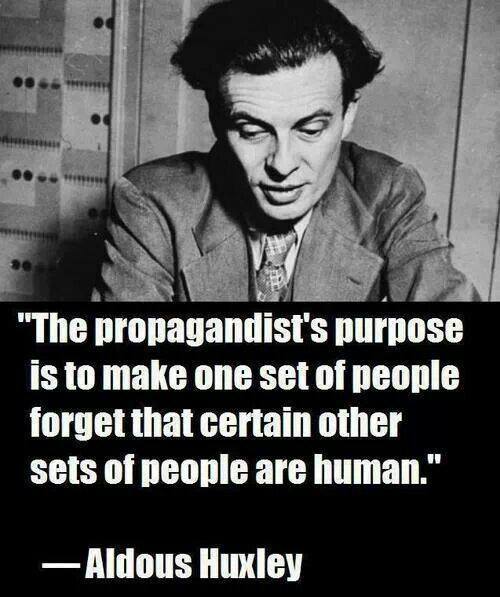
The standard pretexts for demonizing a particular country would be laughable if the results weren’t so grim. For example, the U.S. government and the house-trained media which spread its message would have us believe that Venezuela, a country which regularly holds internationally monitored, closely contested, elections, is a dictatorship which needs to be overthrown, while countries like Egypt, Israel, the Philippines, and Saudia Arabia, whose jails are overflowing with political prisoners, are stalwarts of the free world.
In this issue of Other Voices, we go beyond the mainstream media to look at the complex realities and histories of the current group of official enemies: Venezuela, North Korea, Syria, and Russia. These articles don’t suggest that there is nothing to criticize about these states. There is no doubt that North Korea and Syria, for example, are brutal dictatorships. It is nevertheless possible, as one article suggests, that many people in Syria, faced with the stark choice of a secular dictatorship or rule by the Islamic state or Al-Qaeda, would choose the existing state. North Korea may be a dictatorship, but its international policies have a core of rationality: asking for negotiations and guarantees on non-intervention, while maintaining a military strong enough to deter an American attack.
The ultimate conclusion these articles point to is this: war is not a solution, and U.S.-NATO intervention in other countries invariably makes things worse.
See the August 28 issue of Other Voices here. Sign up to receive Other Voices by email here
Keywords: Intervention – North Korea – Media Propaganda – Regime Change – Russia – Syria – United States Foreign Policy – Venezuela – War Propaganda
Secrecy and Power Other Voices – July 22, 2017
July 22, 2017 - #

The July 22 issue of Other Voices focuses on the relationship between secrecy and power.
It is one of the essential attributes of power that it insists on secrecy. Or, more precisely, those who wield power over others routinely claim that the details of what they do, and why they do it, are far too sensitive to be revealed to the public. The decisions they take, the discussions they have, the information they consider, the lobbyists who influenced them: all this must remain behind closed doors. Terrible (though unspecified) calamities would result if their jealously guarded secrets were to be revealed.
Self-serving as this view may be, it contains an important germ of truth. It is a defining characteristic of almost all bodies that wield power – governments, public agencies, courts, police, corporations – that they view the people they ostensibly serve as the enemy. If the public finds out that they are seen as the enemy, the interests of the power-holders could indeed be harmed. Having their secrets exposed to the public is seen as an existential threat, and is met with fury: witness, for example, the extraordinary vindictiveness which the American state directs at whistleblowers like Edward Snowden, Chelsea Manning, and Julian Assange.
It is on the level of national security that the cult of secrecy is most apparent and most pathological. It is also on this plane that the distinction between secrecy and privacy is clearest.
Privacy is something that belongs to individuals. It is the right to go about one’s business without being spied on by the state or corporate entities. Governments and corporations hate the idea of privacy, and do everything they can to deny anyone, anywhere, the right to privacy. They suck up information, all kinds of information, anything and everything, and trade it like a commodity.
Secrecy, on the other hand, is a weapon used by the state and other wielders of power against the public they ostensibly serve. Whereas everything that every member of the public does must be subject to surveillance by those in power, everything important done by those in power must remain a secret.
The same attitudes are prevalent wherever power is wielded. Far-reaching international agreements, such as the so-called “free trade” deals, are always negotiated in secret. Pesticides and other chemicals are routinely approved on the basis of ‘evidence’ which can’t be revealed because it is a trade secret. On those rare occasions where corporations are successfully sued by those they have harmed, the actual settlement is concealed behind a court-imposed non-disclosure clause, so that others can’t take advantage of the precedent. International financial agreements have been carefully crafted to allow the wealthy to move and hide their money to avoid paying taxes. Trials of those accused of crimes against the state are held in secret; sometimes those taken into custody are held in secret prisons without even the benefit of a trial.
One of the paradoxes of the cult of secrecy, as it pertains to national security, is that very often it doesn’t work. Security agencies, with their thousands of employees and their billions of intercepted communications and storehouses full of secrets, routinely fail to foresee events which journalists and ordinary observers on the ground see, analyze, and understand without access to any secret information.
But then, it would be naive to think that the goals those in power claim to be pursuing are their real goals. Wars are profitable. Trade deals are profitable. Toxic chemicals are profitable. Keeping the real enemy – the people – from interfering is essential. And therefore, so is secrecy.
In this issue of Other Voices, we shine a light on the relationship between secrecy and power.
See the July 22 issue of Other Voices here. Sign up to receive Other Voices by email here
Keywords: Secrecy – Power – Corporate Power – Bureaucracy
Race & Class Other Voices – February 12, 2017
February 12, 2017 - #

The theme of the February 12, 2017 issue of Other Voices is Race and Class.
Class conflict – first and foremost, the relationship between the capitalist class and the working class – is the fundamental contradiction that defines capitalist society. Class is a reality which simultaneously encompasses and collides with other dimensions of oppression and domination, such as gender and race. The relationship between race and class, in particular, is the theme of this issue of Other Voices.
The concept of “race” is a relatively recent invention, born out of the need to invent a justification for the enslavement of black Africans. Race theorists developed pseudo-scientific biological theories to ‘explain’ why Africans were ‘inferior’ and therefore could justly be enslaved. Race theory was then also used to justify and explain social hierarchy in other contexts. It is worth remembering that conservative European social thinkers long held that working people and the poor belonged to a biologically different ‘race’ than their social superiors. The French aristocrat and race theorist Gobineau wrote “Every social order is founded upon three original classes, each of which represents a racial variety: the nobility, a more or less accurate reflection of the conquering race; the bourgeoisie composed of mixed stock coming close to the chief race; and the common people who live in servitude or at least in a very depressed position. These last belong to a lower race which came about in the south through miscegenation with the negroes and in the north with the Finns.”
It was in the Americas, and especially in the United States, a society founded on slavery, that ’racial‘ divisions were cultivated and sharpened to their highest degree. After Bacon’s Rebellion in 1676, when black slaves and white indentured servants rose up together, the colonial elite began consciously to foster ‘racial’ divisions by granting poor whites a few social privileges (but not, in most cases, money or power). Immigrants who had been considered non-white and racially inferior, such as the Finns, the Irish, and Slavs from Eastern Europe, were ‘promoted’ into the “white race.”
In the eyes of Karl Marx, the division between whites and blacks within the American working class (which in his analysis encompassed slaves as well as wage-workers) was the fundamental contradiction which stood in the way of developing class consciousness and creating a socialist movement.
In the 20th century, Communists and Trotskyists in particular stressed the central importance of challenging racism in order to build a united working class movement. In the last few years, this insight has been carried forward by other social movements. The concept of ‘intersectionality’ has recently come into vogue in some circles, though others argue that ‘intersectionality’ is actually a step backward in that it assumes that there are separate ‘identities’ that ‘intersect’, an approach which can end up seeing the differences but missing the whole.
These are questions which will continue to challenge us. In this issue, you’ll find a small selection of resources from a vast and ongoing social movement. Exploring the subject links below each item will lead you to many more.
See the February 12 issue of Other Voices here. Sign up to receive Other Voices by email here
Keywords: Race & Class – Anti-Racism – Black Liberation – Caste – Class Solidarity – Identity Politics – Inequality – Social Determinants of Health – Working Class
Disobedience Other Voices – January 22, 2017
January 22, 2017 - #
The theme of the January 22, 2017 issue of Other Voices is Disobedience.
Ultimately all power structures depend on the obedience of those over whom they rule. It helps if people believe in the legitimacy of those who wield power, but the crucial thing is obedience.
Once people start to disobey in significant numbers, the dynamic of power changes fundamentally. Disobedience, especially on a large scale, shakes the power of the rulers, and increases the power of those who disobey.
Given the nature of state power, the most threatening form of disobedience is the refusal of soldiers to obey orders. In this issue, this is the form of disobedience we focus on. When soldiers begin question the orders they are given and start regarding the authority of those who give those orders as illegitimate, the military hierarchy, and ultimately the state itself, are threatened.
In this issue of Other Voices, we recall the resistance of rank-and-file American soldiers to the Vietnam War. This resistance was a powerful factor in ending the war, probably second only to the indomitable determination of the Vietnamese to drive out the American invaders. Yet the soldiers’ resistance has been virtually erased from history. Hollywood has made hundreds of movies about the war; none shows the actions of thousands of American soldiers who refused to fight. Their resistance included not only desertion and combat refusals involving thousands of soldiers, but hundreds of instances of GIs killing their own officers when those officers tried to compel them to go into combat.
We also feature an article on rank-and-file soldiers in the Egyptian army. Virtually all of them come from the working classes, and their loyalty to the regime cannot be taken for granted. If they refuse to continue obeying a hierarchy that has soldiers repressing their own people, Egypt’s dictatorship will face a crisis.
From the Archives we feature the Principles of Nuremberg, which were used by the Nuremberg Tribunal to judge Nazi war criminals. These principles were subsequently adopted as key elements of international law. The fourth principle states “The fact that a person acted pursuant to an order of his Government or of a superior does not relieve him from responsibility under international law, provided a moral choice was in fact possible to him”. This principle makes clear that under international law, an agent of the state, including a soldier, has a duty to refuse orders that violate international law. We would do well to highlight this duty at every opportunity.
Also in this issue: an article about strikes and other forms of resistance by prisoners and by immigrant detainees: another form of disobedience against the repressive power of the state.
Other articles look at recent worker’ struggles in China, and recall the life of John Berger, the British critic and writer who taught many about different “ways of seeing” the world.
To read Other Voices online, go to https://connexions.org/Media/CXNL-2017-01-22.htm. You can subscribe to the email version by sending a request to mailroom@connexions.org.
See the January 22 issue of Other Voices here. Sign up to receive it by email here
Keywords: Civil Disobedience – Desertion – Disobedience – Mutinies – Refusing Orders – Soldiers
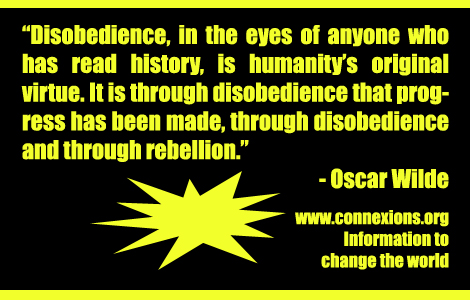
Depression and Joy Other Voices – November 7, 2016
November 7, 2016 - #
It’s a difficult thing to measure, but there are strong reasons for believing that the number of people struggling with depression has increased significantly in recent decades. Despite the evidence that this is a social problem, and not merely an individual misfortune, the solutions and escapes on offer are almost all individual: pharmaceuticals and therapy, on the one hand; self-medication with alcohol, streets drugs, television, etc., on the other.
Certainly there are individual circumstances and individual causes, but when millions of people are experiencing the same thing, we need to be looking not only at the individual, but also at the society. Many of us feel powerless in the face of economic decline, a burgeoning police state, a ruling class willing to risk all-out war to increase its wealth and power, and the growing likelihood of environmental catastrophe. Many of us also struggle to bring about a radical change of direction, but you’d have to be oblivious to reality to wake up each morning feeling cheerful and optimistic.
But while the circumstances, and the odds we face, might not be what we’d prefer, nevertheless we aren’t powerless. We can and do act. And through our actions, especially our collective actions, we can experience community, friendship, and moments of joy.
This issue of Other Voices features articles, as well as a book, a film, and a comic strip, which look at depression and also at what we can do in the face of depression and gloom. As always, we try to offer enjoyment as well as gloom.
See the November 7 issue of Other Voices here.
Keywords: Depression - Joy - Collective Joy

